Miss Havisham & Estella Revisited
Sunday, January 31, 2010

In a previous blog I wrote this about my childhood obsession with Estella from Great Expectations.
When I was 6, I fell madly in love with a cold and unreachable Filipina girl in Buenos Aires called Isabel Opisso whom I met in an excursion to Anchorena in the outskirts of Buenos Aires. never saw her again. Like Pip she was in my dreams every night for a long time. A couple of years later our teacher read us Great Expectations in class during a month. I fell madly in love with cold and unreachable Estella.
In Dickens's Great Expectations Miss Havisham (my impression, left) wears only one shoe, because when she learned that Compeyson had jilted her, she had not yet put on the other shoe. When I took this photograph of a friend, an Argentine tango partner, a few years ago I immediately saw Miss Havisham. I wonder where Isabel Opisso might be and if she ever married.
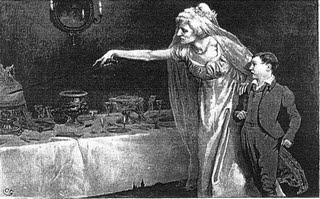
Just a few days ago Rosemary watched (it was our first time) the 1946 David Lean version of Great Expectations. The reason for the airing of the film in the Turner Classics Channel had to do with the recent death of Jean Simmons. It is Simmons who plays the young girl Estella (she was 19) in the film. Both Rosemary and I were disappointed when the older Estella was not Simmons but a toothy Valerie Hobson.
This excellent film reinforced my memory of my childhood awakening into an interest in the opposite sex when I met Isabel Opisso and then discovered Estella in Dickens’ Great Expectations.
In many ways my very own Rosemary after 41 years of marriage sometimes feels like that coldly remote Estella that Jean Simmons so beautifully portrays in the film.
Today we took the children (our grandchildren) to Watermania in Richmond. Rosemary was her usual serious and worry self. But when I told her that there were a couple of hot tubs in between the wave pool, the swimming pools, the diving pools and the water slides she smiled. She doesn’t often smile.

My mother-in-law was sweet and pleasant (no Miss Havisham, was she) but I wonder if she didn’t teach her daughter Rosemary to break the heart of all men.
As I watched Jean Simmons I waited for her voice to break. It never did. Not yet anyway. It was in 1953 that my parents took me to see The Robe at the Cine Gran Rex, on Calle Corrientes in Buenos Aires. In that film Jean Simmons’ voice breaks. It breaks just as the voice of Deborah Kerr breaks. That break in their voice makes them that much more appealing to me. While my mother enjoyed the over the top and miscast performance of Marlon Brando in Desiree my eyes did not stray from Jean Simmons (below as Desiree) for a second. I had yet to discover Grace Kelly, another actress with that kind of a voice. At 12 those voices were appealing because they weren’t aggressive as that of Katherine Hepburn’s. My mother had taken me to see a film with her. I was confused with Hepburn’s low voice and her pants. It was only many years later that I began to appreciate that there were other women besides the ones with voices that broke.

And I as thought of those voices I realized that I can remember the voices of many actors, Herbert Marshall, Stewart Granger, Ronald Colman, Robert Mongomery, Randolph Scott, Lana Turner, Audrey Hepburn (does her voice break just a bit?), Jack Palance, Alec Guinness, Ava Gardner, and just about every actor and actress that is now dead. But I cannot remember, nor could I identify in a recording the voice of Brad Pitt.
According to my friend John Lekich it has all to do in that the actors and actresses of old took voice lessons. Or perhaps I saw so many of their films that the memory has remained to this day.
When Jean Simmons says to Pip (Anthony Wager), “You may kiss me if you like.” I just about died. I was 8 again. I was Pip.
The illustrations here are by Charles Green who was the illustrator for the 1877 edition of Great Expectations.
Vancouver's Vertical Gated Communities
Saturday, January 30, 2010
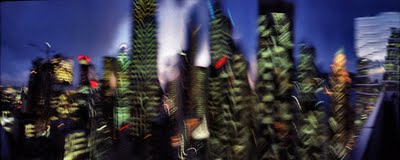
There were the Street People and there were the Air People. Air People levitated like fakirs. Large portions of their day were spent waiting for, and travelling in, the elevators that were as fundamental for the middle-class culture of New York as gondolas had been in Venice in the Renaissance. It was the big distinction – to be able to press a button and take wing to your apartment. It didn’t matter that you lived on the sixth, the 16th or 60th floor: access to the elevator was proof that your life had the buoyancy that was needed to stay afloat in a city where the ground was seen as the realm of failure and menace.
In blocks like Alice’s, where the doormen kept up a 24-hour guard against the Street People, the elevator was like the village green. The moment that people were safely inside the cage, they started talking to strangers with cosy expansiveness. As we rattled up through the floors, it was “Hi!”and “Bye!”and “Where did you get that? I just love it” and “Don’t you hate this weather?”…little trills and squawks of sociability that registered everyone’s relief at having escaped the dreadful flintiness of the subway and the street.
Hunting Mister Heartbreak , Jonathan Raban, 1990, Collins Harvil, London
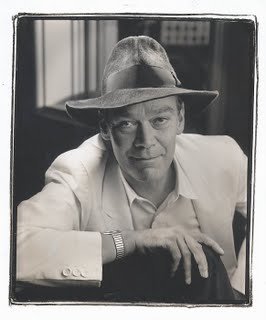
Five years ago I went to Buenos Aires with Rosemary and Rebecca. My nephew Jorge proudly showed me the Catholic barrios cerrados (gated communities always called contrees and pronounced like that!). The idea began some years befored when several families with shared expectations (all white and conservative Roaman Catholic joined forces to buy a large property (in the outskirts) that they would slowly urbanize with electricity, water etc. Walls would be built and houses would follow. My nephew had a contracting company and he made a fortune at this. Soon the gated community would have its little church within its gates. After a few years my nephew had finished quite a few of these. His mother was in charge of landscaping. One of his brothers was helping her with the heavy work of moving and planting trees. Another brother was the firm’s lawyer. Yet another was in charge of publishing a monthly glossy magazine on and about the communities.
The venture became so successful that my nephew travelled to Rome with a well dressed priest (he was Basque and I swear his habit was by Armani) and consulted with a couple of Cardinals who wanted a piece of the pie and so suggested that similar gated communities could be built in the City of Brotherly Love in the United States. I soon found out I could not talk ill of President Bush and gun control in the presence of my pious nephew.
One day having a comfortable lunch in my nephew’s home by an artificial lake he had built within the gated community he lived in, I asked him, “What are you going to do the day, that inevitable day, when the masses climb over your walls?” He beckoned me to follow him into a room. He opened a closet and pulled out a sawed off Argentine Itaka shotgun generally used by the police. From a drawer he removed a Luftwaffe issue Luger pistol and he then said, “I also have a .45 Colt Automatic.” I was speechless but managed to ask, “What are you going to do with these?” “I will target practice.”
The whole affair left me deeply troubled. I have mostly forgotten about it but I sometimes think that my nephew is right when I realize that my two granddaughters are not allowed to either walk to school or to walk back even though they are but a few blocks away. My nephew sends his children to a private Catholic school. They are bussed back and forth. My wife believes that Rebecca and Lauren would be better off in a school like Crofton House or York House. We managed to send our oldest daughter Ale to Yorkhouse beginning in grade 11 when we noticed that her English was spotty and much too slangish. Hilary (our granddaughter’s mother) flatly refused to go to a private school. Now we don’t have the money to help with the granddaughters and their parents would never send them to a private school as they consider them elitist. I am not all that sure as I am the product of private schools.
It was in 2001 that I was taking pictures of artist Alan Storey. I photographed him by his Coopers Mews sculpture. It is a (a whimsical look at what preceded the area(north west side of False Creek) before the condominiums were built. Part of the pathway includes steps that produce steam when one walks on them. He pointed at a nearby baby sitting centre. It seemed odd amidst all the concrete towers.
Storey and I had a fun time during our pleasant shoot. But it was partly jarred by an event that I will not forget. We stopped our picture taking when we saw an extremely beautiful and elegant blue car stop at the gate of one of the condos. It was an Aston Martin being driven by a young man. He glanced in our direction and then the gate went up and he disappeared into his building's garage. We discussed that the kind of luxury that we had previously associated with living in Shaughnessy had a much different counterpart here by his sculpture and that it was a luxury of which we had no inkling. It was a way of life for which we had no understanding.
Today I finally connected the dots in my mind as to what it is that often nags me when I drive my car or take the Number 10 trolley to town and I gaze at Vancouver’s skyline. I went to my library and located Jonathan Raban’s (my snap of him, above right)Hunting Mister Heartbreak (an account of the immigrant Englishman, Raban, travelling around the United States until he settles in Seattle). He begins his story when he arrives by ship to New York (from Southampton, of course!). On page 80 I found what I quote from his book above.
Jonathan Raban’s more exclusive Newyorican Airpeople hardly ever venture from their sky homes. People from the street bring up the food and other required services.
It was from my half-brother’s 18th floor apartment on Avenida Libertador General San Martín, conveniently located near the exclusive shopping centre, Patio Bullrich, that I asked him what were some twinkling lights beyond the tracks of nearby Retiro train Station. “Alejandro,” Enrique explained, “that’s Villa 31 one of the most dangerous villas miseria (shanty towns) in Buenos Aires.” The proximity of Villa 31 to my half-brother’s apartment and my nephew’s comment on the solution to the masses climbing over the fence clicked together today.
Vancouver, as all those head offices, business offices and financial institutions move out of Vancouver, those towers (the Electra Tower and the former Westcoast Energy building are examples) and all the condos that are being built in our city are making it into a vertical gated community. The villas miseria are not yet here. My friend Mark Budgen who lives in Strathcona says that the problems of the Downtown Vancouver East Side will never be solved until the problem is seen as a Canada wide issue. He says that as soon as shelters are built newcomers arrive from Surrey, Alberta, Ontario, Quebec and other parts of Canada. The sprawl of the homeless will continue and soon a few will be recruited to serve those who live up in the towers.
Are we behind New York and Buenos Aires? When will we catch up? Do we want to?
A Photographic Imperative
Friday, January 29, 2010
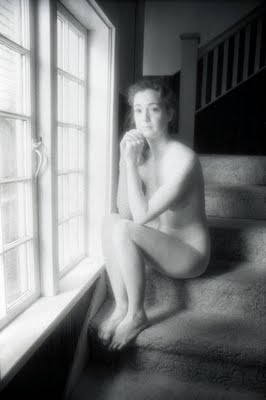
April 17, 2007 I wrote this blog about poet Diana Hayes, right. The blog has been in my thoughts of late. Since sometime in the late 70s I have taken an extraordinary amount of nudes in my studio, in my garden, on mountain locations, in beaches and even in cars.
Except for the few times that I have taken pictures in my garden I have maintained a strict separation of this delicate type of photography from my domestic life. There was one very beautiful model, called Ona Grauer that for some reason Rosemary (my wife) admired and liked. She left me undisturbed when I photographed Ona without a stitch in the garden. Another time when Virve (a.k.a. The Baltic Surprise) was my subject in the garden; Rosemary made it a point to tell me that the phone was for me, with nagging regularity, and would yell out into the garden. What was beneath all this was the idea (one that I find is important) that there had to be an area of our house that was sacrosanct and had nothing to do with my photography. After all, Rosemary would point out the basement was reserved for my darkroom and for my photo files. I worked as freelancer from the phones of the house, including the one in the kitchen.
For many years my studio on Robson Street was a refuge. It was a place I could do my photography. Before the advent of my buying a cellular phone I had no phone in the studio. It was also a neutral place where I could experiment with my lights and my subjects (who were often in the nude). With my letting go of my studio I have found many changes that affect me as I would have never suspected. Our basement has photographic booms, soft boxes, flash power packs and other detritus from my studio.
Should I continue with my nude photography? Is there some sort of photographic imperative that I do so? Should I consider that at age 67 I should be past all this and I should settle down, not get out of bed and just read or putter with my roses while we still live in this house?
I re-read Diana Hayes, A Poet Of Imagination & Daring, surprised that much of what I wrote then I have not wavered in opinion. If anything I feel more resolute. But this resolution is tempered that unless I shoot in the garden in the summer or rent someone else’s studio I am stuck with my living room and dining room. Is this intrusive? Will Rosemary understand? She will mind. That I know. And she will be quiet about it.
My friend Ian Bateson says if I quit my “experimental (i.e. nude)” photography I will die. Is he right?
I remember that in my 40s a topic of conversation that was in vogue began like this, “If I knew what I know now and went back to when I was under 20 I would be unstoppable. Women would fall at my feet.” I wonder if men say this sort of thing now?
It was some 15 years ago that I displayed at an erotic photography show two photographic narratives (6 pictures in a row) that were tight (very cropped) portraits of two different women. Only a few men ever caught on that they were a sequence of these women going through self-induced orgasm.
In the late 70s I would have been too afraid and too shy to ask any woman to undrape for my camera. Fifteen years ago I was taken to task by at least 10 women I knew who were miffed that I had not asked them to pose for similar narratives. In retrospect (with tongue in cheek, not too firmly) I suspect I could have obtained a Canada Council grant on the idea as a project!
While many will cite the atom bomb as the defining moment of the 20th century I believe that the most important event of the 20th century and of most of the other centuries was the 60s introduction of the contraceptive pill. I believe that the pill made woman truly independent. I believe that most of the ethical rules of morality of most religions are there to affirm and to try to assure the all-powerful man that the woman next to him, the pregnant one, is pregnant by him and by no other man. These rules of religious morality were based on a man’s fear of the “soiling” of his possession.
I believe that is only of late that I have located representations of St. Joseph, the Virgin Mary (holding the infant Jesus) where St Joseph is actually leaning his arm or embracing his lawfully wedded wife. For many centuries she was the super woman and Joseph was the inferior man. He was a man of patience who could take all the jokes that were thrown in his direction. Most gospels and theologians try to dispel the idea that St James might just be the younger and real brother of Jesus. Would this make the Virgin no longer a virgin? We men have bee too obsessed with this concept of virginity.
But there were always vestiges of the idea that we men were direct, boringly direct in what we wanted from women. Women were coy, indirect and somehow at a higher plane of sexual consciousness.
That idea was in my head for years. I would photograph women in my studio and some of them after some frustration would say, “Alex, you want me to take it all off. Why don’t you just ask?”
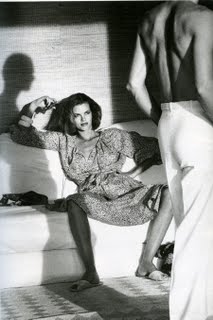
For me it all began to change when I received that phone call from poet Diana Hayes in 1981(see above link). Then in 1987 I bought a little photo book called Helmut Newton (Pantheon Photo Library). There was a picture reproduced here with the title Vogue (USA), 1975 Saint-Tropez, Calvin Klein. In this photograph I saw the woman I had begun to suspect was the real woman, a woman no different from us men.
I have been thinking about Diana Hayes as I wrestle with the idea of taking more pictures of “this sort”. I began this past Monday with some living room pictures of Anita (the woman from Prince George). I did not use a big camera but instead opted for my Nikon. I used almost no artificial light. The next step would be to continue with better lighting and a bigger camera. I wonder if I will continue. Is it truly an imperative?
Before Anita left she told me how she liked being photographed in the nude. I countered by telling her that in other times she would have been called an exhibitionist. Is that word still in circulation? But we did agree on one thing that for every man that wants to paint, draw, photograph and sculpt the nude female body, there is a woman out there who has that same reciprocal imperative - to pose undraped.
Perhaps Ian Bateson is right. If I quit I will end up in the loony bin more quickly.
The Simple Things In Life & A Manzanilla Papirusa
Thursday, January 28, 2010

Yesterday I attended an informal gathering at the Irish Heather on Carrall Street. The occasion was the visit to Vancouver of our friend Chandler Keeler. He now lives in the south of France. He wears a beret and has become pleasantly Frenchified. He has had an idyllic existence of taking pictures, eating good French food and sipping on good wines. In Vancouver Chandler used to run one of the best Ektachrome development labs in Vancouver called Quad. If any of us considered ourselves to be serious professionals we gave Quad our business. I gave Quad my business. When things started changing with the advent of digital technology Chandler saw that a warmer climate elsewhere might just be his ticket.
His peripatetic life in France was shattered by the shocking news that he had cancer of the esophagus. Chandler was pleasantly surprised (under the terrible circumstances) that the French Government was going to do all possible to help him as if he were a citizen of the country. The prognosis for Chandler is still in question.
On Monday Chandler dropped in. While savouring a half bottle of Lustau’s Manzanilla Papirusa ( a very dry sherry that hails from San Lucar de Barrameda in Spain) Chandler matter of factly informed us (Rosemary, Lauren and Rebecca) that he was in town to close his safety deposit box and deal with his will. I was afraid to ask. Chandler looked very good (he is a handsome man of the urbane type). He looked just as good at the Irish Heather where we met with veteran (in all the meaning of that word) photographers Hans Sipma, Colin Goldie and Mike Paris. We had a few beers and chatted about the whereabouts of other photographers of our generation.
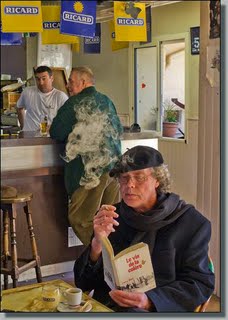 It was last night that I found out that I had an unpleasant reputation that preceded me. It seems I have been a ranter all these years. Those present at the Irish Heather seemed to notice that something had changed. I promptly showed them my Timex that was strapped to my right wrist. I changed its location in the beginning of the year vowing to be kinder, gentler and less inclined to rant. My Irish Heather companions were disappointed but as soon as any others had the opportunity to malign some vacant colleague of ours they caught themselves and taking my new found kinder gentler self they, too curtailed their criticism.
It was last night that I found out that I had an unpleasant reputation that preceded me. It seems I have been a ranter all these years. Those present at the Irish Heather seemed to notice that something had changed. I promptly showed them my Timex that was strapped to my right wrist. I changed its location in the beginning of the year vowing to be kinder, gentler and less inclined to rant. My Irish Heather companions were disappointed but as soon as any others had the opportunity to malign some vacant colleague of ours they caught themselves and taking my new found kinder gentler self they, too curtailed their criticism.I would have thought that last night’s gathering would be a morose and depressing one. I went prepared for just that. But to the contrary and to my surprise it was all the opposite. I had a good time and I left with a smile on my face as I wished Chandler all the best. Somehow Chandler was a catalyst to bring the best out of us.
As I looked at a digital contact sheet this morning of a processed roll of Kodak Tri-X pushed to 800 ISO I spotted this picture of Lauren and our 20 year-old cat Toby. I smiled and it seemed to prolong that wellbeing from last night. I am reading Lauren’s favourite book (and mine, too) Nothing by Mick Inkpen about an old, beat up and lost plush toy that has forgotten that it is a cat. That it ultimately finds itself with the help of a happy tabby cat called Toby ads to the pleasure of reading the book.
For many years since we moved to our present house in 1986 we have had an old, dusty sofa that we had purchased when we lived in Burnaby around 1977. A few months ago I decided it had to go but we knew we could not afford the leather sofa that Rosemay had set her heart on. One day, by sheer impulse I told Rosemary I wanted to brouse in the Sally Anne store in Kerrisdale. It was there that I spotted a pristine sofa with a strange pattern and colours that mimicked an Emily Carr painting. I enquired. It was $49.00. I was further informed that delivery would be $35 and it could happen that very day. Rosemary said her usual, “Let’s think about it.” Just for once I made the decision and paid. The man who delivered our sofa a mere 50 minutes later told me he would unload our old sofa for $25!
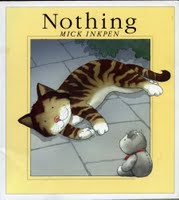 Since the sofa was installed in our den we have all gravitated again to it to read, watch a bit of TV and enjoy the fireplace. But always in competition for space with our Toby who likes the sofa and the room and now spends most of the afternoon there. If you happen to sit on the sofa, Toby will sit on your lap. He has a fondness for sitting on Lauren’s lap.
Since the sofa was installed in our den we have all gravitated again to it to read, watch a bit of TV and enjoy the fireplace. But always in competition for space with our Toby who likes the sofa and the room and now spends most of the afternoon there. If you happen to sit on the sofa, Toby will sit on your lap. He has a fondness for sitting on Lauren’s lap.As I look at the picture I feel that while I don’t live in the south of France I do believe that I may have something in common with Chandler Keeler and that is our mutual appreciation for the simple things in life.
Chandler Keeler's picture was taken by his Norwegian friend Torsten Mogenson. You can find Chandler's web page here. The picture of Toby, Lauren and me was taken by Lauren's sister Rebecca.
Manzanilla Papirusa
and more on pale, dry sherry
Forward To The Past
Wednesday, January 27, 2010
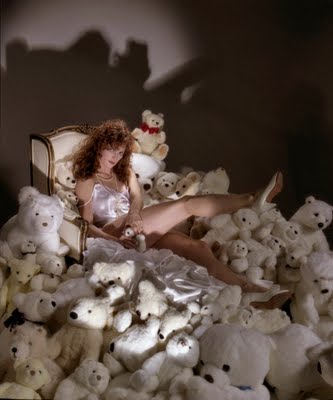
Every couple of days as I watch the present rush past me like a hummingbird on amphetamines I find a need to reflect and exchange thoughts with three friends in particular. They are writer and novelist John Lekich, designer Ian Bateson and freelance writer and English eccentric Mark Budgen. It is with the latter that I spend many minutes per day discussing the state of journalism. Of late it has been all about pay walls on the internet.
John Lekich, a once avid television (John would never utter that as TV) viewer restricts himself to the Turner Classics Channel and even that one is losing some of its luster as Lekich finds he has seen most of those films. He does not indulge on Twitter as Twitter would ban his beloved ajective, syntax and good writing.
Ian Bateson, who has a small but efficient design firm called Baseline Type & Graphics has a deep interest in social change. Of late Bateson has been exploring new ways to do business. One of these has been in navigating the business social networks like Linkdin and social networks like Facebook. He has been communicating with like-minded designers but finds that most comments are very short and mostly banal.
Mark Budgen, somehow went from sound recordings on records and bypassed everything that happened in-between and incorporated the iPod and podcasts to his life. He listens to esoteric classical music stations from Norway and reads the Guardian and the NY Times on line with great detail. Budgen is very informed on trends even though he has never driven a car or had a driver’s license. It was in the 80s that he got rid of his credit cards.
I have another friend writer Les Wiseman, who ever since I met him back in the late 70s always knew who was the latest very good but obscure rock singer or the finest up-and-coming porn star. It is no surprise to me that he now has Facebook friends that number in the three digits and that some of his e-mail messages to me have this at the bottom:
Sent from my BlackBerry device on the Rogers Wireless Network
Many of his friends are reformed and aging punk rockers who spat on the stage while performing but now have developed fine manners. I looked at some of the profiles of these people and it occurred to me that most of us see the world as a past/present/future continuum and in that order. Some others live in the past. But using lateral thinking I do believe that Les Wiseman and his friends have simply changed the past/present/future configuration to future/present/past and look, paradoxically ahead to the past.
I am not too sure that what follows has any relevance to the above.
It was in October, 1981 that Les Wiseman and I spent most of a late afternoon and long evening at Gary Taylor’s Rock Room trying to secure an interview and photo session with ex-New York Dolls guitarist Johnny Thunders who was in town to play with his band. His band included one Rat Scabies on drums. Until Thunders finally did himself in on a drug overdose in 1991 many who went to his performances where like the Vancouver Sun photographers who used to collect at the hairpin curve in Westwood waiting for some racing car driver to crash and kill himself. Johnny Thunders concerts were full of those waiting to see death on stage.

In 1981 I still subscribed to the idea that a camera recorded an event, exactly as it was and that the only personal interpretation to be gleaned from a photograph was the accidental or random fact that the photographer chose to press the shutter now as opposed to then or in a bit.
I snapped pictures of Thunders throughout the night mostly backstage. He would disappear to the bathroom for long half hours where he probably pierced with a needle whatever little patch of skin that was left that was intact. You can see here Les Wiseman’s account (part of it) on this Vancouver Magazine tear sheet. I know of many who think this is one of the pest snaps I ever took.
By 1986 Annie Leibovitz had changed the world of photography. It was New York City photographer Gregory Heisler who said for the record (American Photographer) something like, “Before Annie we could photograph people as they were and we took the best portrait we could. Now because of her we have to photograph people doing something.”
By 1986 my rock shoots for Vancouver Magazine had gotten ever more elaborate. We had enough clout that we would reject to photograph The Cramps while performing and insisted and demanded (and got our wish) to photograph them back stage, exclusively without any other journalists or photographers. By 1986 we had the custom of featuring a local rocker in a Christmas spread. In December 1986 Les Wiseman decided on heavy metal singer Darby Mills.
Out of the blue I decided to photograph her, dressed in a white teddy) with 100 white teddy bears. I filled my wife’s very large Audi with the bears which I obtained from the owner of a West Vancouver store called Bears Toy Store. The picture is slick and I used a complex lighting setup.

John Lekich would appreciate the Darby Mills shot. He would appreciate and probably count to see if indeed there are 100 teddy bears in there. Lekich might not understand the on-the-fly virtuosity of Johnny Thunders who might play brilliantly for 5 minutes and then crash for an hour with a cocktail of Courvoisier and heroin. In some ways many would say that my incidental grab shot of Thunders represents that momentary brilliance of the doomed man.
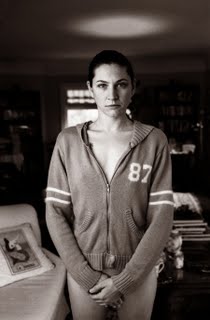
In a similar way I have approached nude portraits with elaborate lighting, large cameras and exotic locations. Even when I used my more neutral studio the cameras were still big and the lights powerful. I took some pictures on Monday of Anita a new model I have discovered who hails from Prince George. She has an easy smile (she had a bit of time following my instructions not to). She looks very young yet she is 35. I look at her pictures and see no connection to Darby Mills and all those bears. I see a solidarity to my images of Johnny Thunders.
Is simple more authentic? Is more elaborate less honest? As I pressed the shutter of my Nikon FM-2 (not much different than the Pentax MX I used to photograph Thunders) to photograph Anita in my living room, I felt a rush of youth as if, indeed the past were in front of me and all I had to do was to reach and find all that I thought I had lost, right there.
Le Petit Chaperone Rouge
Tuesday, January 26, 2010
Why should a horror film be just a horror film? To me, The Company of Wolves is a fairy tale; it’s got all those elements plus a lot more. And we know that fairy tales aren’t innocent any more.
Neil Jordan
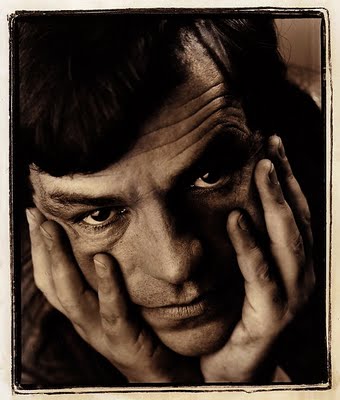
The Company of Wolves was a story in a story in a story, which is actually a dream a girl dreams within which her grandmother tells a story.
Neil Jordan
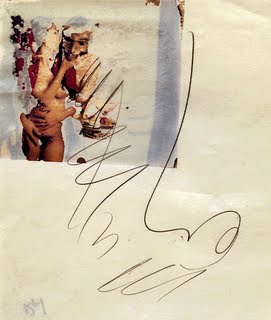
Evening At Home (With Bitterness)
Monday, January 25, 2010
 Evening At Home
Evening At Home(with bitterness)
There you are
Sitting before me,
Relaxed…sprawling, almost,
Your newspaper making little
Hackneyed rustlings.
And I am here
In the red armchair,
Hands loose in my lap,
Doing nothing.
Dreaming.
Not a word has joined us
For half an hour.
The silence is not expectant,
Not comfortable-
A dull, slate colored silence.
I ask myself, wonderingly:
“How can you miss someone
Who is right before you?”
Because I miss you,
I am unspeakably lonely
Even as I gaze upon you.
(You turn a page…there is a
Crackling.
You light another cigarette.
And I reach for a magazine
Three months old.)
Such As These – Dolores de Iruretagoyena de Humphrey, Mexico D.F. 1955
I became curious this evening thinking about my beautiful Aunt Dolly, my mother’s younger sister, with whom I have not had a word for at least 37 years. When my mother died in 1972, Aunt Dolly called me to tell me that it was such a pity that my mother had died a thief. A thief she was as she had kept what was left of my grandmother’s jewels. Most of them had been pawned (my mother's side of the story) to finance my Uncle Tony’s divorce and Aunt Dolly’s divorce to Uncle Joe Tow, both in Argentina where divorce was not recognized. My aunt had no words of comfort for me at my mother’s death. She told me that I, too was a thief by association. That was the last time I ever talked to her.
Through the years I have missed my Aunt Dolly who was our family’s Audrey Hepburn. Aunt Dolly was beautiful, slim and knew how to dress, wear jewelry and hold a martini glass with class. She could also write very well. When I was in the Argentine Navy in the 60s I corresponded with Aunt Dolly. I think I may have not only honed the few writing skills I might have now with those letters but in retrospect perhaps it wasn’t only from my father that I inherited a desire to write.
Aunt Dolly is not well as she is close to 90. I will probably never speak to her again. Today I had a pang of curiousity and I opened a book of poetry (in Spanish and in English) she published in Mexico in 1955. I read this poem and it wrenched my heart.
Her second husband, Bill Humphrey was an American geologist, very handsome with a nose that had been broken a few times in a boxing ring. Bill was tough. He mistreated Dolly’s son Robin and was not too kind to Robin’s sister Dolores. Bill loved his wine red 1955 Buick Century which he drove with only his right hand. His left hand was outside the window.
For reasons that I was never able to figure out he treated me with affection even though I was not an altogether likeable boy. I thought he was cool.
I remember the conversations between Dolly and my mother involving the latest problems from Bill and how he had done this or that to Robin and Dolores. People were afraid of the man. I never understood this because I never saw anything but kind attention and a smile in my direction.
When I read this poem I almost cried for my Aunt Dolly and I can picture her alone in her home in Houston. I only wish I could be there and tell her, “In spite of everything I am your nephew and friend.”
A Pomelo & Queso Tipo Roquefort
Sunday, January 24, 2010

Rosemary loves grapefruit so she starts buying them about now when they can be had for $0.50. She bought two without telling me and just a few days I bought two but told her. Rosemary loves grapefruit and so do I. So I pondered what to write about for Sunday’s blog after visiting my neighbours Robert and Patricia where we have been watching the Inspector Montalbano series (an Italian series that Patricia ordered as DVDs from their winter condo in Phoenix). I got home at 10:30 making the decision to finally get caught up and write my day’s blog on that day.
I saw four big grapefruits in the kitchen so I picked up one and scliced it in half. In Argentina we call a grapfruit a pomelo but in Mexico they call a it a toronja. After just about finishing one half of the ruby-red grapefruit (to which I had sprinkled some white sugar) I had an odd feeling. First I thought it had to do with my using a special grapefruit spoon. This is a “recent” invention as I never ever bothered to use them. It was Rosemary who bought the spoons.
The odd feeling became a fond memory as soon as picked up the grapefruit half and squeezed in carefully on the spoon to get every little drop of juice.
It was my mother who did this often and particularly in the morning. In Buenos Aires in the early 50s grapefruits were never pink or red. She would have them after having her coffee and toast which was liberally spread with Argentine queso tipo Roquefort. She invariably had a big smile on her face. Her smile was biggest when she squeezed the grapefruit half as I did just a few minutes ago.
In Mexico is was no different except she complained that Mexicans did not know how to make good cheese. She skipped the expensive imported Roquefort and settled on the Mexican strawberry jam which has to be one of the best anywhere. And then she would feast on her grapefruit, without sugar, and smile as I did today when I squeezed it and remembered my mother.
What my mother did not know is that the hollowed out grapefruit halves have some sort of scent that attracts snails and slugs. I start putting them upside down in my hosta beds just about now. When I check under them every few days I will find many slugs which I will cut (as my mother used to) with scissors.
My mother used scissors to kill slugs in our Buenos Aires garden. It would seem we had no flashlight so she used a candle to see. Slugs are quite nocturnal. One day she got her candle much too close to one of our palm trees. The palm immediately caught fire and the fire raced up in seconds. She called the bomberos. By the time they came the fire was out. And would you believe that the palm tree survived just fine?
I am sure my mother must have been worried for a while but as soon as she saw new growth on that palm she might have had an extra slice of toast with queso tipo Roquefort and then her usual grapefruit halves; all with a big smile on her face as she squeezed the halves to get every drop of juice.
Saturday, January 23, 2010
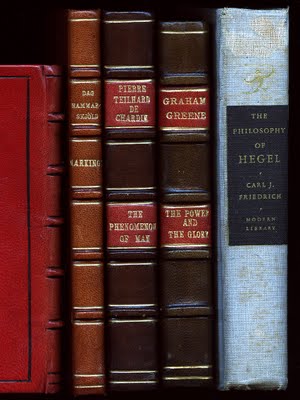
When Celia Duthie told me back in December that her sister was going to let go of the last Duthies store in February 2010 I thought about my relationship with bookstores since I began buying books in a pocket book emporium on 6th Street in Austin, Texas back in 1958. There were no porno stores in those days. So a 16 year-old boy with raging hormones could only find information about sex in racy pocketbook novels written by Frank Yerby, The Saracen Blade, Kyle Onstott’s Mandingo or Frank G. Slaughter’s medical novels and Taylor Caldwell's religious” novels like Dear and Glorious Physician (believe it or not even though it was a novelized biography of St Luke the Evangelist it had lots of sex). The Viking by Edison Marshall had graphic sex scenes, in Viking dragon ships. I was deeply dissapointed when all that was removed in the film version, The Vikings (1958) with Tony Curtis, Janet Leigh and Kirk Douglas.
In Mexico City in the late 50s and early 60s I bought every science fiction pocket book I could find plus studying under Ramón Xirau made awoke an interest in the Greek philosphers and for some reason Jewish philosopher Baruch Spinoza.
In Buenos Aires in the mid 60s I found good books in subway stations. They were cheap editions of Argentine classics like Martín Fierro, and epic poem by José Hernández, or such novels as Ernesto Sábato’s Sobre Héroes y Tumbas. It was at the Anglo-German bookstore Pygmalion on Calle Corrientes where my father had purchased his Dickens A Tale of Two Cities and Leslie Charteris’ The Saint series. My mother bought her Graham Greene at Pygmalion and it was at Pygmalion where I bought Pierre Teilhard de Chardin’s A Phenomenon of Man, Dag Hammarskjöld’s Markings and The Philosophy of Hegel, Edited With an Introduction by Carl J. Friedrich. I never noticed Jorge Luís Borges perusing the stacks even though he was blind. Alberto Manguel says he first met Borges while working at Pygmalion. It was in 1964 that Manguel became a reader to Borges.

My wild Correntina aunt, Sarita Pereira-Rego de Irureta Goyena introduced me to Cuban poet Nicolás Guillén when she gave me a copy of Sóngoro Cosongo.
By the time I returned to Mexico City I was an inveterate reader so I went to bookstores in late evenings after the movies. Both in Buenos Aires and in Mexico City, movie houses are near bookstores that remain open after the late shows. Not having ever read Borges or Cortázar in Argentina I began to buy cheap Mexican editions in those late night stores.
Books in English were expensive and hard to find. The best place was Sanborn’s the Mexican drugstore chain. They always had the latest pocketbooks at reasonable prices. They were a good source for my science fiction interest.
It was in Vancouver where thanks to Duthie’s and a friendship with Celia and her husband Nick that I became more of a literate snob and started reading in English. I would walk into the Duthies downtown and as soon one of the employee/managers saw me (Dave Kerfoot was one of them) he would say to me, “Alex we ordered in the latest Jerome Charyn for you.” I had never ordered the Charyn in question but they knew I would buy it every time.
With the demise of Duthies I can safely say that I have never read so much and so cheaply. The remainder section of Chapters, and the several very good second hand bookstores in Vancouver have provided me with hours of reading pleasure.
With room no longer available at home I have decided not to buy books anymore. For the last two months I have been learning of the delights to be found in our Vancouver Public Library (and I would like to add the word System). The VPL allows me to find books on line and to order them delivered to my nearest branch (Oakridge) at no charge.
I no longer need to buy books yet…
My friend Grant Simmons who owns DISC and prints all my colour slides and plant scans as exquisite giclées (high end inkjets on extra thick art paper) told me he was going to Cuba for a holiday. I immediately told him of two books that I would lend him for his trip. One may be a little obvious, Martin Cruz Smith’s Havana Bay but the other isn’t.
It was at the Chapter’s remainder section that I found, a year ago Adiós Hemingway by Leonardo Padura Fuentes (an English translation by John King). I would have never found this book or author in any Vancouver bookstore (perhaps Sophia Books). I would have probably not found it in the stacks of the Vancouver Public Library in a random search. Yet once I found the book at Chapter’s I located other novels by the author, in Spanish, at Sophia Books.
This makes me wonder if I should not visit Chapters, every once in a while. And spend some money.

I have written before here how it came about that I photographed Vancouver Province sports writer Jim Taylor twice within a week back in 1984.
As the 21st century distances itself from my 20th this photograph is one I think about quite often. It has all to do with that other (one of them being, “the best price is free”) mantra of the 21st century which is causing the slow disappearance of a lot of what was excellent. The mantra is “good enough”. More and more and particularly in the profession of photography the combination of a low (or, free) price and a picture that is good enough (it might meet a minimum requirement) is all that is needed for a magazine, a newspaper, a brochure or an ad.
Many have spent lots of money and time studying typography and design and now in this century too good usually means too expensive. So good enough and a low price is dismantling the classic design firms in Canada and around the world. The million-plus fonts and million-plus colours found in a computer make the hiring of a designer superfluous.
Nobody would ever argue that a man with a rifle is a soldier. Most would agree that the man would have to be trained as a soldier to be soldier. But the logic of this does not follow the logic that a person with a camera is not always a photographer and that anybody who can use computer driven design programs is not always a designer of the graphic kind. Nobody would assert that anybody who knows the ins and outs of Microsoft Word is a writer.
In 1984 designer and art director (Vancouver Magazine) Chris Dahl saw my first pictures of Jim Taylor and demanded to know why my pictures either showed him without glasses or, when he had them on, he was not looking at the camera. My explanation that I could not avoid the reflection of my flash on his glasses was not good enough for Dahl. I was dispatched to take them again and to make sure that Taylor was looking at the camera.
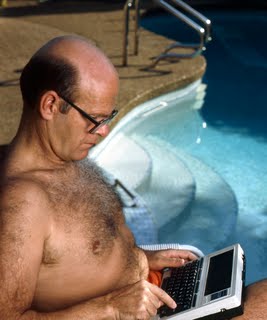
I tried to argue with Dahl that my pictures, right, were well exposed and sharp and that, was good enough. Dahl became mildly enraged and said, “Go back and take some pictures that we can both be proud of. And stop making the motions of being a photographer. Be one!”
He was absolutely right. We need more Chris Dahls in this world if we are going to lift ourselves from the mediocrity that is seizing this century.
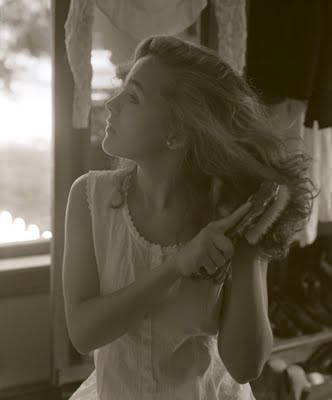
When I located these files of pictures I took of my two daughters in La Conner, Washington in 1988 there were several thoughts and memories that came to mind. When I saw Hilary’s pictures and noticed her blond hair with her dark eyes I immediately connected with the film Baby Doll which I had seen at about the same time as I found the La Conner negatives. In the film Carroll Baker also was blond and had dark eyebrows.
In the pictures of Ale (Alexandra) she does not smile in any of them. I have always read in her face (even in her mostly happy moments) the look of some tragedy that is within her. I think I know.
When Ale was three we had a live-in helper, Rosa, in our Mexico City home because both Rosemary and I worked all day. The details are hazy but somehow Rosa was able to locate me and she told me on the phone that Ale had drunk and emptied a bottle of Carbona (carbon tetrachloride) which she had found under the kitchen sink. In the late 60s this product was used to remove stains from upholstery.
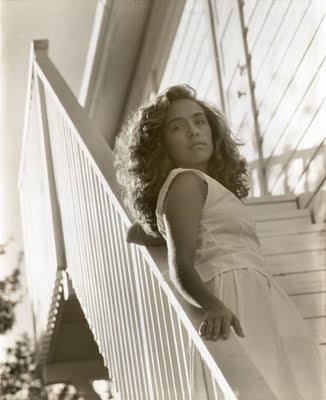
I rushed home to find my daughter barely breathing and with her eyes closed. I opened her eyes and all I could see was the white of the eyes. I called Ale’s pediatrician who told me to induce vomiting and then wrap Ale in a warm blanket and to take her to the hospital.
Years before in Nueva Rosita, Coahuila I had been a Boy Scout. I sat down for a few minutes and tried to remember what I had learned. I had learned that certain poisons because they were corrosive should not be removed from the body in the way the doctor had indicated. I put Ale under the tap of the tub and ran cold water until she came to. Then I called Pirulí (a neighbour) who drove me around the block to a doctor who had a home practice in our area. He immediately used a stomach pump and told me that had I done as the other doctor had indicated, my daughter would not have made it to the hospital alive.
A year later Rosa and Ale went for a walk to the nearby Bebederos which was a beautiful boulevard with huge eucalyptus and a center dirt road that people from a nearby riding club used to ride their horses. Ale was enjoying the flowers that grew on the side of the boulevard and bent over to pick some. A little girl, perhaps just a bit older said, “Those are my flowers.” She picked up a piece of brick and threw it at Ale. It hit her on the forehead and she began to bleed like crazy. When Rosa arrived with Ale both were drenched in blood. I went over to the nearby doctor who told me that I need not worry as head wounds were always bloody. He then made some banderetas, a sort of little flags that he cut with scissors from a roll of adhesive tape. He used these to bring the edges of the would (a largish cut) together. Ale did not need stiches and just a little trace of the brick wound has remained to this day. At age four, Ale could not explain to me why the little girl had been so vicious.

Both Ale and Hilary were born in Mexico. Hilary (Hilarious) is a generally quite a serious person with an easy smile and a gentle disposition. Ale to this day is very Mexican. She speaks Spanish with a strong chilango (Mexico City Spanish) accent. My grandmother who did get to see Ale but was in an institution with dementia, would say of Ale, “Se le pasea el alma por el cuerpo.” (He soul goes on a trip around her body.) What this means is that Ale takes her time with things. Generally like most Mexicans she isn’t all that punctual and she loves to do things extemporaneously. She likes to drop in without calling.
Most would say she is a happy person. But discern that sadness in her face that I see in so many Mexicans. They seem to be carrying the burden of the Spanish conquest, the many dictatorships and a revolution on their shoulders. I see this sadness in the faces of little children, many, who in the poverty of Mexico never experience childhood. Is this a Mexican sadness in her face caused by a near-death experience so early in her life?

I would say that I am pleased when I see Hilary smile. It reassures me and reminds me of my mother. And in some strange way when I glance at my eldest daughter’s face and see that melancholy, I, too, wonder why a little girl would not let her pick a flower. I also see in that sadness the sadness of my father who was never a happy man. That Ale is so happy in Lillooet just shows me that some of us, including the present blogger, find happiness in being blue.

When Celia Duthie told me back in December that her sister was going to let go of the last Duthies store in February 2010 I thought about my relationship with bookstores since I began buying books in a pocket book emporium on 6th Street in Austin, Texas back in 1958. There were no porno stores in those days. So a 16 year-old boy with raging hormones could only find information about sex in racy pocketbook novels written by Frank Yerby, The Saracen Blade, Kyle Onstott’s Mandingo or Frank G. Slaughter’s medical novels and Taylor Caldwell's religious” novels like Dear and Glorious Physician (believe it or not even though it was a novelized biography of St Luke the Evangelist it had lots of sex). The Viking by Edison Marshall had graphic sex scenes, in Viking dragon ships. I was deeply dissapointed when all that was removed in the film version, The Vikings (1958) with Tony Curtis, Janet Leigh and Kirk Douglas.
In Mexico City in the late 50s and early 60s I bought every science fiction pocket book I could find plus studying under Ramón Xirau made awoke an interest in the Greek philosphers and for some reason Jewish philosopher Baruch Spinoza.
In Buenos Aires in the mid 60s I found good books in subway stations. They were cheap editions of Argentine classics like Martín Fierro, and epic poem by José Hernández, or such novels as Ernesto Sábato’s Sobre Héroes y Tumbas. It was at the Anglo-German bookstore Pygmalion on Calle Corrientes where my father had purchased his Dickens A Tale of Two Cities and Leslie Charteris’ The Saint series. My mother bought her Graham Greene at Pygmalion and it was at Pygmalion where I bought Pierre Teilhard de Chardin’s A Phenomenon of Man, Dag Hammarskjöld’s Markings and The Philosophy of Hegel, Edited With an Introduction by Carl J. Friedrich. I never noticed Jorge Luís Borges perusing the stacks even though he was blind. Alberto Manguel says he first met Borges while working at Pygmalion. It was in 1964 that Manguel became a reader to Borges.

My wild Correntina aunt, Sarita Pereira-Rego de Irureta Goyena introduced me to Cuban poet Nicolás Guillén when she gave me a copy of Sóngoro Cosongo.
By the time I returned to Mexico City I was an inveterate reader so I went to bookstores in late evenings after the movies. Both in Buenos Aires and in Mexico City, movie houses are near bookstores that remain open after the late shows. Not having ever read Borges or Cortázar in Argentina I began to buy cheap Mexican editions in those late night stores.
Books in English were expensive and hard to find. The best place was Sanborn’s the Mexican drugstore chain. They always had the latest pocketbooks at reasonable prices. They were a good source for my science fiction interest.
It was in Vancouver where thanks to Duthie’s and a friendship with Celia and her husband Nick that I became more of a literate snob and started reading in English. I would walk into the Duthies downtown and as soon one of the employee/managers saw me (Dave Kerfoot was one of them) he would say to me, “Alex we ordered in the latest Jerome Charyn for you.” I had never ordered the Charyn in question but they knew I would buy it every time.
With the demise of Duthies I can safely say that I have never read so much and so cheaply. The remainder section of Chapters, and the several very good second hand bookstores in Vancouver have provided me with hours of reading pleasure.
With room no longer available at home I have decided not to buy books anymore. For the last two months I have been learning of the delights to be found in our Vancouver Public Library (and I would like to add the word System). The VPL allows me to find books on line and to order them delivered to my nearest branch (Oakridge) at no charge.
I no longer need to buy books yet…
My friend Grant Simmons who owns DISC and prints all my colour slides and plant scans as exquisite giclées (high end inkjets on extra thick art paper) told me he was going to Cuba for a holiday. I immediately told him of two books that I would lend him for his trip. One may be a little obvious, Martin Cruz Smith’s Havana Bay but the other isn’t.
It was at the Chapter’s remainder section that I found, a year ago Adiós Hemingway by Leonardo Padura Fuentes (an English translation by John King). I would have never found this book or author in any Vancouver bookstore (perhaps Sophia Books). I would have probably not found it in the stacks of the Vancouver Public Library in a random search. Yet once I found the book at Chapter’s I located other novels by the author, in Spanish, at Sophia Books.
This makes me wonder if I should not visit Chapters, every once in a while. And spend some money.
Good Enough - A Tragedy Of The 21st Century
Friday, January 22, 2010

I have written before here how it came about that I photographed Vancouver Province sports writer Jim Taylor twice within a week back in 1984.
As the 21st century distances itself from my 20th this photograph is one I think about quite often. It has all to do with that other (one of them being, “the best price is free”) mantra of the 21st century which is causing the slow disappearance of a lot of what was excellent. The mantra is “good enough”. More and more and particularly in the profession of photography the combination of a low (or, free) price and a picture that is good enough (it might meet a minimum requirement) is all that is needed for a magazine, a newspaper, a brochure or an ad.
Many have spent lots of money and time studying typography and design and now in this century too good usually means too expensive. So good enough and a low price is dismantling the classic design firms in Canada and around the world. The million-plus fonts and million-plus colours found in a computer make the hiring of a designer superfluous.
Nobody would ever argue that a man with a rifle is a soldier. Most would agree that the man would have to be trained as a soldier to be soldier. But the logic of this does not follow the logic that a person with a camera is not always a photographer and that anybody who can use computer driven design programs is not always a designer of the graphic kind. Nobody would assert that anybody who knows the ins and outs of Microsoft Word is a writer.
In 1984 designer and art director (Vancouver Magazine) Chris Dahl saw my first pictures of Jim Taylor and demanded to know why my pictures either showed him without glasses or, when he had them on, he was not looking at the camera. My explanation that I could not avoid the reflection of my flash on his glasses was not good enough for Dahl. I was dispatched to take them again and to make sure that Taylor was looking at the camera.

I tried to argue with Dahl that my pictures, right, were well exposed and sharp and that, was good enough. Dahl became mildly enraged and said, “Go back and take some pictures that we can both be proud of. And stop making the motions of being a photographer. Be one!”
He was absolutely right. We need more Chris Dahls in this world if we are going to lift ourselves from the mediocrity that is seizing this century.
Happy To Be Sad
Thursday, January 21, 2010

When I located these files of pictures I took of my two daughters in La Conner, Washington in 1988 there were several thoughts and memories that came to mind. When I saw Hilary’s pictures and noticed her blond hair with her dark eyes I immediately connected with the film Baby Doll which I had seen at about the same time as I found the La Conner negatives. In the film Carroll Baker also was blond and had dark eyebrows.
In the pictures of Ale (Alexandra) she does not smile in any of them. I have always read in her face (even in her mostly happy moments) the look of some tragedy that is within her. I think I know.
When Ale was three we had a live-in helper, Rosa, in our Mexico City home because both Rosemary and I worked all day. The details are hazy but somehow Rosa was able to locate me and she told me on the phone that Ale had drunk and emptied a bottle of Carbona (carbon tetrachloride) which she had found under the kitchen sink. In the late 60s this product was used to remove stains from upholstery.

I rushed home to find my daughter barely breathing and with her eyes closed. I opened her eyes and all I could see was the white of the eyes. I called Ale’s pediatrician who told me to induce vomiting and then wrap Ale in a warm blanket and to take her to the hospital.
Years before in Nueva Rosita, Coahuila I had been a Boy Scout. I sat down for a few minutes and tried to remember what I had learned. I had learned that certain poisons because they were corrosive should not be removed from the body in the way the doctor had indicated. I put Ale under the tap of the tub and ran cold water until she came to. Then I called Pirulí (a neighbour) who drove me around the block to a doctor who had a home practice in our area. He immediately used a stomach pump and told me that had I done as the other doctor had indicated, my daughter would not have made it to the hospital alive.
A year later Rosa and Ale went for a walk to the nearby Bebederos which was a beautiful boulevard with huge eucalyptus and a center dirt road that people from a nearby riding club used to ride their horses. Ale was enjoying the flowers that grew on the side of the boulevard and bent over to pick some. A little girl, perhaps just a bit older said, “Those are my flowers.” She picked up a piece of brick and threw it at Ale. It hit her on the forehead and she began to bleed like crazy. When Rosa arrived with Ale both were drenched in blood. I went over to the nearby doctor who told me that I need not worry as head wounds were always bloody. He then made some banderetas, a sort of little flags that he cut with scissors from a roll of adhesive tape. He used these to bring the edges of the would (a largish cut) together. Ale did not need stiches and just a little trace of the brick wound has remained to this day. At age four, Ale could not explain to me why the little girl had been so vicious.

Both Ale and Hilary were born in Mexico. Hilary (Hilarious) is a generally quite a serious person with an easy smile and a gentle disposition. Ale to this day is very Mexican. She speaks Spanish with a strong chilango (Mexico City Spanish) accent. My grandmother who did get to see Ale but was in an institution with dementia, would say of Ale, “Se le pasea el alma por el cuerpo.” (He soul goes on a trip around her body.) What this means is that Ale takes her time with things. Generally like most Mexicans she isn’t all that punctual and she loves to do things extemporaneously. She likes to drop in without calling.
Most would say she is a happy person. But discern that sadness in her face that I see in so many Mexicans. They seem to be carrying the burden of the Spanish conquest, the many dictatorships and a revolution on their shoulders. I see this sadness in the faces of little children, many, who in the poverty of Mexico never experience childhood. Is this a Mexican sadness in her face caused by a near-death experience so early in her life?

I would say that I am pleased when I see Hilary smile. It reassures me and reminds me of my mother. And in some strange way when I glance at my eldest daughter’s face and see that melancholy, I, too, wonder why a little girl would not let her pick a flower. I also see in that sadness the sadness of my father who was never a happy man. That Ale is so happy in Lillooet just shows me that some of us, including the present blogger, find happiness in being blue.
Wednesday, January 20, 2010
Sancho Panza complains to his master that he has not been paid for his services as a squire for some time. Don Quixote inquires as to the time period.
“Si yo mal no recuerdo,” respondió Sancho, “debe de haber más de veinte años tres días más o menos.” Diose don Quijote una gran palmada en la frente, y comenzó a reír muy de gana. (II, 28; p. 778)
“If I well remember,” answered Sancho, “it must be 20 years and three, days, give or take. Quixote slapped his forehead [the knee slap is a North American invention] and began to laugh in earnest.
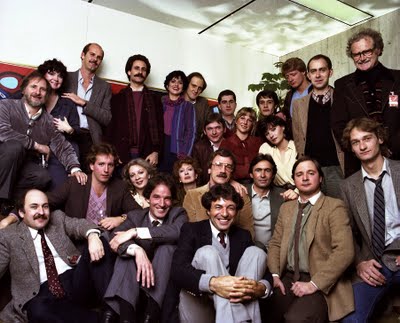
In 1975 my wife Rosemary, our two daughters and I drove up in our VW beetle from Mexico City to live in Vancouver. My youngest daughter’s urbane and multilingual (8 languages) godfather, Raúl Guerrero Montemayor told me, “Alex I am sure you will do well in Vancouver but I do remember that the fact that the people there are white does not mean they are civilized.” In those times I would have never thought that the comment was racist nor would I have taken offence. I simply laughed.
As soon as we arrived we did make some early friends who I remember invited us to “after dinner drinks.” I asked Rosemary if this was some quaint Canadian custom seeing that she had been born in New Dublin, Ontario. The concept of the after dinner drink was alien to her, too. For some time when my friends and family from abroad would ask me about Vancouver I invariably told them that the people here were as cold as the tap water.
Many of these opinions of mine have softened with time but I do miss the joviality of Mexicans and the constant embracing and kissing of Argentines. I have fond memories of my father kissing me. Do Canadian fathers kiss their sons? I am not sure.
As an alien from South America and in spite of now being a Canadian citizen I have not been able to discard the feeling that I am a penguin in the arctic living out of place and out of time.
My urbane compadre, Raúl, in spite of his extensive Swiss education finds the idea of mixing sweet with salty as a culinary aberration. He makes fun of Americans who serve cole slaw with raisins. The idea makes Raúl shake with disgust. I have learned to conquer my Latin bias and I will happily (but not with glee) consume said coleslaw or indulge in Chinese sweet and sour dishes.
In culture both Raúl and I like our singers to sing and our actors to act. We might tolerate opera buffa but like the sweet and the sour and the salty in separate areas of our dinner plate we like our stuff in distinct separation. We like Fred Astaire and Gene Kelly but that is about as far as we will go to tolerate that Anglo Saxon invention, the musical.
Which brings me to how I hate comedy and in particular the idea of going to some dark café, pay to get in and then listen to someone making jokes about East Indians in Surrey. I cannot stand stand-up comedy. I was turned off to comedy in the mid to late 50s listening to a Shelley Berman describe the look of a glass after emptying its contents, buttermilk, in one’s mouth.
I was sometime around 1982 or 1983 when the CBC hired me to shoot stills of a show that was called The David Steinberg Show which was being taped in the cavernous Studio 40 on Hamilton Street. Steinberg was a short cerebral kind of guy (20 odd days older that I am) who was not in the least funny. He oozed intelligence. He just wasn’t funny to this man who really does not understand comedy. As a child I hated the Danny Kaye films my mother took to see. I had not yet graduated from the films of the Gordo y el Flaco (Laurel and Hardy).
It was about that time that I was asked to take a group shot of comedians who had appeared that week at the show. My friend CBC cameraman Michael Varga, upon seeing the picture recognized Jackson Davies, Ryan Styles and David Steinberg (centre right with his hands on the shoulders of two companions). Varga says that the rest look a lot like Canadian Air Farce people.
There is no record on the web that Steinberg ever had a TV variety show in Vancouver yet there is this picture that must prove that it happened.
I am looking at the picture under a new light. I am looking at it under the new light of beginning to appreciate comedy thanks to what I consider the most serious show on CBC Radio One after Ideas.
What is that show? The show is The Debaters which is hosted by Steve Patterson and airs on Saturdays at 1:00pm (1:30 NT), and Wednesdays at 11:30am (12:00 NT) on CBC Radio One.
This radio show features two 15 minute segments in a 30 minute long show in which comedians (one per side) speak, in a live audience studio, for or against such topics as multiculturalism, the NFL versus the CFL or for or against the charms of classical music. Bill Richardson was superb last week defending the likes of Beethoven, Mozart and Bachman Turner Overdrive. He spoke of what classical music could do to arrest drooping titties and that immediately made me realize that The Debaters can get away with saying such things, debating seriously important topics that affect Canadians that are not the grist of conventional media. Particularly funny and paradoxically more serious is the second round calle the Bare Knuckles Round and when all stops are removed and the for or against participants go at each other's throats. While the show is really funny (I admit it!) it makes me think. If I were a CBC honcho I would turn The Debaters into a TV show and or ax Rex Murfy and have Steve Patterson host Cross Country Checkup. Because The Debaters travels across Canada they are a more relevant, and a more important variation of what Cross Country Checkup should be but is not.
Because of copyright reasons, since The Debaters is a contract show and not a CBC show there are no podcasts available (just a few tantalizing clips) but you can buy complete shows from iTunes. I think that I just might buy and listen to some of them while indulging in coleslaw with raisins.
CBC Ideas: with Paul Kennedy
Thursday, December 4, 2009
LAUGHTER: THE SECOND BEST MEDICINE
Dr. Robert Buckman, author of Cancer is a Word, Not a Sentence, takes his science very seriously. But in an evening recorded at the CBC’s Glenn Gould Studio in Toronto, he says that finding – and tickling – our funny bone is definitely good for our health.
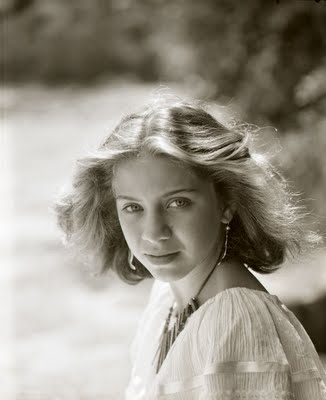
When Elia Kazan’s film Baby Doll (story and screenplay by Tennessee Williams) opened in 1956 at the Cine Roble in Mexico City I was much too young (14) to see it. In 1959 I went with my sometimes pious grandmother to see The Miracle with Carol Baker and a young Roger Moore playing a soldier from Wellington’s army. The film was sort about the Virgin’s apparition in Lourdes and my grandmother told me about secrets that had never been divulged which were probably all about the end of times. My grandmother stressed it as “el final del mundo”, so I should have perhaps capitalized that to the End of Times. In 1959 I was enamoured with Grace Kelly (she was on the pedestal) and I lusted over Brigitte Bardot (she was definitely off a pedestal as I wanted to look down and stare at her cleavage). Carroll Baker simply did not register in my mind and I really never did notice her in Giant.
In the late 50s my only other knowledge of Carroll Baker were the spoofs of her, sucking her thumb (the most notorious memory that people have of Baker’s performance in Baby Doll) that I saw and read about in Mad Magazine. In the 70s and 80s there were serious essays in Playboy that were often illustrated with that picture of Baker in her crib.
I am sure that my friend John Lekich (a walking film encyclopedia) could clue me in on Baker’s subsequent career. I notice that she did play Jean Harlow in a film. I never saw that film nor can I remember any other that might have had Baker in the cast.

All that changed yesterday when I saw an extremely clean and sharp print of Kazan’s Baby Doll on the Turner Classics Channel. At first I could not figure out who the incredible and sensuous blonde being seduced by Eli Wallach was (looking very young, very Sicilian and very nasty). The scene was near, and on one of those tandem wood swings that usually occupy decandent American porches of the South. As Wallach talked and filled the young woman’s ear with sweet platitudes I noticed the woman begin to breathe ever so more quickly until she almost swooned. This was one of the most extraordinary performances of a woman acting out desire that I have ever seen. It was at that moment that I figured out that I was watching a Williams play, and that the blonde was Carroll Baker. In how many films can one watch Wallach spar with Karl Malden? They looked like friends (probably the case off screen) doing what they knew how to do best, act. The music including a black man sitting on the floor on a porch, stomping his feet, playing a harmonica and singing was superb. I was mesmerized by the film and Baker became a revelation. I immediately consulted my only remaining collection of hard copy movie reviews, Pauline Kael’s 5001 Nights at the Movies (remember I am a self-confessed snob) and I found out that she was delirious in her praise for this film.

A week before I had found an 8x10 glossy of Hilary. It is the first picture you see here. I finally located the negative today and found I had taken it on Mayne Island in 1986. It was in that year that with some money in the bank Rosemary and I commissioned artist Jim McKenzie to paint our two daughters. He photographed them on the ferry on the way to his home on Mayne Island. I took pictures of the proceedings on the ferry and on the island, too.
On Saturday night while having dinner with Rosemary, Hilary, Rebecca and Lauren, Hilary removed her glasses. In spite of being tired after a long day as Wellness Manager and Consultant at Stong’s (while wearing the sexually ambiguous black uniform of her place of work) I was struck by her beauty. As soon as I returned from taking them home I removed the 8x10 from our family photo bin shoebox and stared at it. I had to find the negative. I did.

My mother was no raving beauty but she had legs, a body, a smile and grace in spades. I was often told that all I had inherited from her was her crooked smile. I must reveal here that, yes, I also inherited her legs and her beautiful feet. As for being handsome the only person who has ever directly told me I am handsome is the unrelentingly fastidious freelance editor Grip, Maja Grip. What this means is that any beauty in our family must come from my wife Rosemary. Everybody tells Hilary she looks like me and that her smile is as crooked as mine. This would mean that Rebecca’s grace and beauty came from her father or from my wife via her mother but not inheriting from her mother.
When Hilary was born, my mother looked at her and diplomatically said, “What beautiful hands she has.”
It was in 2009 that Hilary’s daughter quite rudely overstepped he boundaries of being a daughter ( an almost forgivable sin coming from someone that is not yet in her teen years but acts like one who is well into them) and in many words told off her mother (in my presence) that she had no grace and did not know how to dress.
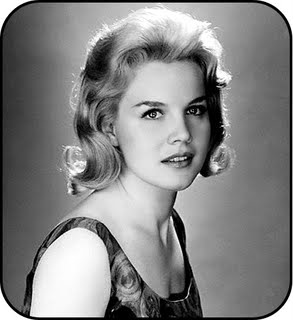
As I look at the many pictures I have taken of Hilary but never really printed my eyes have opened to her beauty and grace. While watching Carroll Baker’s performance in Baby Doll I was reminded of my own daughter’s sensuality which obviously I had suppressed since I was and am her father. But I can see that seriousness. I can see her natural ability to not smile unless prodded and I can see in her all the beauty and grace that her daughter Rebecca has inherited from her. That so many say that Hilary’s other daughter Lauren looks exactly like her mother, bodes well. This means that Hilary's two Stewart daughters will have grace and beauty in a long suit of hearts.
And if I were Rebecca I would find ways of making amends. After all the image that she sees on the mirror could well be her mother’s.
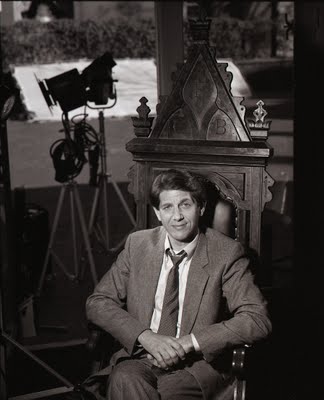
In 1987 Globe and Mail arts writer John Lekich and I had an appointment with American actor Peter Coyote at a movie set that was that old restaurant in Gastown that featured bad food serve by waiters dressed in monk’s habits.
While waiting for Coyote to show up a tall blonde woman appeared wearing a very tight silver satin dress, high heels shoes and a Ninotchka hat. She sat down in the chair you see here, lit up a cigarette and calmly stared at us. She looked like a woman that Humphrey Bogart would have called a dame. I managed to get some nerve and asked her if she would pose for me telling her, “We are waiting for Mr. Coyote and my lights are all set up.” She agreed and posed. I could see the Lekich licking his lips. She was, indeed a dame.
Coyote finally appeared and sat down for his photograph and Lekich did his interview. After what had been a pleasant afternoon I decided to pull a trick on Lekich as I was packing my stuff. At the time I had been having problems with my Mamiya film backs so I kept an old roll of film in my bag to test the system. I took it out and told John, “Here are her pictures,” and I proceeded, with great drama to unroll the film in a flourish and expose it to light. Lekich almost had a cardiac arrest. I explained my joke. He relaxed.

It was when I got home that I realized that I had exposed the real roll of film, the one of the dame.
Yesterday I dropped off film at The Lab. I was to take 12 rolls. Four were from a job for the Salmon Marketing Council and the other 8 were portraits of the new NDP MP for Coquitlam/New Westminster, Fin Donnelly. I counted the rolls. There were 13!
When I picked up the film I realized upon seeing the pictures of Rebecca and of our fall garden that somehow the roll had remained in a corner of my bag, unnoticed.

The surprise made me think of the Coyote incident and how, while the picture of Rebecca is not one of my best of her it still is a surprise. Perhaps I will be around when she indeed will become a dame and dress in satin, heels and a Ninotchka hat. If that happens I will make sure I get my shot.
The fall picture of the garden features (at the bottom) Hosta ‘Northwest Textures’ and, above, Kirengeshoma koreana.
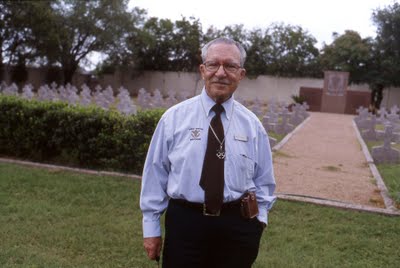
It was two in the morning last night when I found myself not being able to sleep. One word was in my head, Pascal. In the last few days I had seen his name in something and I had been struck by a quote of his. I could not remember. My thoughts went in circles and sleep did not come.
Blaise Pascal argued that if reason cannot be trusted, it is a better "bet" to believe in God than not to do so. He put this forward in his note 233 of his Pensées.
If there is a God, He is infinitely incomprehensible, since, having neither parts nor limits, He has no affinity to us. We are then incapable of knowing either what He is or if He is....
..."God is, or He is not." But to which side shall we incline? Reason can decide nothing here. There is an infinite chaos which separated us. A game is being played at the extremity of this infinite distance where heads or tails will turn up. What will you wager? According to reason, you can do neither the one thing nor the other; according to reason, you can defend neither of the propositions.
Do not, then, reprove for error those who have made a choice; for you know nothing about it. "No, but I blame them for having made, not this choice, but a choice; for again both he who chooses heads and he who chooses tails are equally at fault, they are both in the wrong. The true course is not to wager at all."
Yes; but you must wager. It is not optional. You are embarked. Which will you choose then? Let us see. Since you must choose, let us see which interests you least. You have two things to lose, the true and the good; and two things to stake, your reason and your will, your knowledge and your happiness; and your nature has two things to shun, error and misery. Your reason is no more shocked in choosing one rather than the other, since you must of necessity choose. This is one point settled. But your happiness? Let us weigh the gain and the loss in wagering that God is. Let us estimate these two chances. If you gain, you gain all; if you lose, you lose nothing. Wager, then, without hesitation that He is.
"That is very fine. Yes, I must wager; but I may perhaps wager too much." Let us see. Since there is an equal risk of gain and of loss, if you had only to gain two lives, instead of one, you might still wager. But if there were three lives to gain, you would have to play (since you are under the necessity of playing), and you would be imprudent, when you are forced to play, not to chance your life to gain three at a game where there is an equal risk of loss and gain. But there is an eternity of life and happiness. And this being so, if there were an infinity of chances, of which one only would be for you, you would still be right in wagering one to win two, and you would act stupidly, being obliged to play, by refusing to stake one life against three at a game in which out of an infinity of chances there is one for you, if there were an infinity of an infinitely happy life to gain. But there is here an infinity of an infinitely happy life to gain, a chance of gain against a finite number of chances of loss, and what you stake is finite.
Blaise Pascal, from his Pensées
Brother Edwin Reggio, CSC first told us about Pascal’s wager sometime in 1959 in our religion class at St. Edward’s High School in Austin, Texas. In the context of the times it seemed like a safe bet. I remember that Brother Edwin told us of the wager with a very straight face and did not push us to think about it in one way or another. Since Brother Edwin was a math whiz he explained it all with a wealth of statistics. His dissertation on Pascal was as neutral as his explanation of Aristotle’s’ “unmoved mover” and its re-interpretation by St. Thomas Aquinas. Brother Edwin was not out to proselytize but to simply place the facts as he knew them and from there we could make up our minds for ourselves.
So being awake at two in the morning and with no prospect of sleep I decided to track down the Pascal that was consuming my thoughts to an obsession. I went downstairs and fired up my computer. It opened on my home page, the NY Times. I put in the top left search rectangle, Pascal, and was instantly rewarded with the source which was a lovely paean/memorial to recently deceased French film director Eric Rohmer by André Aciman called My Nights with Eric. I had read it in the Saturday edition of the hard copy version of the Times. If you have access to the online version you can find it here. It is beautiful.
The quote in question was:
With Eric Rohmer, as with Mozart, Austen, James and Proust, we need to remember that art is seldom about life, or not quite about life. Art is about discovery and design and reasoning with chaos. If there is one thing I will miss with Eric Rohmer’s death, it is the clarity, the candor and the pleasure with which one human can sit with another and reason about love and not forget, in Pascal’s words, that “the heart has reasons that reason knows nothing of.”
I must confess that I have never seen one Rohmer film but I have been affected by a still image (I first saw it so many years ago in film reviews) of his film Claire’s Knee. I reproduce it here and hope that nobody will pursue me for using it without permission. The still is one of the most wonderful film stills I have ever seen. I have read reviews of the film and read many articles and essays on Rohmer’s life as a critic, writer and film director. I have now put by reserve dibs on the Vancouver Public Library’s copy (they have two) of Claire’s Knee and I look forward to the discovery of a man that I should have known about years ago.

The Pascal quote in the André Aciman essay made me think (with a smile in my face) that the mathematician and wagerer that Pascal was still had room for such a romantic view on the human heart.
It was last summer that I spent a few days with Brother Edwin Reggio and he invited me to spend some time in hismonastic retreat, which is his place of residence by the old main building that was our school. I had lunch and dinner with him, and his associates, who all seemed to live a life of knowing that whatever wager they had made with life when they were young novitiates was a wager that was well chosen. They were now reaping the benefits of a win. I watched Brother Edwin’s face, full of contentment, his easy demeanor and what seemed to be a complete lack of stress. He smiled in my direction paternally, the once-teacher and now my friend. I almost wish he had been a bit more forward about telling us of Pascal’s wager. Could it be now too late for me to play that game?

We photographers, or perhaps I should just speak for myself, is very much like Snow White’s wicked queen/witch. The queen looked at herself in the mirror and wanted the magical mirror to reinforce that she was indeed the most beautiful woman of her kingdom.
This photographer has to be reinforced every once in a while and told I am the best. In the many years that I have been in the business of magazine photographer I have rarely noted a fashion photographer who approved of another colleague’s. Fashion photographers, by their very craft are in Vogue and out of Vogue very quickly. It is difficult for them to remain at the top for long. Since 1975 I have seen fashion photographers come and go. Few ever stayed to linger. One, the best ever was Howard Fry who retired to Salt Spring Island. His end came with the demise of department stores and their lucrative catalogue and newspaper flyer/brochures. Fry’s work was always crisp and original.
There was another whose name I have forgotten who made his female models look like women you would want to date on the spot. I remember a spread he did for Vancouver Magazine where he photographed them in a bathroom. The last Vancouver Magazine editor, Malcolm Parry ever heard of him was that he had absconded with a shipment of lingerie the magazine had sent to him in Italy where he was going to shoot a spread. I had my first suspicions that the photographer was more, or perhaps less, than he seemed when I found him in a room (the Tropicana Motor Inn on Robson) with Johnny Thunders and Thunder’s girlfriend. Was it the booze (a bottle of Courvoisier)? Was it the heroin? Was it both?
I am not a fashion photographer and by that very fact I have had a bit more longevity. But I still look at myself in the mirror, figuratively and literally. There are some days when I think I am all washed up and then there are days when someone might tell me I am very good. Unable to accept that kind of praise my usual comment is, “After all this time, if I weren’t any good I would be terribly stupid to continue. I would have switched to plumbing a long time ago and prospered, too!”
The picture here, Claire Love at the Marble Arch, is one that I can objectively say speaks of a talent that I was born with. The talent in question is to know, sometimes at least, when to press the shutter and to make sure some sort of viewable image is left that can be used, printed or in the case here scanned and posted on this blog.
When I look at this picture I feel that I can face that talking mirror and its lips will say, “You are good; at least for today.”

P.K. Page’s picture caught my eye in today’s Vancouver Sun. I was saddened to find out it was her obituary. She was 93 when she died on Thursday. I immediately remembered my day with her and her husband Arthur Erwin some 15 years ago. Rosemary accompanied me on my assignment for Western Living to capture one of those At Home With… It was early spring and the only blooms in P.K. Page’s Victoria garden were bright red tulips. Getting ready for her pictures she told me, “I thought I would wear shoes to match the tulips.” While I had several chats with her the one who spent more time with her was Rosemary. P.K. Page confessed to Rosemary the problems with living with a man who was so much older than she was. He was not well and he was simply difficult.
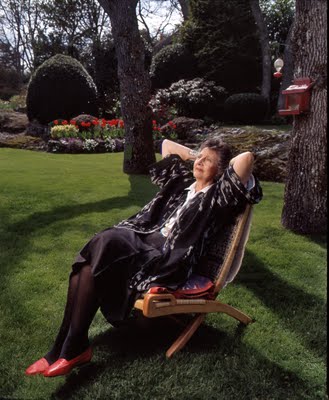
I can attest to this. He was snarly with me so I opted to take his picture from far away in the garden and use the red rhododendrons as a foreground foil. At one point I shouted in his direction, “Mr. Erwin it is very easy for me to focus my camera on you because of the dogwood flower pin on your lapel.” Immediately Mr. Erwin shouted back, “Young man, come here.” This I did. He stared at me and using his index finger for emphasis he told me with a sneer, “Young man, this is not a dogwood, this is the Order of Canada!”

Spending the day with P.K. Page was like spending the day with my mother. I thought there was a physical resemblance and I got the impression that P.K. Page was a gentle snob just like my mother. I was posing her by one of her Garry Oaks and I asked her not to smile. She was reluctant. I explained that as a poet she could be romantically serious and get away with it. She gave me a full smile and then said, “You are absolutely right,” she turned serious and gave me an expression much as my mother would have that we in the family called the Sarah Bernhardt.
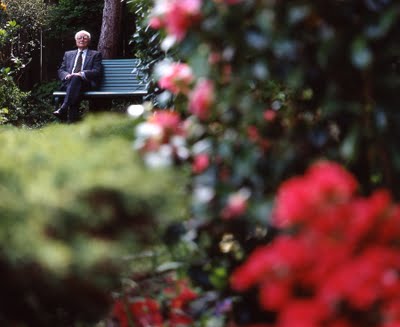
Of all the poems by P.K. Page that I have read my favourite is her incredibly romantic Adolescence. I live in a delightful anticipation of being able to read it soon to Rebecca who is now 12 but going on 15.
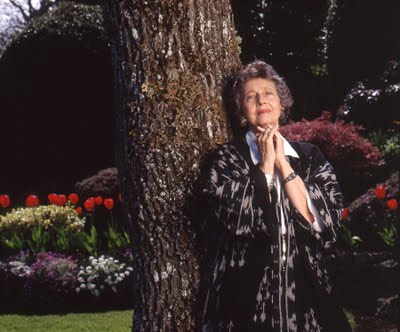
Adolescence by P. K. Page
In love they wore themselves in a green embrace.
A silken rain fell through the spring upon them.
In the park she fed the swans and he
whittled nervously with his strange hands.
And white was mixed with all their colours
as if they drew it from the flowering trees.
At night his two finger whistle brought her down
the waterfall stairs to his shy smile
which like an eddy, turned her round and round
lazily and slowly so her will
was nowhere—as in dreams things are and aren't.
Walking along avenues in the dark
street lamps sang like sopranos in their heads
with a violence they never understood
and all their movements when they were together
had no conclusion.
Only leaning into the question had they motion;
after they parted were savage and swift as gulls.
asking and asking the hostile emptiness
they were as sharp as partly sculptured stone
and all who watched, forgetting, were amazed
to see them form and fade before their eyes.


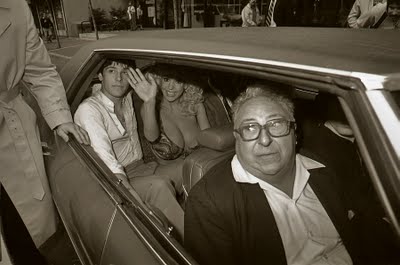 I had admired the writing of Chris Hedges, a former war correspondent (the First Gulf War) for the New York Times so when I saw a book of his at my local Vancouver Public Library (the Oakridge Branch) I grabbed it. It is a fast read which means that the book has just been published and when you take it out you get it for only a week. For every overdue day you pay $1.00.
I had admired the writing of Chris Hedges, a former war correspondent (the First Gulf War) for the New York Times so when I saw a book of his at my local Vancouver Public Library (the Oakridge Branch) I grabbed it. It is a fast read which means that the book has just been published and when you take it out you get it for only a week. For every overdue day you pay $1.00.
Fast read, is one thing this book, Empire Of Illusion - The End of Literacy and the Triumph of Spectacle is not. It consists of five chapters which are essays on what is wrong with the United States, and by a most logical extension what is wrong with our Canada.
I finished the second chapter, Illusion of Love last night and it left me shocked and deadened. When the subject is pornography I am a naïve amateur.
My first foray into pornography happened in 1973 when my wife, two small daughters and I drove our VW beetle from Mexico City to San Francisco. While there I decided I needed to see a dirty movie. I had read about Deep Throat. I told Rosemary, “I am off to see a pornographic film called Deep Throat.” She said nothing.
I sat behind two black men who ate popcorn through the whole film. I left with the realization that if I saw too many of these films I would end up impotent. I simply was not into pornography. Deep Throat was the last and first porno movie I ever saw.
In the mid 80s my friend Les Wiseman was writing a rock column, In One Ear for Vancouver Magazine and he used this as a justification to interview ( I went along as the photographer) porn star Marilyn Chambers at the Four Seasons Hotel. The justification had all to do with the fact that Chambers was the lead singer of her own country and western band and it was playing the evening after at the Commodore.
When we left the interview I asked Les, “Do they really do it in the movie. Is it for real?” Les snickered and answered, “What do you think?”
About 10 years later I rang the bell at Les’s coach house pad near City Hall. I was there just for a visit. He let me in and told to sit down in front of a wooden cabinet. He opened the doors to a largish TV set. He pushed a few buttons and I was soon watching a detailed close-up of Marylyn Chambers having sex. He said, as if those 10 years had been only 10 minutes, “You see they really do it.” I did not ask for more details as it bored me and I left it at that.
A friend of mine, a very good local female photographer decided to try her fortune in Los Angeles. A couple of years later she had a really well paying job which consisted of finding good motels and locations for porn films. I was shocked and a bit disappointed in my friend.
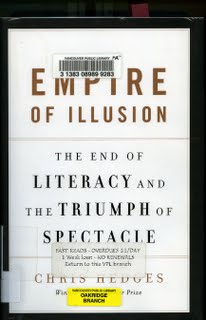
Hedges’ chapter on pornography is so incredibly brutal that I could not believe what I was reading. His descriptions on what these more recent films include and how it affects the health and the well-being of the women involved are all shocking. The fact that after all kinds of multiple penetrations by dozens of men within a few hours, one of the men will grab the woman and drag her to a toilet. He will then plunge her head into the toilet bowl and flush it (it's called a swirlie) was, paradoxically the tamest of what I read and the only description I will put here.
Then I was hit by the statistics. Here they are:
There are 13,000 porn films made every year in the United States, most in the San Fernando Valley in California. According to the Internet Filter Review, worldwide porn revenues, including in-room movies at hotels, sex clubs, and the ever-expanding e-sex world, topped $97 billion in 2006. That is more than the revenues of Microsoft, Google, Amazon, eBay, Yahoo!, Apple, Netflix, and EarthLink combined. Annual sales in the United States are estimated at $10 billion or higher. There is no precise monitoring of the porn industry. And porn is lucrative to some of the nation’s largest corporations. General Motors owns DIRECTV, which distributes more than 40 million streams of porn into American homes every month. AT&T Broadband and Comcast Cable are currently the biggest American companies accommodating porn users with the Hot Network, Adult Pay Per View, and similarly themed services. AT& T and GM rake in approximately 80 percent of all porn dollars spent by consumers.
Empire of Illusion, Chris Hedges, 2009
I felt compelled to write about pornography when I had a phone conversation with a Vancouver colleague, Hans Sipma. I was telling him that the latest art craze at Emily Carr University of Art And Design is the Super 8 movie. Sipma sent me a YouTube link to a Super 8 movie he happened to take in 1982 when he was working in a studio for Eaton's on Robson and Granville (in the very building where I had my studio until this past September). It features a street demonstration headed by then city counselor and religious minister Bernice Gerard. The demonstration was protesting the screening of Caligula in a conventional (not a porn establishment) movie house on Granville.
I guess that had I seen Gerard then I would have thought her some sort of a fringe nut. Now as I listen to her talk to Sipma’s camera she seems to make sense.

My photographic grab shots, taken in the early 80s, of stripper and nude performance (streaking in baseball and football games) artist, Annie Ample, somehow promoting a non-smoking campaign and with the odd participation of the Penthouse’s Joe Philliponi seem to be quaint and innocent. The shots are almost laughable. Where those times (in comparison to the hell Hedges writes about) really that innocent?
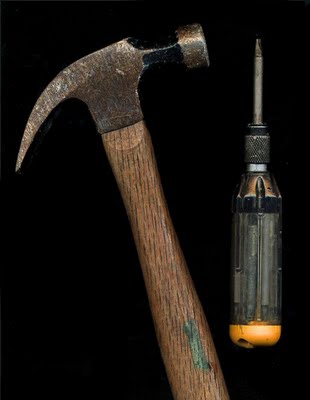
Miss Scarlet did it in the studio with a hammer. Or was it a screwdriver?
Sometime around 1982 I was driving my spiffy Fiat X 1/9 on the Trans Canada Highway freeway not far from our home, (I had gone shopping to a nearby Safeway) in Burnaby. Suddenly the gas pedal seemed to collapse and I lost all power. Luckily I was able to pull over and I was not rear ended. I opened the motor compartment (right behind the rear window but in front of the rear trunk (the X 1/9 was a mid-engine automobile). The cable from the gas pedal leading to the carburetor had been severed. I sat down to think and remembered I had purchased bread. In those days bread still came secured in paper coated wire bread ties and not with those rectangular plastic thingies that are used now. I used the bread tie to temporarily secure the gas pedal cable to the carburetor and I gingerly got home with no problem. Mail had arrived and there was a envelope from Fiat Canada telling me about a recall that had all to do with the sudden breaking of gas pedal cables. I was to report to my dealer as soon as possible for the installation of a beefed up and improved connection.
I have been privy to heated arguments between fellow photographers who argue about their cameras (and in particular their digital cameras). In this age of uniformity they argue “My Canon is better than your Nikon.” They argue back and forth until someone tired of the shouting simply says, “A camera is a tool. It is how you use it that really counts.” I have been made speechless by how often I hear this statement that I gave it some thought some years ago and came up with the comparison of cameras with two ubiquitous tools, the hammer and the screwdriver. These are specific tools that are made for a particular purpose. The hammer is used for hammering in nails or for removing them. The screwdriver is for screwing in screws or unscrewing them. But there are other uses for these specific tools if you put some thought into it. The hammer, wrapped in a cloth, could be used to hammer in and firm up the loose joint of a chair or table. The screwdriver can make thin holes in the ground to plant seeds. I don’t think that Miss Scarlet ever considered using either tool as a murder weapon in the board game of Clue, but in a pinch, either would do quite well.
Of late I have been thinking a lot about cameras as tools and just a few days ago I came up with the pseudo McLuhanesque expression, the medium suggests the method. I will use my medium format film camera the Mamiya RB-67 as an example. It used to shoot 20 exposures (6x7 cm in size) of 220 film or 10 exposures in the half-length 120 film. As soon as most manufacturers discontinued 220 film I was stuck with 10 exposures per roll. The camera comes equipped with removable film backs so I can load them up (I have three) and shoot one after the other.
But from the beginning this large and heavy camera “suggested” to me a frugality in shooting. It’s big viewfinder helped me look at every corner of my frame and I would note all the corrections I needed to make before I exposed film.
Back in the 70s, or later on when I sometimes used 35mm film cameras, my assignments could be executed with 36 exposure rolls. Even though I knew I had my shot (usually early on) I would tell my subjects that I had to finish off the roll as I did not want to waste film. “Film is expensive,” I would tell them.
In the last 10 years as the editorial jobs from the Georgia Straight began to peter out and their editorial rates were kept pitifully low while their demands for what they wanted increased I learned the frugal trick of shooting one Polaroid test in b+w and then doing the job with two or three exposure of a 10 exposure 120 roll of Ektachrome. When possible I tried to stack together more than one job and I would do two and even three with one 10 exposure roll. Doing this was exciting and I was never asked by the folks of the Straight, “Do you have other versions of this?”
My Mamiya RB when placed on a heavy tripod is secure but if you wanted to twist the camera on its side to go from a vertical format to a horizontal format it would be a time consuming job. The folks at Mamiya rose to that occasion by designing a film back that rotates so you can turn it to the vertical or horizontal mode. In my years as a magazine photographer (beginning around 1977) I have rarely had my photographs cropped. I would always shoot a vertical and a horizontal version of everything. And the folks at the Straight demanded only vertical pictures for their arts pages so I never had to opt for shooting those two or three shots as horizontal versions, too.
Because of my frugality I have always used a very good flash/exposure meter. By making sure that every exposure I took was the right one I never did waste film in what many photographers call bracketing. This means shooting a burst of at least three exposures with half-f-stop increments either way of the supposed correct exposure. My experience is that the portrait with the perfect expression was the one that was too light or too dark.
My Mamiya has an accessory Polaroid back (I shoot Fuji instant film now). From the beginning I standerized my photographic method by using film that was always the same ISO speed rating of 100. I noticed that when I removed the battery from either of my two Minolta meters that when I would re-install it the meter would automatically read 100 IS0. For many years I always duplicated my shooting by doing so in colour and in b+w. The Mamiya allows the photographer to shift back and forth between two different kinds of film and ultimately with a as many as you want if you have a film back for each. So I used 100 ISO b+w film and Kodak Ecktachrome 100. I never had problems in setting my meter to match the film in the camera.
The fact that my Mamiya RB is fully manual and has no built-in light meter has meant that I never had to override any faulty exposure failure of the built in meter the camera did not have.
My adaptation to my tool (the Mamiya RB) meant and has meant that I had a very low incidence of photographic failure. In editorial photography this means being able to provide a magazine or newspaper art director with one useable image with no excuses.
As a dinosaur of the film age I have not adapted my photographic procedure in any way except to realize that film and my good film scanner combine to give me a pleasant cushion to save an unforeseeable (not frequent with me since I have duplicate equipment in my camera bag) exposure. A slightly overexposed slide was toast. Now it can be fixed. The dark under exposed slide can be brightened up. But my scanner has never been a crutch. I depend on my two identical Minolta meters to keep my exposures accurate.
This means that in many respects my camera (my Mamiya RB) is much like the hammer or the screwdriver I mention above. I have adapted to the camera’s design assets. That it is heavy has meant that I have learned to use a tripod and then without having to worry about moving myself around (or moving my hands and arms up or down) I can concentrate through that big viewfinder to notice the nuance of expression of my subject. I can move the camera up or down millimeters or centimeters on the tripod column and notice how this affects the look of my subject’s face. When I find the right place I can take two or three shots and play with the expression knowing that the angle of my camera is the right one and secure. While Mamiya did make an expensive zoom lens I could never afford it nor did I ever want one. I use really only three focal lengths, a 50mm wide angle, a 90mm normal lens and an extremely sharp 140mm longer lens. In the wings I have a 65mm and a 250mm telephoto for special situations. This means that my pictures are never taken at 98.76 mm or 53.85 mm. The shutter speeds of my Mamiya lenses are mechanical so I can opt for 1/250 or perhaps 1/15 second. Modern electronic cameras give you stepless (to me confusing) speeds like 1/753 of a second.
In short my medium, my Mamiya RB and other ancillary items (important) as my one light soft box method and a gray wall, has “suggested” what has in the end (but early on) became my recognizable and fairly lucrative style.
To put that in another way this style has been my adaptation (listening to my camera’s silent suggestions) to the reduced parameters of my camera. I have found that reduced parameters lead to creativity while over-choice does the exact opposite.
Now in the 21st century we have fewer camera manufacturers but they make incredible machines of miniaturized electronic engineering. They are wonders of what we are capable designing. These cameras come with so many options that their manuals are as complex as the motherboards of the on-board processors of these Digital Single Lens Cameras or DSLRs.
The back lit viewing screen that pops up on the back of the camera after each exposure guarantees (almost as those storage cards, the closest equivalent to film in those cameras, can become corrupt), at the very least an approximation that all systems are working correctly and that the picture is in focus (or not) and correctly exposed (or not) and that the chosen crop is the one want (or not). Many of us make fun of these photographers that check (chimp) after every exposure. But few of us remember how dependant we soon became to checking, every once in a while, what we were doing with a Polaroid back on our medium format cameras or bigger 4x5 and 8x10 view cameras. There were some very rich American magazine photographers that had special Polaroid camera backs made for their Nikons!
I do believe that chimping with a DSLR somehow results in a sort of photographic coitus interruptus. It makes the photographer work in a jerky manner. While I do believe that one should cultivate a relationship with ones subject (particularly for a magazine shoot) the moving of the camera to our subject so that both of us can see the little picture in the back forces some sort of instant closeness that might affect one’s objectivity as a magazine or newspaper photographer.
As a Mamiya RB shooter I see myself as sharpshooter with an instrument where each bullet (or exposure) must count. I see DSLR shooters as Gatling Gun operators hoping that in their spray they might hit the target.
I can list here the many advantages of the modern DSLR. There is the obvious one that if you travel you need not worry about airport security x-rays fogging up your film. A DSLR’s ability to adapt with white balance to any kind of lighting situation or to even make a cloudy blue day into a more cheerful one is another. But many a digital photographer, unable to force themselves to shoot with accurate exposure by using a good meter, is forced to shoot in the RAW format This results in long hours of post production work flow (not paid by most customers). The RAW format gives a photographer ample room for exposure failure correction and even white balance correction.
What this means is that the DSLR photographer will shoot bursts of exposures showing a person without much change instead of the photographer taking the time to pick the right expression.
DSLR advertising tells us that with one of these in our hands we can do anything. Camera advertising has been spotty since the beginning. I remember Olympus harping that their cameras came equipped with ESP! With the digital wonder in hand we will rarely decide to use supplementary lighting. It is supplementary lighting that helps to take a picture’s look away from that uniformity of the norm that we see in Flicker. The camera is then capable of doing anything and this anything is the very anything that all those photographers with a camera like you are doing.
It is a DSLR’s capacity to do anything that makes the photographer flounder in over choice. It is up to the photographer to somehow talk back to that digital wonder and suggest back, “I want to do this, and you are going to do just that and shut up.” Until each individual photographer does that photographs are going to have the boring uniformity of Flickr.
further musings into change in the 21st century.
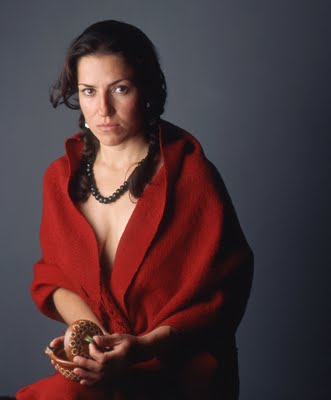
My friend Ian McGuffie often says that 20 years ago if you walked around Stanley Park you would occasionally run into people with a camera around their neck. These cameras were often expensive or moderately expensive Nikons, Canons, Pentaxes or Minoltas. McGuffie also says, “You could never tell what kind of pictures those people took because they could not publish them or show them anywhere. It is because of this that I cannot assert that photographers then were any better than the ones we have now. Perhaps the photographers of those days were terrible, but we have no way of knowing.”
The advent of the digital camera, in which a $150 point-and-shoot can take pictures that not only “turn out” but can be quite nice, has evened the playing field. Not too many in those Stanley Park days of yore could afford a Nikon FM-2 or a Pentax LX. The digital camera has evened the playing field much in the same way that the mass-produced Colt .45 made a gunfighter’s day decline with competition. The freelancer of the 20th century, the professional photographer is much like that freelancer of the 19th, the gunfighter. The 21st century has made me as obsolete as running boards and horse whips.
In 1979 or thereabouts I lit my photographs using what at the time was a rare item. It was a rip-stop nylon portable tent (similar to the modern camping tent) called a soft-box. The pictures with the soft box had much less contrast than pictures taken with a direct flash. The soft box soon became part of my style (the pictures here were all taken with such a device) and brought me lots of magazine and annual report work. I would light lumber mill workers in Prince Albert, Saskatchewan or Lumby, B.C. with them and soon I was being paid a week’s worth of lofty day rates to repeat the pictures in mills across Canada, from the ground and from the air in a helicopter (no soft box, natch).
The diminishing of the logging industry in Western Canada happened at the same time that film-based cameras and related photograpy began their downturn and the emergence of the digital “peacemaker” or “equalizer”. Any photographer today can imitate and improve on my photographic methods and do it much more cheaply. I am a hired gun in a peaceful community where the rule of law has replaced the free range.
Like that rare gunfighter who somehow managed to retire without being gunned down by the latest town hot-shot, I can observe that the playing field has resulted in a uniformity of technique. Pictures look much like each other. McGuffie might say, “Contemporary photographers are not better than those from the past. The difference lies in that they now have the power to “publish” them in social network sites.” I like to use the word Flickr as a verb. It is my contemporary replacement for "to make the same". Photography, particularly that in social network sites, is being Flickrd.
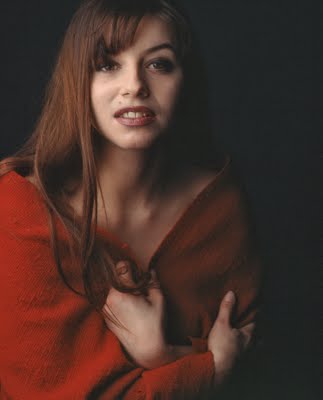
Today I gave my last class, Style Development, to the 7th generation of students at Van Arts. They are DP7 (Digital Photography 7). I spent most of Monday night trying to figure out how to help (even what to say) to a generation faced with the photographic uniformity I write about above. How are they going to achieve what I call the Holy Grail of Photography, a readily observable personal style, in the age of Flickr?
Here is the handout I wrote. Those of you who are photographers might understand some of the points and some might not. But the questions I raise and the assertions I make are not written in stone. Perhaps there is another way. If there is then I can soon sleep well at night knowing that the Age of Flickr is past and that individual style is back in a new renaissance.
The pictures you see here were all taken with a single light attached to a 2x3 ft Chimera soft box. These pictures would have been unique in the 80s and 90s. My contemporary students can now match and improve on this style. One of the elements I have harped about to my students is to take pictures with a theme. The theme here is my mother's red Mexican rebozo that was given to her around 1953. I have used it to photograph many people through the years. I often take it to class and my students use it. Their pictures look like mine. I have been equalized!

January 12, 2010
Style Development
Van Arts
Last two classes
Alex Waterhouse-Hayward
I taught high school until 1974 in Mexico City. We decided to sell our house and move to Vancouver. We quit our jobs. Suddenly we could not sell our house and I had to make money in some way. With a Pentax S-3, and 55, 36 and 120mm lenses I went into business shooting the children and teenagers of wealthy Mexicans. I used Kodak Tri-X exclusively and I had no lights. I printed and processed everything in my bathroom. I made good money and for a while we almost thought we would change our mind.
We moved to Vancouver in 1975. I could not get a job as a photographer so I washed and rented cars for Tilden Rent-A- Car on Alberni Street.
After a year I was able to get work. By 1982 I had established myself as a photographer with a very definite style.
By 1986 most ad agencies were looking for a universal (no style) photographer and I was shunned. Having a recognizable style was a bad thing in Vancouver then. I can count with one or perhaps two hands the jobs I have done for ad agencies. I made the mistake of stressing magazines and did not promote myself too much with all the head offices who were giving out jobs in annual reports. Yet I did quite a few of them for very good money. Magazines wanted unique styles. They wanted pictures that would draw viewers into reading.
It is Monday night and I am trying to nail down what style is and how to go about it. In a compilation of projected pictures I have divided them into themes:
1. Borrowing from art.
2. Working with artists
3. Shooting landscapes
4. Using unusual lighting techniques like Hollywood lighting.
5. The cliché works because it is a cliché
6. The use of hands
7. Literature and reading inspires ideas.
8. Nostalgia offers a wealth of inspiration
9. Religion even if you don’t practice it or believe in it is a mine of inspirational images and tradition (the cliché)
10. The narrow theme (in my case my mother’s red Mexican rebozo) is a source of ideas for shooting portraits. I find that the less freedom you give yourself the more likely you will come up with an original idea.
11. Just like literature and art can inspire so can music and films.
12. Shooting dance and dancers is extremely important in teaching you to pose those who are not inherently graceful.
13. You must shoot nudes as nudes seem to awaken a desire to experiment in ways you might not think of with other more mundane endeavors like documenting fire hydrants.
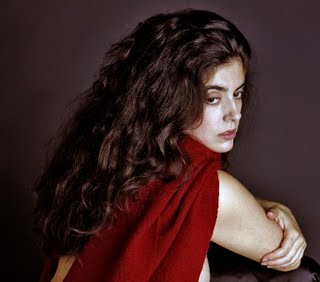
I cannot tell the class what they should do to develop a style that is their own but I can look back to what I did (without really knowing what I was doing ) which brought me to have a style.
It is obvious that in our contemporary world there are more photographers than ever before who are no longer stifled by being able to appear in hard copy. Pictures can now be "published" and placed on the web.
Just like many Japanese cars look like Audis and many a Mercedes looks like a BMW there is a fading away of a unique style not only in car design but in conventional TV entertainment. The same has happened to photography.
How is it possible to take unique pictures if thousands upon thousands have the same equipment you have?
My style came when I eschewed my 35 and opted for the 6x7 camera. I was one of the first in Vancouver to use a Chimera soft box and I am still one of the few who uses spotlights (both focusing and Fresnel) with gobos. I use a ring flash in a different way that came about by an accident.
But if I would narrow down what it is that I do that gives me as style it is:
1. I have never used zoom lenses.
2. Any lens is a portrait lens, especially a moderate wide angle. The lens that gets you closest to your subject will in the end be the best one.
3. I consider the photographer to be no different from that of a cook. This means that while you might specialize in one thing (sea food could be an example) you must know how to do everything else with some good level of confidence. Photographers must look at what they know how to do just like a mental recipe book. You cook what is needed and you must accommodate that one person who says she is a vegetarian just when you put the roast beef in the oven.
4. The ignorant photographer will be a lousy photographer. The more you read, the more you look at paintings and photographs, the more you listen to a varied repertoire of music, the more hobbies you have such as gardening (that’s my case) the more original you will be in the execution of your photography. You will get along better with those you deal with you and your arts awareness and reading will help yo connect with your subject.
5. I don’t think it is possible to have a unique style unless you are prepared to light your photographs.
6. Not bracketing and making sure the exposure is the correct one means I took fewer pictures. Shooting fewer pictures to me meant less expense and to you it will mean less work in post production after you shoot.
7. The revolving back on my 6x7 forced me to think in vertical and horizontal versions of every shot I took.
Today we will look and critique your past efforts. I will bring hard copy photographs for you to look at and you must not be afraid to ask how they were taken. The only secret I will not reveal (even though I try a lot) is that the key to my photography comes from inside and not from equipment. It comes from connecting with those I photograph.
You might consider that in this perfect world of the perfect photograph, the flaw, a flaw, might just be what will point you in the direction of style.
And you must not forget that:
The medium suggests the method. I will explain this in class today.

When Rosemary really nags me (and she did yesterday) to pick up all the unknown envelopes in my basement room floor, where I keep my photographic filing cabinets, I go down and file for a while. She is absolutely right as I have not vacuumed the room for a long time. It is impossible to navigate around the photographs, the envelopes and the unidentified negative sleeves. Filing can be an adventure and a surprise when I find stuff I had forgotten about. Or it can be depressing when I find material that could be defined as a failure. It is particularly sad when I cannot remember the people in a strip of negatives or a sheet of slides and I throw them away. By throwing them away I am relegating these forgotten people to a final death. I have always thought that if you have the names of the people under old pictures in family albums those people are somehow alive. When we can no longer remember the woman sitting by the ferns in a Victorian sitting room and can only guess that she could be a great-great aunt then her existence inexorably fades and is no more.
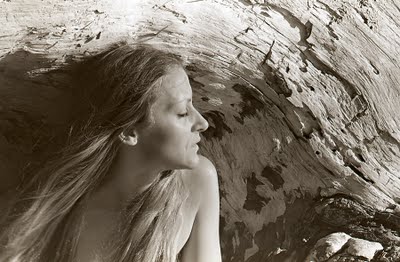
One of the envelopes I found last night was indentified as French Woman with Log. I know I took the pictures on Wreck Beach and I know the period of time to be somewhere in the late 70s or very early 80s. It was then that I was obsessed with the way skin was rendered by Kodak b+w Technical Pan Film.
I remember that the woman was indeed French and that somehow she and a man had come from Paris and knew someone I knew. Rosemary and I took them to Wreck Beach. In some of the other frames I can discern a bikini on the French woman. I don’t remember anything else except that I was struck by her profile as that is all I took, profiles except for the one below. When I took it I remember telling her that with her eyes closed there was a passing resemblance with Napoleon's death mask.
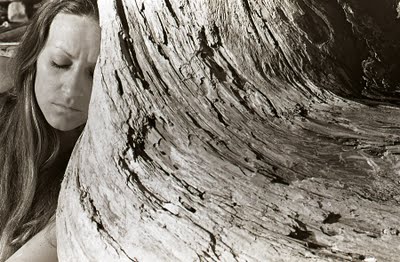
I will file her in my nudes section (even though I was much too shy to have asked her. What an idiot I was!) and the file will be named, as it was, French Woman and Log. I will linger for a while in life and some day someone will look at a picture of me and not know it was me. But I do know, at least for now, that I am the man who photographed the French woman and the log.
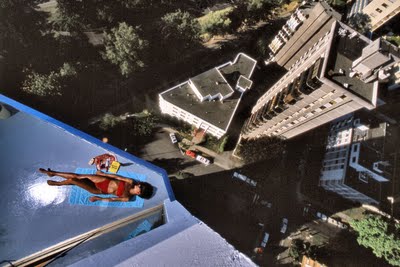
In 1986 Vancouver Magazine’s editor, Malcolm Parry came up with the project of having a spread of photographs taken in Vancouver that would be done in the style of a big budget magazine like the National Geographic. The issue which was to come out in the summer was to reflect the sophistication of our city to all the visitors that would come to Expo 86. I was given the job of directing the project and finding photographers to do the jobs. I did a couple of them. These shots were called Hot Shots by Malcolm Parry.
How I came to shoot the picture here is in my memory. I remember the camera and lens (Pentax MX and a 15mm rectilinear wide angle lens). I don’t remember how I came about the concept. Once I had the idea of a beautiful, lightly dressed young woman sunning herself on a West End roof I asked Vancouver Magazine fashion editor, Linda Guthrie if she knew of a possible woman who would fit the bill. She told me of a woman that had a “tight” body and would be perfect for the shot. She ended up being Katheryn (when I met her she was still at her Cathy stage) Petersen of whom I wrote here and here and John Lekich wrote about her here.
I am not all that happy with the picture nor was I happy then. Since I had to use a powerful hard flash to light the scene from the edge of the higher roof I ended up with the unsightly hot and bright spot at Katheryn’s feet. I could have avoided this by centering my flash better and then checking the picture with a Polaroid on my bigger camera. But I am still happy with the little private joke of including William Gibson’s first novel Neuromancer as part of her reading material. That British first edition is now worth around $1500.
As Katheryn Petersen left the scene in her bright red pickup it occurred to me that I wanted to photograph her again. As you all know this is something that I did do again, many times.
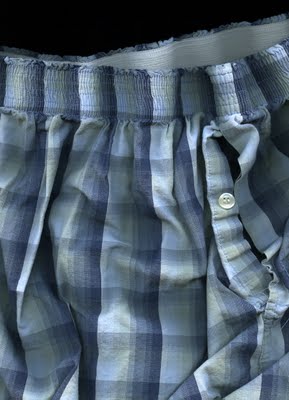
When the British Navy was steaming towards las Malvinas (the Falkland Islands) in late May of 1982 a very smart Vancouver Magazine editor, Malcolm Parry had coaxed a story from me on my experience in the Argentine armed forces (in my case the Argentine Navy). The magazine was out at the newsstands before Thatcher’s fleet had arrived. It ended with an inevitable defeat of the Argentines in June of that year.
I don’t remember most of the conversation but I do remember that Mac called me to his office and told me that if I had one story in me this was going to be the one. I remember his passion in how he coaxed me into writing the story.
The first copy of the issue I saw at the magazine stand, in the first days of May, at Eatons in Burnaby’s Brentwood Mall. The cover portrait of a youngish Argentine sailor (me) stared at me. It had been taken by the peripatetic Mac, I immediately put on my sun glasses.
That first story, how odd that my first written piece would be a cover story was followed by many others and though many may not know this I wrote extensively for Vancouver Magazine, Western Living. In the latter magazine I wrote a monthly garden column for over a year. I wrote for the Straight, for the CBC’s early version of its web arts magazine and I wrote many features for the Vancouver Sun including one where I equated sex with ballet and another about female cellists not being able to play straddling the instrument until the beginning of the 20th century.
While Mac may have been the initiator of my writing career there were two others who helped me on the way.
John Lekich gave me one very important tip even though I knew I could never write the way he does. Lekich has a mastery of elegance, style and knows how to drop adjectives in the right places. The tip would be an obvious one to most except for me. Lekich said that I should mirror the beginning paragraph of anything I wrote with some sort of mentioning of it at the end of the story. It was like wrapping up a story, a way of resolving it all by the end.
Les Wiseman, an associate editor at Vancouver Magazine and a great rock columnist (In One Ear) had more details on the craft of wrting. This was his formula (a formula that has served me well):
1. Write about that which you know.
2. Unless you are Dickens never begin in the beginning but somewhere in the middle and then go back and forth.
3. For profiles get facts on the person and divide them into categories such as quotes from friends, quotes from family, quotes from publications, etc. Make neat piles on the floor and then begin here and there until you finish your profile. The built-in randomness will keep the interest of readers.
4. Do lots of research.
I soon learned that Wiseman had in some indirect way been correct even when I though he was wrong. He had often told me that I could only write about that which you know. But if you combine that concept with the idea of extensive research then you can write about that which you are completely ignorant by interviewing or consulting an expert on the matter. My Vancouver Sun essay on playing the cello involved my talking to two well-known female cello players.
I am most thankful to these three men for having helped me in adding an interesting bifurcating path from my carreer as a photographer. I owe them plenty. But I must point that it hasn't been an entirely one-way path. While Malcolm Parry never did learn anything from me (if he did, he’s not talking) both Lekich and Wiseman are eternally in my gratitude for having introduced them to the unrestraining pleasure of boxer shorts.
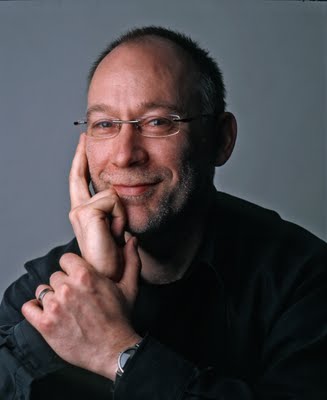
It was almost a tough choice for my Friday night activity. The unveiling of the new National Broadcast Orchestra (formerly the CBC Radio Orchestra and formerly the Vancouver Orchestra) is playing tonight at the Chan Centre and offering new works by Canadian composers.
My other choice was Early Music Vancouver’s Sonata Project featuring Johann Sebastian Bach's Sonatas from the High Baroque. The performers are Marc Destrubé on baroque violin (formerly the Musical Director of the Pacific Baroque Orchestra) and Alex Weimann on harpsichord (the new Musical Director of the Pacific Baroque Orchestra). In the end musical intimacy in an intimate locale won out. That, plus the fact that the venue, Unity Church, 5840 Oak Street happens to be across the street from Kaplan’s which serves up the best Montreal smoked meat sandwiches in town. Best of all this if a few blocks from my house so my friend Graham Walker and I will walk to dine at Kaplan’s with enough time to cross the street to listen to the pre-concert talk at 7:15. The concert begins at 8.
There is a good possibility that we might run into Marc Destrubé at Kaplan's. But not with Alex Weimann as he is a vegetarian who would starve on a diet of kosher pickles.
Intimacy won out and the first reference point that comes to mind is the 50s “pianoless” quartets of Gerry Mulligan with trumpet player Chet Baker or Art Farmer (my fave). Without the piano, the sax and trumpet solos could not be just that. There was the necessity of a constant accompaniment by the other instrument. When I listen to Gerry Mulligan’s What is there to Say with Art Farmer they (Art Farmer and Gerry Mulligan) seem to be talking to each with their instruments. They seem to be in my living room and I feel warm with the comfort of being with friends.
It’s not because I happen to have photographed both Destrubé and Weimann and I do know them a bit that tonight’s concert will seem like a Gerry Mulligan/ Art Farmer in my living room concert. It is because these two men, who not only are friends but they, also know their music and have played together lots of times. Like Art Farmer and Gerry Mulligan they cannot hide behind the sound of many other instruments. The concert will be collaboration between friends. I can think of no better collaboration than the sharing of a Bach sonata.

While I think I have a good ear I rarely do hear that harpsichord in the background of a larger baroque orchestra. And when I listen to a solo harpsichord I can really not discern the personal style of the soloist. In short I am not a lover of the harpsichord. The idea of being on a desert island listening, only, to solo harpsichords would drive me into insanity far more quickly than noise did to Vincent Price as Roderick Usher in the 1960 film The House of Usher.
But thanks to previous concerts by the Pacific Baroque Orchestra directed by Alex Weimann I am warming up to the instrument.
Adding to the sense of intimacy will be the venue, the church itself. It is an extraordinary church in which little in it reveals that it is a house of prayer. It seems to be more a house of art as I peruse (as I have in past performances here of concerts by Early Music Vancouver) the beautiful Shadbolt prints that adorn the side walls. At any given time I miss, from my past, the baroque altars of Mexican churches with the flickering of candle light. Tonight Shadbolt will be just fine.
With good food digesting in our stomachs Graham Walker and I will be enjoying a concert among friends.
Beautiful notes on tonight's concert

Since I broke my Left elbow a couple of years ago I have not really been able to get the flexibility of the arm back. Putting on a shirt is not easy now as I have found. It is most difficult to hold on to the top button holes of my shirt so I can slip the buttons with the right hand. So this morning, as I was nursing lower back pain and two arthritic pinkies, I was confused when I could not lift my heavy tea mug to my lips with my right hand. I am a dyslexic so for a few seconds I was unsure which elbow I had broken. The confusion over, I found out that my right arm was stiff as my arthritis, or whatever else it is, is spreading.
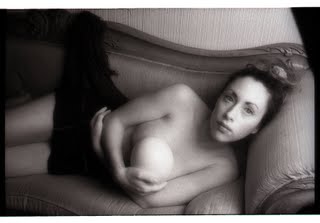
For years we have had shoe horns that I ignored and threw away. Suddenly I cannot put on a pair of shoes without one.

My physical deterioration began early. By the time I was 7 I could barely bend to touch my toes and only got as far as a bit beyond the knee. The doctors in Argentina said I had short and stiff tendons. I would have massive pain at night behind my knees. Since I am determined to end my days in bed and not in jogging gear everybody tells me “I told you so!” and I avoid most exercise. At age 67 I truly believe that anything past half a century is a bonus.

That’s bad deterioration- now for the good one.
As I was putting away the negatives away from yesterday’s blog featuring Linda Lorenzo and the fan I noticed a contact sheet that had gone through a colour change. Unless you properly wash and remove all traces of fixer from photographic paper, the paper will fade, spot, stain or change colour. This is particularly the case with what we used to call multigrade paper.
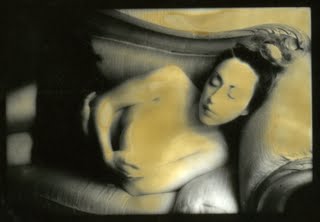
Variable contrast photographic paper was not a new thing back in the 50s. What was new was something pioneered by Ilford that was called Ilfospeed. This was paper that was coated with plastic or resin. This meant that the paper dried quickly and did so very flat. Glossy Ilfospeed was really glossy and there was no need to dry it with complicated drying machines.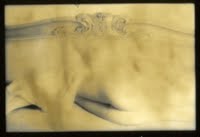 Blacks were very black which meant that Ilfospeed photographs reproduced beautifully in magazine and nespapers before the advent of scanners and digital cameras made the 8x10 glossy obsolete. Both the normal Ilfospeed and the variable contrast version called Multgrade were papers that were not really archival. This meant that unlike the good paper only (no plastic) photographic paper) these plastic or resin coated papers unless they were washed thoroughly they would stain and change colour with time even if kept in the dark.
Blacks were very black which meant that Ilfospeed photographs reproduced beautifully in magazine and nespapers before the advent of scanners and digital cameras made the 8x10 glossy obsolete. Both the normal Ilfospeed and the variable contrast version called Multgrade were papers that were not really archival. This meant that unlike the good paper only (no plastic) photographic paper) these plastic or resin coated papers unless they were washed thoroughly they would stain and change colour with time even if kept in the dark.
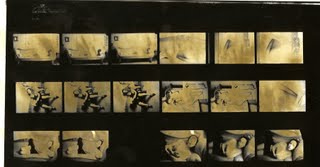
That was the case of the contact sheet you see here. The negatives themselves, which I washed for archival permanence, are pristine. These are Kodak b+w Infrared film negatives. Kodak stopped making this beautiful film some years ago and I have a few rolls in my freezer. But I must use them soon as Kodak b+w Infrared film is one of the few things that we know of that deteriorate as those illusive neutrinos pierce our globe unempeded by anything in their path.
I looked at the contact sheet and had an idea. I scanned each individual frame, of the contact sheet, with my Epson scanner. What you see here are some of the better ones which I think are really beautiful. I really did not do much to the scan except take out some of the dust that had attached itself to the contact sheet. One of the pictures is of the negative so that those of you who may be viewing this can see what happened. For me it shows that not all deterioration is of the bad type. Before the advent of my scanner I could have never been able to do this. I could even re-scan this contact sheet at a much larger resolution and have Grant Simmons at DISC produce some of his beautiful giclées. This is something that would be impossible in the normal darkroom. The only way would be for me to copy the contact’s frames with a very good larger format camera and get the best possible sharp colour transparency. And then I would still go to DISC for a colour giclée.
What is amazing as my body deteriorates is to find out that negatives that I would have never printed, since I never had the time to get to the darkroom or they simply did not look good enough somehow now have second life in my hybrid film/digital system.
I guess I can only taunt with glee my colleagues who shoot digital and tell them that their digital deterioration will be much more final and thus more painful. Those images will be, or they will not. In computers there are only zeros and ones. There are no 0.5s. There will not be any wonderful in-betweens.
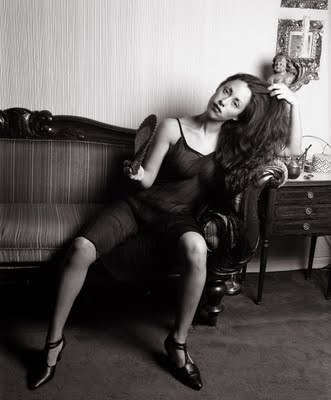
Si la mujer escondía los ojos detrás del abanico, estaba diciendo a su interlocutor que lo quería.
If the woman hid her eyes behind the fan, she was saying to her would-be suitor that she loved him.
Si colocaba el abanico sobre la mejilla izquierda, la respuesta era: No; y si lo posaba sobre la derecha, la respuesta era: Sí.
If she placed the fan on her left cheek, the answer was: No; and if she placed it on the right cheek the answer was: Yes.
Si la mujer se abanicaba con rapidez, significaba que estaba comprometida; y si lo hacía lentamente, le transmitía que estaba casada.
If the woman fanned herself quickly it meant that she was engaged; and if she fanned herself languidly, she indicated that she was married.
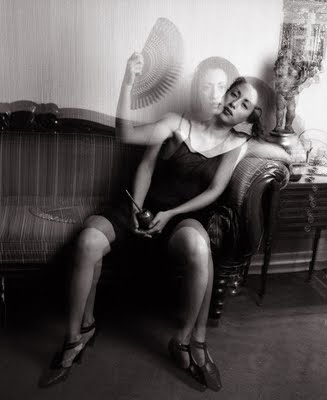
The foldable fan was invented in Japan in the 7th century. From there it spread to Europe where it was commercialized. It was particularly important to Spanish culture. From Spain the fan traveled to the Americas. It was and is primarily used by women although in some cultures men use it, too. In the 18th and 19th century the fan was widely mentioned in literature and was an important element in painting.
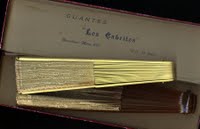
In Spanish literature of the 19th century and 20th century, especially in Seville and Granada, there are many references to be found on fan lore including the special significance on how women communicated with each other and with would-be lovers with the fan.
Both my grandmother and mother who had been raised in the tropics of Manila were experts with their fans. They could close and open them with a deft flick of the wrist. It made a little noise, a swish that seemed to me magical. Even though I attempted to master the skill (I believe it is an art) I failed. Every once in a while I like to open the two sandalwood chests (and smell the inimitable fragrance that I relate to an exotic past of my family in the orient). The chests (my grandmother called them "my camphor babies") have been part of our family since the early 30s. I like to open the various little cardboard boxes (Spanish or Argentine chocolate boxes and here an Argentine cardboard glove box ) that contain my grandmother and mother’s fans. Some are from Spain and some from the Philippines.
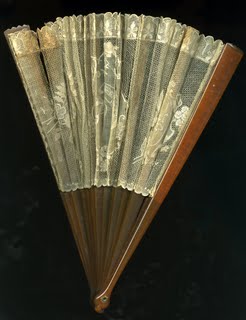
There is a very beautiful one from the Philippines of turtle shell and the cloth material is a delicate but tough fiber called jusi which is made from Chinese silk. This fan was my great aunt’s, Buenaventura Galvez Puig. A few years after she died my mother and her younger sister Dolly argued as to who was going to inherit the beautiful fan that had Buenaventura's initials in diamonds and emeralds (you can see where they were on the upper right hand side of the fan). My mother graciously (smart in my opinion) suggested that Dolly could have the jewels and she (my mother) would keep the fan. Dolly immediately pried them out. The fan’s jewels have been long pawned but I (via my mother) still have the fan.
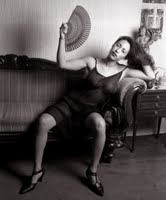 The word for fan in Spanish is abanico which is a diminutive of abano which comes from the Portuguese. The verb abanar in Spanish is used when one is describing, as an example, fanning a fire. But if one fans oneself with a fan (an abanico) the verb is the beautiful sounding abanicar. Me abanico (I fan myself). Or, “Amor, abanícame.” My love, fan me.
The word for fan in Spanish is abanico which is a diminutive of abano which comes from the Portuguese. The verb abanar in Spanish is used when one is describing, as an example, fanning a fire. But if one fans oneself with a fan (an abanico) the verb is the beautiful sounding abanicar. Me abanico (I fan myself). Or, “Amor, abanícame.” My love, fan me.
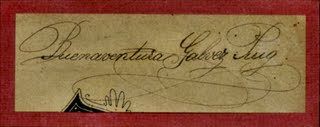
The first alternating current electric fans came into use in 1891. Spaniards and Argentines call this “new” and modern development a ventilador. Mexicans may be a bit more conservative or simply just more romantic as they call electric fans abanicos. The very Argentine Linda Lorenzo seen here was most competent at flicking her fan open and closing it.
Lady Windermere's Fan

propter quod Angeli vocantur of caelis adnuntiandum hominibus ad mittuntur. Angelus enim Graeca, Latine dicitur Conscientia.
Angels are called because they are sent from heaven to announce to men. It is said in Greek and Latin nuncio angel (sent to announce).
St Isidore from his Etymology V The Angels
A la cena y a la cama sólo una vez se llama. You are called only once to bed and to dine.
Chilean proverb
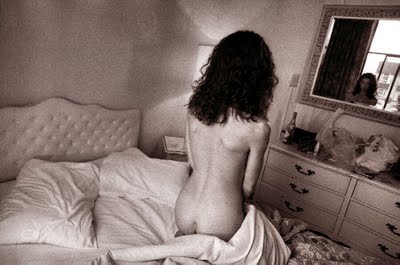
Saint Isidore of Seville (570-636) was a bishop and a Doctor of the Church. He wrote about just everything from medicine to a book about the classifications of heaven’s angels. He attempted to catalogue what was then known to man in 20 books called De Los Orígenes (Of Origins) and he wrote the first encyclopedic dictionary. He divided his Of Origins into 20 books each on one category:

1. Grammar 2. Rhetoric and Dialectic 3. Arithmetic, Geometry, Music and Astronomy 4. Medicine 5. Laws and time 6. the books and laws of the church 7. God, angels and men 8. the church and sects 9. languages, races, kingdoms and the armies 10. words in alphabetical order 11. man and monsters 12. animals 13. the universe and its parts, or cosmology 14. the earth and its divisions or geography 15. cities, fields and roads 16. minerals and metals 17. farmers and gardening 18. war and games 19. ships, buildings and clothing 20. Food and its tools.

For our purposes St. Isidore figures here for two very good reasons. He was the first to coin the word in Spanish cama (bed) from the Latin camba for a narrow bed used for sleeping or, as the Romans so much enjoyed, for eating.
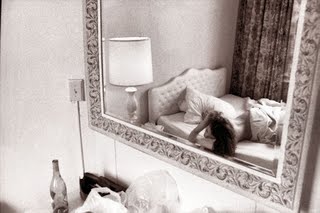
Because it was St. Isidoro (Spanish for Isidore) who really the first human to attempt to compile all human knowledge, Spanish scholars have declared him to be the patron saint of the internet. I would offer no objection seeing that this man knew about everything and beds, too. Thanks to him I can justify placing here these delighful pictures of Katheryn and the bed from room 618 at the Marble Arch Hotel.

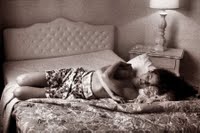
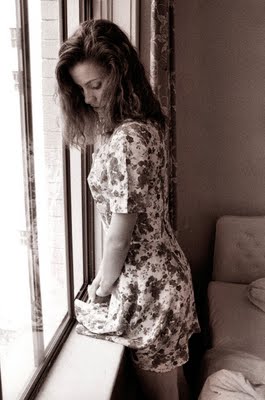
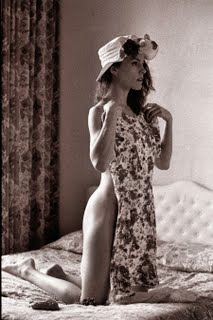

In 1951 when I was 9, Eva Perón came to our school to plant a tree. I was dazzled by her blonde hair. While I was close enough to observe most of her features I was too shy and we were much too controlled by our teachers to dare say anything to a woman that my family loathed.
At the time we were living in Coghlan on Melián Street. Our neighbours were staunch Peronists. In Argentina we have two independence days. One is on the 25 of May and it represents Argentina’s initial separation from Spain in 1810, when the Argentine born Spaniards, the criollos, refused to accept Napoleon’s brother Joseph as King of Spain. The second date is 9th of July when Argentina formally declared its independence in 1816. In Perón’s time (and 1950- 51 was certainly Peron at his apogee) this resulted in two military desfiles (parades) complete with Sherman tanks and other obsolete equipment. This meant that both Perón and his wife Evita would shout their speeches and our neighbours would play the radio really loud. I remember listening to Perón ( I couldn’t avoid it as I played a lot in the garden) and that his voice would fade and Evita would take over. My grandmother who never really swore in my presence would only say, “Esa mujer,” “That woman.” I never heard my father say anything about Perón (that I can remember). All I knew is that there would be lengthy periods of time when my father was not at home. My mother would say to me, “Your father is at Villa Devoto (the local jail) because he wrote an article about Perón in the Buenos Aires Herald that Perón did not like." The Herald was the English language daily my father worked for.
I didn’t know then that my family; on my father’s side were the oligarchy that Evita was attacking. Even today the landed oligarchy, the military and the church are the three most influential powers in Argentina.
On my mother’s side my uncle was married to Sarita Lopez Colodrero. Her aunt Raquel held meetings in her house on Avenida Santa Fe for many years in secret plottings for getting rid of Perón. One of the frequent plotters was General Eduardo Leonardi who finally stepped in and instigated the 1955 coup that eventually made Perón escape in a Paraguayan gunboat to exile. Raquel and her relatives all had extensive land holdings in the Province of Corrientes. I remember listening to them on how Evita was expropriating land to then sell and use the money to give to the poor and to build her charity foundations.
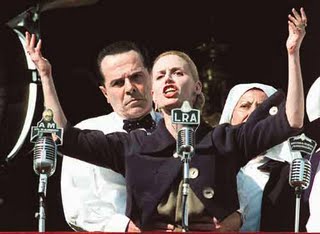
It was about this time that my grandmother told me that a famous Argentine actress Libertad Lamarque ( a strange name that translates to liberty marks her) had to go in exile to Mexico (where she became very famous) because she had called a bleach-blond minor actress a puta (whore).
As 9 or 10 year old I really had no opinion on the Perons except that I loathed the wooden toys that Evita gave to all children (including me) on January 6 or día de los reyes (Three Wise Kings Day).

When Evita died in July of 1952 that I began to learn some things. The radio stations (including LRA, the government owned station that played classical music) played funeral music. It was when I first heard Chopin’s third movement of his Piano Sonata No. 2. I remember seeing the wake (called a capilla ardiente or flaming chaplel by Argentines) and the march (with black horses with tall black plumes) in the propaganda shorts we were subjected to at the movies. And then in the evenings every day for almost a year all radio programs would be interrupted at 20:25 PM and a voice would say, “It is 20:25 the hour when Eva Perón, the spiritual leader of the nation assumed immortality.” Shortly after Perón started tightening his repression of the press and when his masses of descamisados (the shirtless ones) started burning churches, the Catholic Church and the Navy (the real blue bloods of the Argentine armed forces) decided Peron’s time was up. It was then that my grandmother advised my mother that we should leave for Mexico. This we did even though I wanted to stay with my father. I was given no choice (and what did I know I was only 13) we got on a Pan American Grace Airways DC6-B which took us to Santiago, Lima, Panama and Mexico City.
I saw the Madonna film version of Evita and I hated it. A week ago I found at the Vancouver Public Library in the books in Spanish section the DVD film (1996) Eva Perón directed by Juan Carlos Desanzo. I tried to get my wife and Rebecca interested on Saturday afternoon but after 10 minutes Rebecca complained that the Argentine Spanish was indecipherable and the subtitles just as bad. I turned it off.
I turned it on in the evening and saw it alone. I was hit by nostalgia and an appreciation of how good a well made film can be. This is an excellent film. I was hit by a sadness knowing I know nobody in Vancouver I can share the experience of discovering this film that tells the story of a woman who without my knowing had become part of my life.
The picture you see here I took some years ago of Argentine model Linda Lorenzo that was in the spirit of the elegant Argentine women I remembered from the 50s. I now notice that theres is some Eva Perón in it, too. In the other pictures you see the actors Victor Laplace and Esther Goris who play Perón and Evita in the film. The picture with Perón shows Perón propping up the very sick Evita while her nurse is there just in case. A few months later Evita was dead.
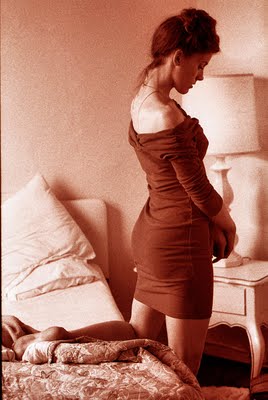
Lessons at the End of a Long Hallway
by John Lekich
Despite all the fuss over social networking, there is one feeling that being alone with a computer will never accomplish. You could have a thousand friends on Facebook and it will never duplicate the sensation of being surrounded by attractive, intelligent people in a bar that has come to feel like home. Alter this statement slightly – making it attractive, intelligent women - and I would happily go back to the days when the very idea of a mouse sitting on my desk would have sent me running for the nearest exterminator.

Many years ago, Alex and I hosted regular Thursday lunches at a place called the Railway Club. An establishment that – as far as I know – still has the longest bar in Vancouver. Getting from one end of the room to the other was like traveling through a tunnel lined with convivial beer drinkers. Since our regular table sat nestled at the farthest end of the room, the arrival of our dining companions could be seen from many feet away.

Thanks mostly to Alex’s legendary range of friends and associates – we regularly found ourselves in the company of many extraordinary women. I soon discovered that watching the approach of an attractive, smiling woman from the far end of a very long hallway was a bit like observing a mirage. For a second or two, you were never quite sure whether the vision coming your way was real or not. And then the smile would get closer - and closer still. Until that sublime moment when you realized two rather delightful things simultaneously. The smile was not only real but actually meant for you.
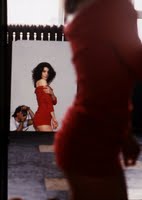
As a byproduct of this process, I learned a great deal about women and their wardrobes. In fact, my experience at the Railway Club reinforced an early sartorial theory of mine. Having grown up with four sisters, I quickly understood that women employed the contents of their closet in an entirely different way. While men tended to stick with the singular look they were most comfortable with, women used clothes to express the many different aspects of their personality.
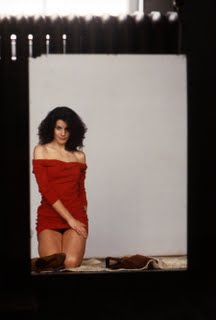
The one exception to this rule seemed to be Katheryn – a Railway Club regular who combined a great long distance smile with the no-nonsense elegance of Katherine Hepburn. I recall her favouring crisply-pressed slacks and a refreshingly direct manner to match. I quickly pegged her as a sartorial pragmatist who had no time to waste on cultivating different looks.
This, of course, is the same Katheryn pictured so alluringly here. (In a manner, I might add, that has nothing to do with slacks or pragmatism of any kind.) The lesson? When it comes to women - and what they choose to wear at any given time - making assumptions can be dangerous.
John Lekich, January 2, 2010
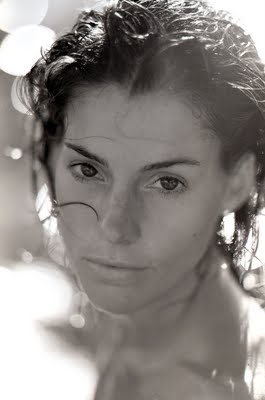
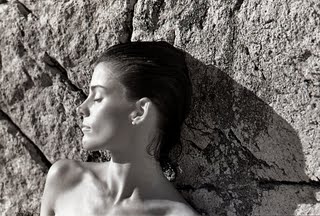

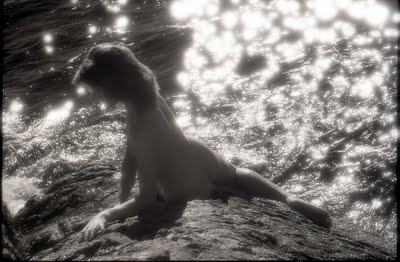
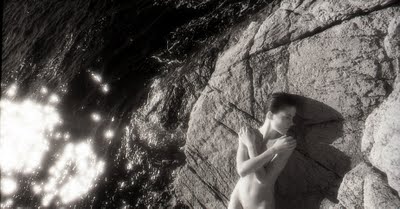

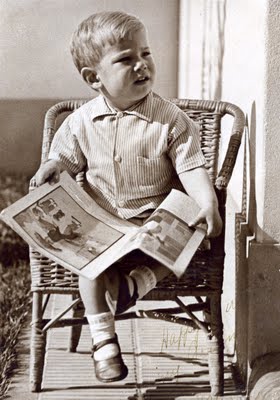
This coming September the lease on our Audi A-4 will end. There are not enough funds left at the bank nor is my credit rating good enough that I might wangle another lease on the superb car that the Audi is. A more likely scenario for September will be the buying of an extremely used clunker using the better credit of my daughter Ale. After all she has a job. She is a school teacher. As my 20th century begins to fade from my memory I think that the end of the Audi lease is but an indication of what is in store for Rosemary and me in this 21st century. What is in store is not all black!
What is in store could be exciting. If I stay alive for a few more years (if the powers that be nudge benevolently in my direction) Rosemary and I will be hopping into an electric car that will have a constant connection with the internet. I will tell Rosemary, “I think that today our car will be a Ferrari. I am going to download using our car-noise-effects apps, the sound of a Ferrari Testarossa.” Until pedestrians are given some other way of “hearing” the silent electric cars, the folks at Apple will be making a fortune with those car noise applications. It was but a few months ago that crossing the street after visiting my friend Mark Budgen in Strathcona I was almost run over by a perfectly silent electric scooter.
I have no idea how “green” engineers will solve the problem of air travel. I would be the last who would trust a Boeing/Prius hybrid jetliner. I will not want to travel by air. I will not want to suffer the indignities of some pilot telling us, “Passengers we will be executing a steep dive in the next few minutes to re-charge this aircraft’s batteries.”
Google has failed me in my efforts to find out exactly how much jet fuel is consumed by all the airlines of the world (and air forces) in one day. I would like to compare that figure with the world consumption of automobile fuel.
While I am no Graham Greene I do share with my favourite author (now deceased) a realization that we have lived in a tumultuous era of great transition. As Paul Theroux headed his beautiful obituary to Greene (when he died in 1991), an Edwardian on the Concorde.
I never did ride on a Concorde but I did travel in everything from a DC-3 (and a military version the C-47 through a generation of airliners, DC-4, 5s, 6s, 7s, Constellations and Super-Constellations, and jet liners from the Comet 4’c to a rare Convair 990. I flew on Panamerican World Airways, TWA and a De Havilland Beaver on Tyee Air.
As a child I rode in wooden English trams that were almost brand new and had my class picture taken in the second grade (segundo superior) with a photographer who used magnesium flash powder. I have "taken pictures" of most of the roses of my garden neither using a film camera or a digital camera but a scanner.
A claoaquero came once a month to clear our sewer pipes, milk and butter was delivered by a horse and carriage and the hielero brought a block of ice every few days for our icebox. It was in 1955 when I first used a telephone and my grandmother purchased a Zenith televison set. At the time she was typing letters to her friend with a Remington portable but when I saw an IBM Selectric in the 60s I could have never seen the advent of my very own Smith Corona word processor that was soon superseded by PCs and Word.
My heroes were el Llanero Solitario (the Lone Ranger), Gene Autrey and Roy Rogers and I do believe that in 1950 I was the only boy in Buenos Aires who had a pair of genuine Texan cowboy boots complete with spurs. I am not sure what role models my Rebecca has at the moment. At the very least I can appreciate that they probably don't pack six shooters.
On June 2, 1953 my mother called me for lunch. I had my head glued to our wireless (as my father called it). I responded, “Mother I am listening to the coronation of my queen.”
In my time I have ridden in an origianl WWII Jeep, Packards, Studebakers, DeSotos, Plymouths, Henry Js and driven myself a Chrysler Imperial with a pushbutton transmission. I have even been a passenger in Auburns and a Pierce Arrow with vacuum ash trays.
At age 67 I still cannot accept, really understand yet not thrill at sending by e-mail a 9 meg file scan of one of my film photographs to a magazine and then see it is as hard copy ( I have learned the lingo of these times) on the cover.
At age 67 I believe that the two most momentous events of our modern times have nothing to do with the atom bomb. It was said that the bomb put us in the unique situation of being able to destroy the planet we live in. The writing has been on the wall for some time. The A-bomb might provide a quick exit for us but our very existence on this planet is doing a equivalent job of replicating the same results albeit in longer sidereal time.
The invention of the contraceptive pill in the 60s only helped the folks at Time that God was suddenly dead. If it wasn’tquite the demise of our creator it was the end of religion as we knew it. Most of the rules of behaviour of many of our planet’s religions were created to placate man’s (as in the male of the species) suspicions that the pregnant woman (or women of his life) were pregnant by his seed and his seed alone. The pill took care of that and liberated woman to control her own destiny.
That second event, one that I marvel at quite often is that photograph of our planet hovering over the moon’s horizon. For the first time we could say in a most earth-shaking manner, “We here are from over there.”
Within limits I will not worry about my daughters and granddaughters. They will manage in spite of whatever may confront them in this century. I will give them only one piece of advice, “If you fly, make sure the airplane is not electric.”
Sancho Panza complains to his master that he has not been paid for his services as a squire for some time. Don Quixote inquires as to the time period.
“Si yo mal no recuerdo,” respondió Sancho, “debe de haber más de veinte años tres días más o menos.” Diose don Quijote una gran palmada en la frente, y comenzó a reír muy de gana. (II, 28; p. 778)
“If I well remember,” answered Sancho, “it must be 20 years and three, days, give or take. Quixote slapped his forehead [the knee slap is a North American invention] and began to laugh in earnest.

In 1975 my wife Rosemary, our two daughters and I drove up in our VW beetle from Mexico City to live in Vancouver. My youngest daughter’s urbane and multilingual (8 languages) godfather, Raúl Guerrero Montemayor told me, “Alex I am sure you will do well in Vancouver but I do remember that the fact that the people there are white does not mean they are civilized.” In those times I would have never thought that the comment was racist nor would I have taken offence. I simply laughed.
As soon as we arrived we did make some early friends who I remember invited us to “after dinner drinks.” I asked Rosemary if this was some quaint Canadian custom seeing that she had been born in New Dublin, Ontario. The concept of the after dinner drink was alien to her, too. For some time when my friends and family from abroad would ask me about Vancouver I invariably told them that the people here were as cold as the tap water.
Many of these opinions of mine have softened with time but I do miss the joviality of Mexicans and the constant embracing and kissing of Argentines. I have fond memories of my father kissing me. Do Canadian fathers kiss their sons? I am not sure.
As an alien from South America and in spite of now being a Canadian citizen I have not been able to discard the feeling that I am a penguin in the arctic living out of place and out of time.
My urbane compadre, Raúl, in spite of his extensive Swiss education finds the idea of mixing sweet with salty as a culinary aberration. He makes fun of Americans who serve cole slaw with raisins. The idea makes Raúl shake with disgust. I have learned to conquer my Latin bias and I will happily (but not with glee) consume said coleslaw or indulge in Chinese sweet and sour dishes.
In culture both Raúl and I like our singers to sing and our actors to act. We might tolerate opera buffa but like the sweet and the sour and the salty in separate areas of our dinner plate we like our stuff in distinct separation. We like Fred Astaire and Gene Kelly but that is about as far as we will go to tolerate that Anglo Saxon invention, the musical.
Which brings me to how I hate comedy and in particular the idea of going to some dark café, pay to get in and then listen to someone making jokes about East Indians in Surrey. I cannot stand stand-up comedy. I was turned off to comedy in the mid to late 50s listening to a Shelley Berman describe the look of a glass after emptying its contents, buttermilk, in one’s mouth.
I was sometime around 1982 or 1983 when the CBC hired me to shoot stills of a show that was called The David Steinberg Show which was being taped in the cavernous Studio 40 on Hamilton Street. Steinberg was a short cerebral kind of guy (20 odd days older that I am) who was not in the least funny. He oozed intelligence. He just wasn’t funny to this man who really does not understand comedy. As a child I hated the Danny Kaye films my mother took to see. I had not yet graduated from the films of the Gordo y el Flaco (Laurel and Hardy).
It was about that time that I was asked to take a group shot of comedians who had appeared that week at the show. My friend CBC cameraman Michael Varga, upon seeing the picture recognized Jackson Davies, Ryan Styles and David Steinberg (centre right with his hands on the shoulders of two companions). Varga says that the rest look a lot like Canadian Air Farce people.
There is no record on the web that Steinberg ever had a TV variety show in Vancouver yet there is this picture that must prove that it happened.
I am looking at the picture under a new light. I am looking at it under the new light of beginning to appreciate comedy thanks to what I consider the most serious show on CBC Radio One after Ideas.
What is that show? The show is The Debaters which is hosted by Steve Patterson and airs on Saturdays at 1:00pm (1:30 NT), and Wednesdays at 11:30am (12:00 NT) on CBC Radio One.
This radio show features two 15 minute segments in a 30 minute long show in which comedians (one per side) speak, in a live audience studio, for or against such topics as multiculturalism, the NFL versus the CFL or for or against the charms of classical music. Bill Richardson was superb last week defending the likes of Beethoven, Mozart and Bachman Turner Overdrive. He spoke of what classical music could do to arrest drooping titties and that immediately made me realize that The Debaters can get away with saying such things, debating seriously important topics that affect Canadians that are not the grist of conventional media. Particularly funny and paradoxically more serious is the second round calle the Bare Knuckles Round and when all stops are removed and the for or against participants go at each other's throats. While the show is really funny (I admit it!) it makes me think. If I were a CBC honcho I would turn The Debaters into a TV show and or ax Rex Murfy and have Steve Patterson host Cross Country Checkup. Because The Debaters travels across Canada they are a more relevant, and a more important variation of what Cross Country Checkup should be but is not.
Because of copyright reasons, since The Debaters is a contract show and not a CBC show there are no podcasts available (just a few tantalizing clips) but you can buy complete shows from iTunes. I think that I just might buy and listen to some of them while indulging in coleslaw with raisins.
CBC Ideas: with Paul Kennedy
Thursday, December 4, 2009
LAUGHTER: THE SECOND BEST MEDICINE
Dr. Robert Buckman, author of Cancer is a Word, Not a Sentence, takes his science very seriously. But in an evening recorded at the CBC’s Glenn Gould Studio in Toronto, he says that finding – and tickling – our funny bone is definitely good for our health.
A Baby Doll - Grace & Beauty
Tuesday, January 19, 2010

When Elia Kazan’s film Baby Doll (story and screenplay by Tennessee Williams) opened in 1956 at the Cine Roble in Mexico City I was much too young (14) to see it. In 1959 I went with my sometimes pious grandmother to see The Miracle with Carol Baker and a young Roger Moore playing a soldier from Wellington’s army. The film was sort about the Virgin’s apparition in Lourdes and my grandmother told me about secrets that had never been divulged which were probably all about the end of times. My grandmother stressed it as “el final del mundo”, so I should have perhaps capitalized that to the End of Times. In 1959 I was enamoured with Grace Kelly (she was on the pedestal) and I lusted over Brigitte Bardot (she was definitely off a pedestal as I wanted to look down and stare at her cleavage). Carroll Baker simply did not register in my mind and I really never did notice her in Giant.
In the late 50s my only other knowledge of Carroll Baker were the spoofs of her, sucking her thumb (the most notorious memory that people have of Baker’s performance in Baby Doll) that I saw and read about in Mad Magazine. In the 70s and 80s there were serious essays in Playboy that were often illustrated with that picture of Baker in her crib.
I am sure that my friend John Lekich (a walking film encyclopedia) could clue me in on Baker’s subsequent career. I notice that she did play Jean Harlow in a film. I never saw that film nor can I remember any other that might have had Baker in the cast.

All that changed yesterday when I saw an extremely clean and sharp print of Kazan’s Baby Doll on the Turner Classics Channel. At first I could not figure out who the incredible and sensuous blonde being seduced by Eli Wallach was (looking very young, very Sicilian and very nasty). The scene was near, and on one of those tandem wood swings that usually occupy decandent American porches of the South. As Wallach talked and filled the young woman’s ear with sweet platitudes I noticed the woman begin to breathe ever so more quickly until she almost swooned. This was one of the most extraordinary performances of a woman acting out desire that I have ever seen. It was at that moment that I figured out that I was watching a Williams play, and that the blonde was Carroll Baker. In how many films can one watch Wallach spar with Karl Malden? They looked like friends (probably the case off screen) doing what they knew how to do best, act. The music including a black man sitting on the floor on a porch, stomping his feet, playing a harmonica and singing was superb. I was mesmerized by the film and Baker became a revelation. I immediately consulted my only remaining collection of hard copy movie reviews, Pauline Kael’s 5001 Nights at the Movies (remember I am a self-confessed snob) and I found out that she was delirious in her praise for this film.

A week before I had found an 8x10 glossy of Hilary. It is the first picture you see here. I finally located the negative today and found I had taken it on Mayne Island in 1986. It was in that year that with some money in the bank Rosemary and I commissioned artist Jim McKenzie to paint our two daughters. He photographed them on the ferry on the way to his home on Mayne Island. I took pictures of the proceedings on the ferry and on the island, too.
On Saturday night while having dinner with Rosemary, Hilary, Rebecca and Lauren, Hilary removed her glasses. In spite of being tired after a long day as Wellness Manager and Consultant at Stong’s (while wearing the sexually ambiguous black uniform of her place of work) I was struck by her beauty. As soon as I returned from taking them home I removed the 8x10 from our family photo bin shoebox and stared at it. I had to find the negative. I did.

My mother was no raving beauty but she had legs, a body, a smile and grace in spades. I was often told that all I had inherited from her was her crooked smile. I must reveal here that, yes, I also inherited her legs and her beautiful feet. As for being handsome the only person who has ever directly told me I am handsome is the unrelentingly fastidious freelance editor Grip, Maja Grip. What this means is that any beauty in our family must come from my wife Rosemary. Everybody tells Hilary she looks like me and that her smile is as crooked as mine. This would mean that Rebecca’s grace and beauty came from her father or from my wife via her mother but not inheriting from her mother.
When Hilary was born, my mother looked at her and diplomatically said, “What beautiful hands she has.”
It was in 2009 that Hilary’s daughter quite rudely overstepped he boundaries of being a daughter ( an almost forgivable sin coming from someone that is not yet in her teen years but acts like one who is well into them) and in many words told off her mother (in my presence) that she had no grace and did not know how to dress.

As I look at the many pictures I have taken of Hilary but never really printed my eyes have opened to her beauty and grace. While watching Carroll Baker’s performance in Baby Doll I was reminded of my own daughter’s sensuality which obviously I had suppressed since I was and am her father. But I can see that seriousness. I can see her natural ability to not smile unless prodded and I can see in her all the beauty and grace that her daughter Rebecca has inherited from her. That so many say that Hilary’s other daughter Lauren looks exactly like her mother, bodes well. This means that Hilary's two Stewart daughters will have grace and beauty in a long suit of hearts.
And if I were Rebecca I would find ways of making amends. After all the image that she sees on the mirror could well be her mother’s.
The Dame, A Coyote & An Almost Cardiac Arrest
Monday, January 18, 2010

In 1987 Globe and Mail arts writer John Lekich and I had an appointment with American actor Peter Coyote at a movie set that was that old restaurant in Gastown that featured bad food serve by waiters dressed in monk’s habits.
While waiting for Coyote to show up a tall blonde woman appeared wearing a very tight silver satin dress, high heels shoes and a Ninotchka hat. She sat down in the chair you see here, lit up a cigarette and calmly stared at us. She looked like a woman that Humphrey Bogart would have called a dame. I managed to get some nerve and asked her if she would pose for me telling her, “We are waiting for Mr. Coyote and my lights are all set up.” She agreed and posed. I could see the Lekich licking his lips. She was, indeed a dame.
Coyote finally appeared and sat down for his photograph and Lekich did his interview. After what had been a pleasant afternoon I decided to pull a trick on Lekich as I was packing my stuff. At the time I had been having problems with my Mamiya film backs so I kept an old roll of film in my bag to test the system. I took it out and told John, “Here are her pictures,” and I proceeded, with great drama to unroll the film in a flourish and expose it to light. Lekich almost had a cardiac arrest. I explained my joke. He relaxed.

It was when I got home that I realized that I had exposed the real roll of film, the one of the dame.
Yesterday I dropped off film at The Lab. I was to take 12 rolls. Four were from a job for the Salmon Marketing Council and the other 8 were portraits of the new NDP MP for Coquitlam/New Westminster, Fin Donnelly. I counted the rolls. There were 13!
When I picked up the film I realized upon seeing the pictures of Rebecca and of our fall garden that somehow the roll had remained in a corner of my bag, unnoticed.

The surprise made me think of the Coyote incident and how, while the picture of Rebecca is not one of my best of her it still is a surprise. Perhaps I will be around when she indeed will become a dame and dress in satin, heels and a Ninotchka hat. If that happens I will make sure I get my shot.
The fall picture of the garden features (at the bottom) Hosta ‘Northwest Textures’ and, above, Kirengeshoma koreana.
Brother Edwin Reggio, Blaise Pascal & Claire's Knee
Sunday, January 17, 2010

It was two in the morning last night when I found myself not being able to sleep. One word was in my head, Pascal. In the last few days I had seen his name in something and I had been struck by a quote of his. I could not remember. My thoughts went in circles and sleep did not come.
Blaise Pascal argued that if reason cannot be trusted, it is a better "bet" to believe in God than not to do so. He put this forward in his note 233 of his Pensées.
If there is a God, He is infinitely incomprehensible, since, having neither parts nor limits, He has no affinity to us. We are then incapable of knowing either what He is or if He is....
..."God is, or He is not." But to which side shall we incline? Reason can decide nothing here. There is an infinite chaos which separated us. A game is being played at the extremity of this infinite distance where heads or tails will turn up. What will you wager? According to reason, you can do neither the one thing nor the other; according to reason, you can defend neither of the propositions.
Do not, then, reprove for error those who have made a choice; for you know nothing about it. "No, but I blame them for having made, not this choice, but a choice; for again both he who chooses heads and he who chooses tails are equally at fault, they are both in the wrong. The true course is not to wager at all."
Yes; but you must wager. It is not optional. You are embarked. Which will you choose then? Let us see. Since you must choose, let us see which interests you least. You have two things to lose, the true and the good; and two things to stake, your reason and your will, your knowledge and your happiness; and your nature has two things to shun, error and misery. Your reason is no more shocked in choosing one rather than the other, since you must of necessity choose. This is one point settled. But your happiness? Let us weigh the gain and the loss in wagering that God is. Let us estimate these two chances. If you gain, you gain all; if you lose, you lose nothing. Wager, then, without hesitation that He is.
"That is very fine. Yes, I must wager; but I may perhaps wager too much." Let us see. Since there is an equal risk of gain and of loss, if you had only to gain two lives, instead of one, you might still wager. But if there were three lives to gain, you would have to play (since you are under the necessity of playing), and you would be imprudent, when you are forced to play, not to chance your life to gain three at a game where there is an equal risk of loss and gain. But there is an eternity of life and happiness. And this being so, if there were an infinity of chances, of which one only would be for you, you would still be right in wagering one to win two, and you would act stupidly, being obliged to play, by refusing to stake one life against three at a game in which out of an infinity of chances there is one for you, if there were an infinity of an infinitely happy life to gain. But there is here an infinity of an infinitely happy life to gain, a chance of gain against a finite number of chances of loss, and what you stake is finite.
Blaise Pascal, from his Pensées
Brother Edwin Reggio, CSC first told us about Pascal’s wager sometime in 1959 in our religion class at St. Edward’s High School in Austin, Texas. In the context of the times it seemed like a safe bet. I remember that Brother Edwin told us of the wager with a very straight face and did not push us to think about it in one way or another. Since Brother Edwin was a math whiz he explained it all with a wealth of statistics. His dissertation on Pascal was as neutral as his explanation of Aristotle’s’ “unmoved mover” and its re-interpretation by St. Thomas Aquinas. Brother Edwin was not out to proselytize but to simply place the facts as he knew them and from there we could make up our minds for ourselves.
So being awake at two in the morning and with no prospect of sleep I decided to track down the Pascal that was consuming my thoughts to an obsession. I went downstairs and fired up my computer. It opened on my home page, the NY Times. I put in the top left search rectangle, Pascal, and was instantly rewarded with the source which was a lovely paean/memorial to recently deceased French film director Eric Rohmer by André Aciman called My Nights with Eric. I had read it in the Saturday edition of the hard copy version of the Times. If you have access to the online version you can find it here. It is beautiful.
The quote in question was:
With Eric Rohmer, as with Mozart, Austen, James and Proust, we need to remember that art is seldom about life, or not quite about life. Art is about discovery and design and reasoning with chaos. If there is one thing I will miss with Eric Rohmer’s death, it is the clarity, the candor and the pleasure with which one human can sit with another and reason about love and not forget, in Pascal’s words, that “the heart has reasons that reason knows nothing of.”
I must confess that I have never seen one Rohmer film but I have been affected by a still image (I first saw it so many years ago in film reviews) of his film Claire’s Knee. I reproduce it here and hope that nobody will pursue me for using it without permission. The still is one of the most wonderful film stills I have ever seen. I have read reviews of the film and read many articles and essays on Rohmer’s life as a critic, writer and film director. I have now put by reserve dibs on the Vancouver Public Library’s copy (they have two) of Claire’s Knee and I look forward to the discovery of a man that I should have known about years ago.

The Pascal quote in the André Aciman essay made me think (with a smile in my face) that the mathematician and wagerer that Pascal was still had room for such a romantic view on the human heart.
It was last summer that I spent a few days with Brother Edwin Reggio and he invited me to spend some time in hismonastic retreat, which is his place of residence by the old main building that was our school. I had lunch and dinner with him, and his associates, who all seemed to live a life of knowing that whatever wager they had made with life when they were young novitiates was a wager that was well chosen. They were now reaping the benefits of a win. I watched Brother Edwin’s face, full of contentment, his easy demeanor and what seemed to be a complete lack of stress. He smiled in my direction paternally, the once-teacher and now my friend. I almost wish he had been a bit more forward about telling us of Pascal’s wager. Could it be now too late for me to play that game?
Mirror, Mirror On The Wall...
Saturday, January 16, 2010

We photographers, or perhaps I should just speak for myself, is very much like Snow White’s wicked queen/witch. The queen looked at herself in the mirror and wanted the magical mirror to reinforce that she was indeed the most beautiful woman of her kingdom.
This photographer has to be reinforced every once in a while and told I am the best. In the many years that I have been in the business of magazine photographer I have rarely noted a fashion photographer who approved of another colleague’s. Fashion photographers, by their very craft are in Vogue and out of Vogue very quickly. It is difficult for them to remain at the top for long. Since 1975 I have seen fashion photographers come and go. Few ever stayed to linger. One, the best ever was Howard Fry who retired to Salt Spring Island. His end came with the demise of department stores and their lucrative catalogue and newspaper flyer/brochures. Fry’s work was always crisp and original.
There was another whose name I have forgotten who made his female models look like women you would want to date on the spot. I remember a spread he did for Vancouver Magazine where he photographed them in a bathroom. The last Vancouver Magazine editor, Malcolm Parry ever heard of him was that he had absconded with a shipment of lingerie the magazine had sent to him in Italy where he was going to shoot a spread. I had my first suspicions that the photographer was more, or perhaps less, than he seemed when I found him in a room (the Tropicana Motor Inn on Robson) with Johnny Thunders and Thunder’s girlfriend. Was it the booze (a bottle of Courvoisier)? Was it the heroin? Was it both?
I am not a fashion photographer and by that very fact I have had a bit more longevity. But I still look at myself in the mirror, figuratively and literally. There are some days when I think I am all washed up and then there are days when someone might tell me I am very good. Unable to accept that kind of praise my usual comment is, “After all this time, if I weren’t any good I would be terribly stupid to continue. I would have switched to plumbing a long time ago and prospered, too!”
The picture here, Claire Love at the Marble Arch, is one that I can objectively say speaks of a talent that I was born with. The talent in question is to know, sometimes at least, when to press the shutter and to make sure some sort of viewable image is left that can be used, printed or in the case here scanned and posted on this blog.
When I look at this picture I feel that I can face that talking mirror and its lips will say, “You are good; at least for today.”
P.K. (Patricia Kathleen) Page & It Wasn't A Dogwood
Friday, January 15, 2010
P.K. Page’s picture caught my eye in today’s Vancouver Sun. I was saddened to find out it was her obituary. She was 93 when she died on Thursday. I immediately remembered my day with her and her husband Arthur Erwin some 15 years ago. Rosemary accompanied me on my assignment for Western Living to capture one of those At Home With… It was early spring and the only blooms in P.K. Page’s Victoria garden were bright red tulips. Getting ready for her pictures she told me, “I thought I would wear shoes to match the tulips.” While I had several chats with her the one who spent more time with her was Rosemary. P.K. Page confessed to Rosemary the problems with living with a man who was so much older than she was. He was not well and he was simply difficult.
I can attest to this. He was snarly with me so I opted to take his picture from far away in the garden and use the red rhododendrons as a foreground foil. At one point I shouted in his direction, “Mr. Erwin it is very easy for me to focus my camera on you because of the dogwood flower pin on your lapel.” Immediately Mr. Erwin shouted back, “Young man, come here.” This I did. He stared at me and using his index finger for emphasis he told me with a sneer, “Young man, this is not a dogwood, this is the Order of Canada!”
Spending the day with P.K. Page was like spending the day with my mother. I thought there was a physical resemblance and I got the impression that P.K. Page was a gentle snob just like my mother. I was posing her by one of her Garry Oaks and I asked her not to smile. She was reluctant. I explained that as a poet she could be romantically serious and get away with it. She gave me a full smile and then said, “You are absolutely right,” she turned serious and gave me an expression much as my mother would have that we in the family called the Sarah Bernhardt.
Of all the poems by P.K. Page that I have read my favourite is her incredibly romantic Adolescence. I live in a delightful anticipation of being able to read it soon to Rebecca who is now 12 but going on 15.
Adolescence by P. K. Page
In love they wore themselves in a green embrace.
A silken rain fell through the spring upon them.
In the park she fed the swans and he
whittled nervously with his strange hands.
And white was mixed with all their colours
as if they drew it from the flowering trees.
At night his two finger whistle brought her down
the waterfall stairs to his shy smile
which like an eddy, turned her round and round
lazily and slowly so her will
was nowhere—as in dreams things are and aren't.
Walking along avenues in the dark
street lamps sang like sopranos in their heads
with a violence they never understood
and all their movements when they were together
had no conclusion.
Only leaning into the question had they motion;
after they parted were savage and swift as gulls.
asking and asking the hostile emptiness
they were as sharp as partly sculptured stone
and all who watched, forgetting, were amazed
to see them form and fade before their eyes.
Pornography But No More Oldsmobiles
Thursday, January 14, 2010
 I had admired the writing of Chris Hedges, a former war correspondent (the First Gulf War) for the New York Times so when I saw a book of his at my local Vancouver Public Library (the Oakridge Branch) I grabbed it. It is a fast read which means that the book has just been published and when you take it out you get it for only a week. For every overdue day you pay $1.00.
I had admired the writing of Chris Hedges, a former war correspondent (the First Gulf War) for the New York Times so when I saw a book of his at my local Vancouver Public Library (the Oakridge Branch) I grabbed it. It is a fast read which means that the book has just been published and when you take it out you get it for only a week. For every overdue day you pay $1.00.Fast read, is one thing this book, Empire Of Illusion - The End of Literacy and the Triumph of Spectacle is not. It consists of five chapters which are essays on what is wrong with the United States, and by a most logical extension what is wrong with our Canada.
I finished the second chapter, Illusion of Love last night and it left me shocked and deadened. When the subject is pornography I am a naïve amateur.
My first foray into pornography happened in 1973 when my wife, two small daughters and I drove our VW beetle from Mexico City to San Francisco. While there I decided I needed to see a dirty movie. I had read about Deep Throat. I told Rosemary, “I am off to see a pornographic film called Deep Throat.” She said nothing.
I sat behind two black men who ate popcorn through the whole film. I left with the realization that if I saw too many of these films I would end up impotent. I simply was not into pornography. Deep Throat was the last and first porno movie I ever saw.
In the mid 80s my friend Les Wiseman was writing a rock column, In One Ear for Vancouver Magazine and he used this as a justification to interview ( I went along as the photographer) porn star Marilyn Chambers at the Four Seasons Hotel. The justification had all to do with the fact that Chambers was the lead singer of her own country and western band and it was playing the evening after at the Commodore.
When we left the interview I asked Les, “Do they really do it in the movie. Is it for real?” Les snickered and answered, “What do you think?”
About 10 years later I rang the bell at Les’s coach house pad near City Hall. I was there just for a visit. He let me in and told to sit down in front of a wooden cabinet. He opened the doors to a largish TV set. He pushed a few buttons and I was soon watching a detailed close-up of Marylyn Chambers having sex. He said, as if those 10 years had been only 10 minutes, “You see they really do it.” I did not ask for more details as it bored me and I left it at that.
A friend of mine, a very good local female photographer decided to try her fortune in Los Angeles. A couple of years later she had a really well paying job which consisted of finding good motels and locations for porn films. I was shocked and a bit disappointed in my friend.

Hedges’ chapter on pornography is so incredibly brutal that I could not believe what I was reading. His descriptions on what these more recent films include and how it affects the health and the well-being of the women involved are all shocking. The fact that after all kinds of multiple penetrations by dozens of men within a few hours, one of the men will grab the woman and drag her to a toilet. He will then plunge her head into the toilet bowl and flush it (it's called a swirlie) was, paradoxically the tamest of what I read and the only description I will put here.
Then I was hit by the statistics. Here they are:
There are 13,000 porn films made every year in the United States, most in the San Fernando Valley in California. According to the Internet Filter Review, worldwide porn revenues, including in-room movies at hotels, sex clubs, and the ever-expanding e-sex world, topped $97 billion in 2006. That is more than the revenues of Microsoft, Google, Amazon, eBay, Yahoo!, Apple, Netflix, and EarthLink combined. Annual sales in the United States are estimated at $10 billion or higher. There is no precise monitoring of the porn industry. And porn is lucrative to some of the nation’s largest corporations. General Motors owns DIRECTV, which distributes more than 40 million streams of porn into American homes every month. AT&T Broadband and Comcast Cable are currently the biggest American companies accommodating porn users with the Hot Network, Adult Pay Per View, and similarly themed services. AT& T and GM rake in approximately 80 percent of all porn dollars spent by consumers.
Empire of Illusion, Chris Hedges, 2009
I felt compelled to write about pornography when I had a phone conversation with a Vancouver colleague, Hans Sipma. I was telling him that the latest art craze at Emily Carr University of Art And Design is the Super 8 movie. Sipma sent me a YouTube link to a Super 8 movie he happened to take in 1982 when he was working in a studio for Eaton's on Robson and Granville (in the very building where I had my studio until this past September). It features a street demonstration headed by then city counselor and religious minister Bernice Gerard. The demonstration was protesting the screening of Caligula in a conventional (not a porn establishment) movie house on Granville.
I guess that had I seen Gerard then I would have thought her some sort of a fringe nut. Now as I listen to her talk to Sipma’s camera she seems to make sense.

My photographic grab shots, taken in the early 80s, of stripper and nude performance (streaking in baseball and football games) artist, Annie Ample, somehow promoting a non-smoking campaign and with the odd participation of the Penthouse’s Joe Philliponi seem to be quaint and innocent. The shots are almost laughable. Where those times (in comparison to the hell Hedges writes about) really that innocent?
The Medium Suggests The Method
Wednesday, January 13, 2010

Miss Scarlet did it in the studio with a hammer. Or was it a screwdriver?
Sometime around 1982 I was driving my spiffy Fiat X 1/9 on the Trans Canada Highway freeway not far from our home, (I had gone shopping to a nearby Safeway) in Burnaby. Suddenly the gas pedal seemed to collapse and I lost all power. Luckily I was able to pull over and I was not rear ended. I opened the motor compartment (right behind the rear window but in front of the rear trunk (the X 1/9 was a mid-engine automobile). The cable from the gas pedal leading to the carburetor had been severed. I sat down to think and remembered I had purchased bread. In those days bread still came secured in paper coated wire bread ties and not with those rectangular plastic thingies that are used now. I used the bread tie to temporarily secure the gas pedal cable to the carburetor and I gingerly got home with no problem. Mail had arrived and there was a envelope from Fiat Canada telling me about a recall that had all to do with the sudden breaking of gas pedal cables. I was to report to my dealer as soon as possible for the installation of a beefed up and improved connection.
I have been privy to heated arguments between fellow photographers who argue about their cameras (and in particular their digital cameras). In this age of uniformity they argue “My Canon is better than your Nikon.” They argue back and forth until someone tired of the shouting simply says, “A camera is a tool. It is how you use it that really counts.” I have been made speechless by how often I hear this statement that I gave it some thought some years ago and came up with the comparison of cameras with two ubiquitous tools, the hammer and the screwdriver. These are specific tools that are made for a particular purpose. The hammer is used for hammering in nails or for removing them. The screwdriver is for screwing in screws or unscrewing them. But there are other uses for these specific tools if you put some thought into it. The hammer, wrapped in a cloth, could be used to hammer in and firm up the loose joint of a chair or table. The screwdriver can make thin holes in the ground to plant seeds. I don’t think that Miss Scarlet ever considered using either tool as a murder weapon in the board game of Clue, but in a pinch, either would do quite well.
Of late I have been thinking a lot about cameras as tools and just a few days ago I came up with the pseudo McLuhanesque expression, the medium suggests the method. I will use my medium format film camera the Mamiya RB-67 as an example. It used to shoot 20 exposures (6x7 cm in size) of 220 film or 10 exposures in the half-length 120 film. As soon as most manufacturers discontinued 220 film I was stuck with 10 exposures per roll. The camera comes equipped with removable film backs so I can load them up (I have three) and shoot one after the other.
But from the beginning this large and heavy camera “suggested” to me a frugality in shooting. It’s big viewfinder helped me look at every corner of my frame and I would note all the corrections I needed to make before I exposed film.
Back in the 70s, or later on when I sometimes used 35mm film cameras, my assignments could be executed with 36 exposure rolls. Even though I knew I had my shot (usually early on) I would tell my subjects that I had to finish off the roll as I did not want to waste film. “Film is expensive,” I would tell them.
In the last 10 years as the editorial jobs from the Georgia Straight began to peter out and their editorial rates were kept pitifully low while their demands for what they wanted increased I learned the frugal trick of shooting one Polaroid test in b+w and then doing the job with two or three exposure of a 10 exposure 120 roll of Ektachrome. When possible I tried to stack together more than one job and I would do two and even three with one 10 exposure roll. Doing this was exciting and I was never asked by the folks of the Straight, “Do you have other versions of this?”
My Mamiya RB when placed on a heavy tripod is secure but if you wanted to twist the camera on its side to go from a vertical format to a horizontal format it would be a time consuming job. The folks at Mamiya rose to that occasion by designing a film back that rotates so you can turn it to the vertical or horizontal mode. In my years as a magazine photographer (beginning around 1977) I have rarely had my photographs cropped. I would always shoot a vertical and a horizontal version of everything. And the folks at the Straight demanded only vertical pictures for their arts pages so I never had to opt for shooting those two or three shots as horizontal versions, too.
Because of my frugality I have always used a very good flash/exposure meter. By making sure that every exposure I took was the right one I never did waste film in what many photographers call bracketing. This means shooting a burst of at least three exposures with half-f-stop increments either way of the supposed correct exposure. My experience is that the portrait with the perfect expression was the one that was too light or too dark.
My Mamiya has an accessory Polaroid back (I shoot Fuji instant film now). From the beginning I standerized my photographic method by using film that was always the same ISO speed rating of 100. I noticed that when I removed the battery from either of my two Minolta meters that when I would re-install it the meter would automatically read 100 IS0. For many years I always duplicated my shooting by doing so in colour and in b+w. The Mamiya allows the photographer to shift back and forth between two different kinds of film and ultimately with a as many as you want if you have a film back for each. So I used 100 ISO b+w film and Kodak Ecktachrome 100. I never had problems in setting my meter to match the film in the camera.
The fact that my Mamiya RB is fully manual and has no built-in light meter has meant that I never had to override any faulty exposure failure of the built in meter the camera did not have.
My adaptation to my tool (the Mamiya RB) meant and has meant that I had a very low incidence of photographic failure. In editorial photography this means being able to provide a magazine or newspaper art director with one useable image with no excuses.
As a dinosaur of the film age I have not adapted my photographic procedure in any way except to realize that film and my good film scanner combine to give me a pleasant cushion to save an unforeseeable (not frequent with me since I have duplicate equipment in my camera bag) exposure. A slightly overexposed slide was toast. Now it can be fixed. The dark under exposed slide can be brightened up. But my scanner has never been a crutch. I depend on my two identical Minolta meters to keep my exposures accurate.
This means that in many respects my camera (my Mamiya RB) is much like the hammer or the screwdriver I mention above. I have adapted to the camera’s design assets. That it is heavy has meant that I have learned to use a tripod and then without having to worry about moving myself around (or moving my hands and arms up or down) I can concentrate through that big viewfinder to notice the nuance of expression of my subject. I can move the camera up or down millimeters or centimeters on the tripod column and notice how this affects the look of my subject’s face. When I find the right place I can take two or three shots and play with the expression knowing that the angle of my camera is the right one and secure. While Mamiya did make an expensive zoom lens I could never afford it nor did I ever want one. I use really only three focal lengths, a 50mm wide angle, a 90mm normal lens and an extremely sharp 140mm longer lens. In the wings I have a 65mm and a 250mm telephoto for special situations. This means that my pictures are never taken at 98.76 mm or 53.85 mm. The shutter speeds of my Mamiya lenses are mechanical so I can opt for 1/250 or perhaps 1/15 second. Modern electronic cameras give you stepless (to me confusing) speeds like 1/753 of a second.
In short my medium, my Mamiya RB and other ancillary items (important) as my one light soft box method and a gray wall, has “suggested” what has in the end (but early on) became my recognizable and fairly lucrative style.
To put that in another way this style has been my adaptation (listening to my camera’s silent suggestions) to the reduced parameters of my camera. I have found that reduced parameters lead to creativity while over-choice does the exact opposite.
Now in the 21st century we have fewer camera manufacturers but they make incredible machines of miniaturized electronic engineering. They are wonders of what we are capable designing. These cameras come with so many options that their manuals are as complex as the motherboards of the on-board processors of these Digital Single Lens Cameras or DSLRs.
The back lit viewing screen that pops up on the back of the camera after each exposure guarantees (almost as those storage cards, the closest equivalent to film in those cameras, can become corrupt), at the very least an approximation that all systems are working correctly and that the picture is in focus (or not) and correctly exposed (or not) and that the chosen crop is the one want (or not). Many of us make fun of these photographers that check (chimp) after every exposure. But few of us remember how dependant we soon became to checking, every once in a while, what we were doing with a Polaroid back on our medium format cameras or bigger 4x5 and 8x10 view cameras. There were some very rich American magazine photographers that had special Polaroid camera backs made for their Nikons!
I do believe that chimping with a DSLR somehow results in a sort of photographic coitus interruptus. It makes the photographer work in a jerky manner. While I do believe that one should cultivate a relationship with ones subject (particularly for a magazine shoot) the moving of the camera to our subject so that both of us can see the little picture in the back forces some sort of instant closeness that might affect one’s objectivity as a magazine or newspaper photographer.
As a Mamiya RB shooter I see myself as sharpshooter with an instrument where each bullet (or exposure) must count. I see DSLR shooters as Gatling Gun operators hoping that in their spray they might hit the target.
I can list here the many advantages of the modern DSLR. There is the obvious one that if you travel you need not worry about airport security x-rays fogging up your film. A DSLR’s ability to adapt with white balance to any kind of lighting situation or to even make a cloudy blue day into a more cheerful one is another. But many a digital photographer, unable to force themselves to shoot with accurate exposure by using a good meter, is forced to shoot in the RAW format This results in long hours of post production work flow (not paid by most customers). The RAW format gives a photographer ample room for exposure failure correction and even white balance correction.
What this means is that the DSLR photographer will shoot bursts of exposures showing a person without much change instead of the photographer taking the time to pick the right expression.
DSLR advertising tells us that with one of these in our hands we can do anything. Camera advertising has been spotty since the beginning. I remember Olympus harping that their cameras came equipped with ESP! With the digital wonder in hand we will rarely decide to use supplementary lighting. It is supplementary lighting that helps to take a picture’s look away from that uniformity of the norm that we see in Flicker. The camera is then capable of doing anything and this anything is the very anything that all those photographers with a camera like you are doing.
It is a DSLR’s capacity to do anything that makes the photographer flounder in over choice. It is up to the photographer to somehow talk back to that digital wonder and suggest back, “I want to do this, and you are going to do just that and shut up.” Until each individual photographer does that photographs are going to have the boring uniformity of Flickr.
further musings into change in the 21st century.
The Age Of Flickr
Tuesday, January 12, 2010

My friend Ian McGuffie often says that 20 years ago if you walked around Stanley Park you would occasionally run into people with a camera around their neck. These cameras were often expensive or moderately expensive Nikons, Canons, Pentaxes or Minoltas. McGuffie also says, “You could never tell what kind of pictures those people took because they could not publish them or show them anywhere. It is because of this that I cannot assert that photographers then were any better than the ones we have now. Perhaps the photographers of those days were terrible, but we have no way of knowing.”
The advent of the digital camera, in which a $150 point-and-shoot can take pictures that not only “turn out” but can be quite nice, has evened the playing field. Not too many in those Stanley Park days of yore could afford a Nikon FM-2 or a Pentax LX. The digital camera has evened the playing field much in the same way that the mass-produced Colt .45 made a gunfighter’s day decline with competition. The freelancer of the 20th century, the professional photographer is much like that freelancer of the 19th, the gunfighter. The 21st century has made me as obsolete as running boards and horse whips.
In 1979 or thereabouts I lit my photographs using what at the time was a rare item. It was a rip-stop nylon portable tent (similar to the modern camping tent) called a soft-box. The pictures with the soft box had much less contrast than pictures taken with a direct flash. The soft box soon became part of my style (the pictures here were all taken with such a device) and brought me lots of magazine and annual report work. I would light lumber mill workers in Prince Albert, Saskatchewan or Lumby, B.C. with them and soon I was being paid a week’s worth of lofty day rates to repeat the pictures in mills across Canada, from the ground and from the air in a helicopter (no soft box, natch).
The diminishing of the logging industry in Western Canada happened at the same time that film-based cameras and related photograpy began their downturn and the emergence of the digital “peacemaker” or “equalizer”. Any photographer today can imitate and improve on my photographic methods and do it much more cheaply. I am a hired gun in a peaceful community where the rule of law has replaced the free range.
Like that rare gunfighter who somehow managed to retire without being gunned down by the latest town hot-shot, I can observe that the playing field has resulted in a uniformity of technique. Pictures look much like each other. McGuffie might say, “Contemporary photographers are not better than those from the past. The difference lies in that they now have the power to “publish” them in social network sites.” I like to use the word Flickr as a verb. It is my contemporary replacement for "to make the same". Photography, particularly that in social network sites, is being Flickrd.

Today I gave my last class, Style Development, to the 7th generation of students at Van Arts. They are DP7 (Digital Photography 7). I spent most of Monday night trying to figure out how to help (even what to say) to a generation faced with the photographic uniformity I write about above. How are they going to achieve what I call the Holy Grail of Photography, a readily observable personal style, in the age of Flickr?
Here is the handout I wrote. Those of you who are photographers might understand some of the points and some might not. But the questions I raise and the assertions I make are not written in stone. Perhaps there is another way. If there is then I can soon sleep well at night knowing that the Age of Flickr is past and that individual style is back in a new renaissance.
The pictures you see here were all taken with a single light attached to a 2x3 ft Chimera soft box. These pictures would have been unique in the 80s and 90s. My contemporary students can now match and improve on this style. One of the elements I have harped about to my students is to take pictures with a theme. The theme here is my mother's red Mexican rebozo that was given to her around 1953. I have used it to photograph many people through the years. I often take it to class and my students use it. Their pictures look like mine. I have been equalized!

January 12, 2010
Style Development
Van Arts
Last two classes
Alex Waterhouse-Hayward
I taught high school until 1974 in Mexico City. We decided to sell our house and move to Vancouver. We quit our jobs. Suddenly we could not sell our house and I had to make money in some way. With a Pentax S-3, and 55, 36 and 120mm lenses I went into business shooting the children and teenagers of wealthy Mexicans. I used Kodak Tri-X exclusively and I had no lights. I printed and processed everything in my bathroom. I made good money and for a while we almost thought we would change our mind.
We moved to Vancouver in 1975. I could not get a job as a photographer so I washed and rented cars for Tilden Rent-A- Car on Alberni Street.
After a year I was able to get work. By 1982 I had established myself as a photographer with a very definite style.
By 1986 most ad agencies were looking for a universal (no style) photographer and I was shunned. Having a recognizable style was a bad thing in Vancouver then. I can count with one or perhaps two hands the jobs I have done for ad agencies. I made the mistake of stressing magazines and did not promote myself too much with all the head offices who were giving out jobs in annual reports. Yet I did quite a few of them for very good money. Magazines wanted unique styles. They wanted pictures that would draw viewers into reading.
It is Monday night and I am trying to nail down what style is and how to go about it. In a compilation of projected pictures I have divided them into themes:
1. Borrowing from art.
2. Working with artists
3. Shooting landscapes
4. Using unusual lighting techniques like Hollywood lighting.
5. The cliché works because it is a cliché
6. The use of hands
7. Literature and reading inspires ideas.
8. Nostalgia offers a wealth of inspiration
9. Religion even if you don’t practice it or believe in it is a mine of inspirational images and tradition (the cliché)
10. The narrow theme (in my case my mother’s red Mexican rebozo) is a source of ideas for shooting portraits. I find that the less freedom you give yourself the more likely you will come up with an original idea.
11. Just like literature and art can inspire so can music and films.
12. Shooting dance and dancers is extremely important in teaching you to pose those who are not inherently graceful.
13. You must shoot nudes as nudes seem to awaken a desire to experiment in ways you might not think of with other more mundane endeavors like documenting fire hydrants.

I cannot tell the class what they should do to develop a style that is their own but I can look back to what I did (without really knowing what I was doing ) which brought me to have a style.
It is obvious that in our contemporary world there are more photographers than ever before who are no longer stifled by being able to appear in hard copy. Pictures can now be "published" and placed on the web.
Just like many Japanese cars look like Audis and many a Mercedes looks like a BMW there is a fading away of a unique style not only in car design but in conventional TV entertainment. The same has happened to photography.
How is it possible to take unique pictures if thousands upon thousands have the same equipment you have?
My style came when I eschewed my 35 and opted for the 6x7 camera. I was one of the first in Vancouver to use a Chimera soft box and I am still one of the few who uses spotlights (both focusing and Fresnel) with gobos. I use a ring flash in a different way that came about by an accident.
But if I would narrow down what it is that I do that gives me as style it is:
1. I have never used zoom lenses.
2. Any lens is a portrait lens, especially a moderate wide angle. The lens that gets you closest to your subject will in the end be the best one.
3. I consider the photographer to be no different from that of a cook. This means that while you might specialize in one thing (sea food could be an example) you must know how to do everything else with some good level of confidence. Photographers must look at what they know how to do just like a mental recipe book. You cook what is needed and you must accommodate that one person who says she is a vegetarian just when you put the roast beef in the oven.
4. The ignorant photographer will be a lousy photographer. The more you read, the more you look at paintings and photographs, the more you listen to a varied repertoire of music, the more hobbies you have such as gardening (that’s my case) the more original you will be in the execution of your photography. You will get along better with those you deal with you and your arts awareness and reading will help yo connect with your subject.
5. I don’t think it is possible to have a unique style unless you are prepared to light your photographs.
6. Not bracketing and making sure the exposure is the correct one means I took fewer pictures. Shooting fewer pictures to me meant less expense and to you it will mean less work in post production after you shoot.
7. The revolving back on my 6x7 forced me to think in vertical and horizontal versions of every shot I took.
Today we will look and critique your past efforts. I will bring hard copy photographs for you to look at and you must not be afraid to ask how they were taken. The only secret I will not reveal (even though I try a lot) is that the key to my photography comes from inside and not from equipment. It comes from connecting with those I photograph.
You might consider that in this perfect world of the perfect photograph, the flaw, a flaw, might just be what will point you in the direction of style.
And you must not forget that:
The medium suggests the method. I will explain this in class today.
French Woman With Log
Monday, January 11, 2010

When Rosemary really nags me (and she did yesterday) to pick up all the unknown envelopes in my basement room floor, where I keep my photographic filing cabinets, I go down and file for a while. She is absolutely right as I have not vacuumed the room for a long time. It is impossible to navigate around the photographs, the envelopes and the unidentified negative sleeves. Filing can be an adventure and a surprise when I find stuff I had forgotten about. Or it can be depressing when I find material that could be defined as a failure. It is particularly sad when I cannot remember the people in a strip of negatives or a sheet of slides and I throw them away. By throwing them away I am relegating these forgotten people to a final death. I have always thought that if you have the names of the people under old pictures in family albums those people are somehow alive. When we can no longer remember the woman sitting by the ferns in a Victorian sitting room and can only guess that she could be a great-great aunt then her existence inexorably fades and is no more.

One of the envelopes I found last night was indentified as French Woman with Log. I know I took the pictures on Wreck Beach and I know the period of time to be somewhere in the late 70s or very early 80s. It was then that I was obsessed with the way skin was rendered by Kodak b+w Technical Pan Film.
I remember that the woman was indeed French and that somehow she and a man had come from Paris and knew someone I knew. Rosemary and I took them to Wreck Beach. In some of the other frames I can discern a bikini on the French woman. I don’t remember anything else except that I was struck by her profile as that is all I took, profiles except for the one below. When I took it I remember telling her that with her eyes closed there was a passing resemblance with Napoleon's death mask.

I will file her in my nudes section (even though I was much too shy to have asked her. What an idiot I was!) and the file will be named, as it was, French Woman and Log. I will linger for a while in life and some day someone will look at a picture of me and not know it was me. But I do know, at least for now, that I am the man who photographed the French woman and the log.
Hot Shot
Sunday, January 10, 2010

In 1986 Vancouver Magazine’s editor, Malcolm Parry came up with the project of having a spread of photographs taken in Vancouver that would be done in the style of a big budget magazine like the National Geographic. The issue which was to come out in the summer was to reflect the sophistication of our city to all the visitors that would come to Expo 86. I was given the job of directing the project and finding photographers to do the jobs. I did a couple of them. These shots were called Hot Shots by Malcolm Parry.
How I came to shoot the picture here is in my memory. I remember the camera and lens (Pentax MX and a 15mm rectilinear wide angle lens). I don’t remember how I came about the concept. Once I had the idea of a beautiful, lightly dressed young woman sunning herself on a West End roof I asked Vancouver Magazine fashion editor, Linda Guthrie if she knew of a possible woman who would fit the bill. She told me of a woman that had a “tight” body and would be perfect for the shot. She ended up being Katheryn (when I met her she was still at her Cathy stage) Petersen of whom I wrote here and here and John Lekich wrote about her here.
I am not all that happy with the picture nor was I happy then. Since I had to use a powerful hard flash to light the scene from the edge of the higher roof I ended up with the unsightly hot and bright spot at Katheryn’s feet. I could have avoided this by centering my flash better and then checking the picture with a Polaroid on my bigger camera. But I am still happy with the little private joke of including William Gibson’s first novel Neuromancer as part of her reading material. That British first edition is now worth around $1500.
As Katheryn Petersen left the scene in her bright red pickup it occurred to me that I wanted to photograph her again. As you all know this is something that I did do again, many times.
Literary Boxer Shorts
Saturday, January 09, 2010

When the British Navy was steaming towards las Malvinas (the Falkland Islands) in late May of 1982 a very smart Vancouver Magazine editor, Malcolm Parry had coaxed a story from me on my experience in the Argentine armed forces (in my case the Argentine Navy). The magazine was out at the newsstands before Thatcher’s fleet had arrived. It ended with an inevitable defeat of the Argentines in June of that year.
I don’t remember most of the conversation but I do remember that Mac called me to his office and told me that if I had one story in me this was going to be the one. I remember his passion in how he coaxed me into writing the story.
The first copy of the issue I saw at the magazine stand, in the first days of May, at Eatons in Burnaby’s Brentwood Mall. The cover portrait of a youngish Argentine sailor (me) stared at me. It had been taken by the peripatetic Mac, I immediately put on my sun glasses.
That first story, how odd that my first written piece would be a cover story was followed by many others and though many may not know this I wrote extensively for Vancouver Magazine, Western Living. In the latter magazine I wrote a monthly garden column for over a year. I wrote for the Straight, for the CBC’s early version of its web arts magazine and I wrote many features for the Vancouver Sun including one where I equated sex with ballet and another about female cellists not being able to play straddling the instrument until the beginning of the 20th century.
While Mac may have been the initiator of my writing career there were two others who helped me on the way.
John Lekich gave me one very important tip even though I knew I could never write the way he does. Lekich has a mastery of elegance, style and knows how to drop adjectives in the right places. The tip would be an obvious one to most except for me. Lekich said that I should mirror the beginning paragraph of anything I wrote with some sort of mentioning of it at the end of the story. It was like wrapping up a story, a way of resolving it all by the end.
Les Wiseman, an associate editor at Vancouver Magazine and a great rock columnist (In One Ear) had more details on the craft of wrting. This was his formula (a formula that has served me well):
1. Write about that which you know.
2. Unless you are Dickens never begin in the beginning but somewhere in the middle and then go back and forth.
3. For profiles get facts on the person and divide them into categories such as quotes from friends, quotes from family, quotes from publications, etc. Make neat piles on the floor and then begin here and there until you finish your profile. The built-in randomness will keep the interest of readers.
4. Do lots of research.
I soon learned that Wiseman had in some indirect way been correct even when I though he was wrong. He had often told me that I could only write about that which you know. But if you combine that concept with the idea of extensive research then you can write about that which you are completely ignorant by interviewing or consulting an expert on the matter. My Vancouver Sun essay on playing the cello involved my talking to two well-known female cello players.
I am most thankful to these three men for having helped me in adding an interesting bifurcating path from my carreer as a photographer. I owe them plenty. But I must point that it hasn't been an entirely one-way path. While Malcolm Parry never did learn anything from me (if he did, he’s not talking) both Lekich and Wiseman are eternally in my gratitude for having introduced them to the unrestraining pleasure of boxer shorts.
Kosher Pickles & The Intimacy Of Two Friends
Friday, January 08, 2010

It was almost a tough choice for my Friday night activity. The unveiling of the new National Broadcast Orchestra (formerly the CBC Radio Orchestra and formerly the Vancouver Orchestra) is playing tonight at the Chan Centre and offering new works by Canadian composers.
My other choice was Early Music Vancouver’s Sonata Project featuring Johann Sebastian Bach's Sonatas from the High Baroque. The performers are Marc Destrubé on baroque violin (formerly the Musical Director of the Pacific Baroque Orchestra) and Alex Weimann on harpsichord (the new Musical Director of the Pacific Baroque Orchestra). In the end musical intimacy in an intimate locale won out. That, plus the fact that the venue, Unity Church, 5840 Oak Street happens to be across the street from Kaplan’s which serves up the best Montreal smoked meat sandwiches in town. Best of all this if a few blocks from my house so my friend Graham Walker and I will walk to dine at Kaplan’s with enough time to cross the street to listen to the pre-concert talk at 7:15. The concert begins at 8.
There is a good possibility that we might run into Marc Destrubé at Kaplan's. But not with Alex Weimann as he is a vegetarian who would starve on a diet of kosher pickles.
Intimacy won out and the first reference point that comes to mind is the 50s “pianoless” quartets of Gerry Mulligan with trumpet player Chet Baker or Art Farmer (my fave). Without the piano, the sax and trumpet solos could not be just that. There was the necessity of a constant accompaniment by the other instrument. When I listen to Gerry Mulligan’s What is there to Say with Art Farmer they (Art Farmer and Gerry Mulligan) seem to be talking to each with their instruments. They seem to be in my living room and I feel warm with the comfort of being with friends.
It’s not because I happen to have photographed both Destrubé and Weimann and I do know them a bit that tonight’s concert will seem like a Gerry Mulligan/ Art Farmer in my living room concert. It is because these two men, who not only are friends but they, also know their music and have played together lots of times. Like Art Farmer and Gerry Mulligan they cannot hide behind the sound of many other instruments. The concert will be collaboration between friends. I can think of no better collaboration than the sharing of a Bach sonata.

While I think I have a good ear I rarely do hear that harpsichord in the background of a larger baroque orchestra. And when I listen to a solo harpsichord I can really not discern the personal style of the soloist. In short I am not a lover of the harpsichord. The idea of being on a desert island listening, only, to solo harpsichords would drive me into insanity far more quickly than noise did to Vincent Price as Roderick Usher in the 1960 film The House of Usher.
But thanks to previous concerts by the Pacific Baroque Orchestra directed by Alex Weimann I am warming up to the instrument.
Adding to the sense of intimacy will be the venue, the church itself. It is an extraordinary church in which little in it reveals that it is a house of prayer. It seems to be more a house of art as I peruse (as I have in past performances here of concerts by Early Music Vancouver) the beautiful Shadbolt prints that adorn the side walls. At any given time I miss, from my past, the baroque altars of Mexican churches with the flickering of candle light. Tonight Shadbolt will be just fine.
With good food digesting in our stomachs Graham Walker and I will be enjoying a concert among friends.
Beautiful notes on tonight's concert
Deterioration - The Bad & The Good
Thursday, January 07, 2010

Since I broke my Left elbow a couple of years ago I have not really been able to get the flexibility of the arm back. Putting on a shirt is not easy now as I have found. It is most difficult to hold on to the top button holes of my shirt so I can slip the buttons with the right hand. So this morning, as I was nursing lower back pain and two arthritic pinkies, I was confused when I could not lift my heavy tea mug to my lips with my right hand. I am a dyslexic so for a few seconds I was unsure which elbow I had broken. The confusion over, I found out that my right arm was stiff as my arthritis, or whatever else it is, is spreading.

For years we have had shoe horns that I ignored and threw away. Suddenly I cannot put on a pair of shoes without one.

My physical deterioration began early. By the time I was 7 I could barely bend to touch my toes and only got as far as a bit beyond the knee. The doctors in Argentina said I had short and stiff tendons. I would have massive pain at night behind my knees. Since I am determined to end my days in bed and not in jogging gear everybody tells me “I told you so!” and I avoid most exercise. At age 67 I truly believe that anything past half a century is a bonus.

That’s bad deterioration- now for the good one.
As I was putting away the negatives away from yesterday’s blog featuring Linda Lorenzo and the fan I noticed a contact sheet that had gone through a colour change. Unless you properly wash and remove all traces of fixer from photographic paper, the paper will fade, spot, stain or change colour. This is particularly the case with what we used to call multigrade paper.

Variable contrast photographic paper was not a new thing back in the 50s. What was new was something pioneered by Ilford that was called Ilfospeed. This was paper that was coated with plastic or resin. This meant that the paper dried quickly and did so very flat. Glossy Ilfospeed was really glossy and there was no need to dry it with complicated drying machines.
 Blacks were very black which meant that Ilfospeed photographs reproduced beautifully in magazine and nespapers before the advent of scanners and digital cameras made the 8x10 glossy obsolete. Both the normal Ilfospeed and the variable contrast version called Multgrade were papers that were not really archival. This meant that unlike the good paper only (no plastic) photographic paper) these plastic or resin coated papers unless they were washed thoroughly they would stain and change colour with time even if kept in the dark.
Blacks were very black which meant that Ilfospeed photographs reproduced beautifully in magazine and nespapers before the advent of scanners and digital cameras made the 8x10 glossy obsolete. Both the normal Ilfospeed and the variable contrast version called Multgrade were papers that were not really archival. This meant that unlike the good paper only (no plastic) photographic paper) these plastic or resin coated papers unless they were washed thoroughly they would stain and change colour with time even if kept in the dark.
That was the case of the contact sheet you see here. The negatives themselves, which I washed for archival permanence, are pristine. These are Kodak b+w Infrared film negatives. Kodak stopped making this beautiful film some years ago and I have a few rolls in my freezer. But I must use them soon as Kodak b+w Infrared film is one of the few things that we know of that deteriorate as those illusive neutrinos pierce our globe unempeded by anything in their path.
I looked at the contact sheet and had an idea. I scanned each individual frame, of the contact sheet, with my Epson scanner. What you see here are some of the better ones which I think are really beautiful. I really did not do much to the scan except take out some of the dust that had attached itself to the contact sheet. One of the pictures is of the negative so that those of you who may be viewing this can see what happened. For me it shows that not all deterioration is of the bad type. Before the advent of my scanner I could have never been able to do this. I could even re-scan this contact sheet at a much larger resolution and have Grant Simmons at DISC produce some of his beautiful giclées. This is something that would be impossible in the normal darkroom. The only way would be for me to copy the contact’s frames with a very good larger format camera and get the best possible sharp colour transparency. And then I would still go to DISC for a colour giclée.
What is amazing as my body deteriorates is to find out that negatives that I would have never printed, since I never had the time to get to the darkroom or they simply did not look good enough somehow now have second life in my hybrid film/digital system.
I guess I can only taunt with glee my colleagues who shoot digital and tell them that their digital deterioration will be much more final and thus more painful. Those images will be, or they will not. In computers there are only zeros and ones. There are no 0.5s. There will not be any wonderful in-betweens.
El Abanico
Wednesday, January 06, 2010

Si la mujer escondía los ojos detrás del abanico, estaba diciendo a su interlocutor que lo quería.
If the woman hid her eyes behind the fan, she was saying to her would-be suitor that she loved him.
Si colocaba el abanico sobre la mejilla izquierda, la respuesta era: No; y si lo posaba sobre la derecha, la respuesta era: Sí.
If she placed the fan on her left cheek, the answer was: No; and if she placed it on the right cheek the answer was: Yes.
Si la mujer se abanicaba con rapidez, significaba que estaba comprometida; y si lo hacía lentamente, le transmitía que estaba casada.
If the woman fanned herself quickly it meant that she was engaged; and if she fanned herself languidly, she indicated that she was married.

The foldable fan was invented in Japan in the 7th century. From there it spread to Europe where it was commercialized. It was particularly important to Spanish culture. From Spain the fan traveled to the Americas. It was and is primarily used by women although in some cultures men use it, too. In the 18th and 19th century the fan was widely mentioned in literature and was an important element in painting.

In Spanish literature of the 19th century and 20th century, especially in Seville and Granada, there are many references to be found on fan lore including the special significance on how women communicated with each other and with would-be lovers with the fan.
Both my grandmother and mother who had been raised in the tropics of Manila were experts with their fans. They could close and open them with a deft flick of the wrist. It made a little noise, a swish that seemed to me magical. Even though I attempted to master the skill (I believe it is an art) I failed. Every once in a while I like to open the two sandalwood chests (and smell the inimitable fragrance that I relate to an exotic past of my family in the orient). The chests (my grandmother called them "my camphor babies") have been part of our family since the early 30s. I like to open the various little cardboard boxes (Spanish or Argentine chocolate boxes and here an Argentine cardboard glove box ) that contain my grandmother and mother’s fans. Some are from Spain and some from the Philippines.

There is a very beautiful one from the Philippines of turtle shell and the cloth material is a delicate but tough fiber called jusi which is made from Chinese silk. This fan was my great aunt’s, Buenaventura Galvez Puig. A few years after she died my mother and her younger sister Dolly argued as to who was going to inherit the beautiful fan that had Buenaventura's initials in diamonds and emeralds (you can see where they were on the upper right hand side of the fan). My mother graciously (smart in my opinion) suggested that Dolly could have the jewels and she (my mother) would keep the fan. Dolly immediately pried them out. The fan’s jewels have been long pawned but I (via my mother) still have the fan.
 The word for fan in Spanish is abanico which is a diminutive of abano which comes from the Portuguese. The verb abanar in Spanish is used when one is describing, as an example, fanning a fire. But if one fans oneself with a fan (an abanico) the verb is the beautiful sounding abanicar. Me abanico (I fan myself). Or, “Amor, abanícame.” My love, fan me.
The word for fan in Spanish is abanico which is a diminutive of abano which comes from the Portuguese. The verb abanar in Spanish is used when one is describing, as an example, fanning a fire. But if one fans oneself with a fan (an abanico) the verb is the beautiful sounding abanicar. Me abanico (I fan myself). Or, “Amor, abanícame.” My love, fan me. 
The first alternating current electric fans came into use in 1891. Spaniards and Argentines call this “new” and modern development a ventilador. Mexicans may be a bit more conservative or simply just more romantic as they call electric fans abanicos. The very Argentine Linda Lorenzo seen here was most competent at flicking her fan open and closing it.
Lady Windermere's Fan
St Isidore's Bed
Tuesday, January 05, 2010

propter quod Angeli vocantur of caelis adnuntiandum hominibus ad mittuntur. Angelus enim Graeca, Latine dicitur Conscientia.
Angels are called because they are sent from heaven to announce to men. It is said in Greek and Latin nuncio angel (sent to announce).
St Isidore from his Etymology V The Angels
A la cena y a la cama sólo una vez se llama. You are called only once to bed and to dine.
Chilean proverb

Saint Isidore of Seville (570-636) was a bishop and a Doctor of the Church. He wrote about just everything from medicine to a book about the classifications of heaven’s angels. He attempted to catalogue what was then known to man in 20 books called De Los Orígenes (Of Origins) and he wrote the first encyclopedic dictionary. He divided his Of Origins into 20 books each on one category:

1. Grammar 2. Rhetoric and Dialectic 3. Arithmetic, Geometry, Music and Astronomy 4. Medicine 5. Laws and time 6. the books and laws of the church 7. God, angels and men 8. the church and sects 9. languages, races, kingdoms and the armies 10. words in alphabetical order 11. man and monsters 12. animals 13. the universe and its parts, or cosmology 14. the earth and its divisions or geography 15. cities, fields and roads 16. minerals and metals 17. farmers and gardening 18. war and games 19. ships, buildings and clothing 20. Food and its tools.

For our purposes St. Isidore figures here for two very good reasons. He was the first to coin the word in Spanish cama (bed) from the Latin camba for a narrow bed used for sleeping or, as the Romans so much enjoyed, for eating.

Because it was St. Isidoro (Spanish for Isidore) who really the first human to attempt to compile all human knowledge, Spanish scholars have declared him to be the patron saint of the internet. I would offer no objection seeing that this man knew about everything and beds, too. Thanks to him I can justify placing here these delighful pictures of Katheryn and the bed from room 618 at the Marble Arch Hotel.




Eva Perón - Jefa Espiritual De La Nación
Monday, January 04, 2010

In 1951 when I was 9, Eva Perón came to our school to plant a tree. I was dazzled by her blonde hair. While I was close enough to observe most of her features I was too shy and we were much too controlled by our teachers to dare say anything to a woman that my family loathed.
At the time we were living in Coghlan on Melián Street. Our neighbours were staunch Peronists. In Argentina we have two independence days. One is on the 25 of May and it represents Argentina’s initial separation from Spain in 1810, when the Argentine born Spaniards, the criollos, refused to accept Napoleon’s brother Joseph as King of Spain. The second date is 9th of July when Argentina formally declared its independence in 1816. In Perón’s time (and 1950- 51 was certainly Peron at his apogee) this resulted in two military desfiles (parades) complete with Sherman tanks and other obsolete equipment. This meant that both Perón and his wife Evita would shout their speeches and our neighbours would play the radio really loud. I remember listening to Perón ( I couldn’t avoid it as I played a lot in the garden) and that his voice would fade and Evita would take over. My grandmother who never really swore in my presence would only say, “Esa mujer,” “That woman.” I never heard my father say anything about Perón (that I can remember). All I knew is that there would be lengthy periods of time when my father was not at home. My mother would say to me, “Your father is at Villa Devoto (the local jail) because he wrote an article about Perón in the Buenos Aires Herald that Perón did not like." The Herald was the English language daily my father worked for.
I didn’t know then that my family; on my father’s side were the oligarchy that Evita was attacking. Even today the landed oligarchy, the military and the church are the three most influential powers in Argentina.
On my mother’s side my uncle was married to Sarita Lopez Colodrero. Her aunt Raquel held meetings in her house on Avenida Santa Fe for many years in secret plottings for getting rid of Perón. One of the frequent plotters was General Eduardo Leonardi who finally stepped in and instigated the 1955 coup that eventually made Perón escape in a Paraguayan gunboat to exile. Raquel and her relatives all had extensive land holdings in the Province of Corrientes. I remember listening to them on how Evita was expropriating land to then sell and use the money to give to the poor and to build her charity foundations.

It was about this time that my grandmother told me that a famous Argentine actress Libertad Lamarque ( a strange name that translates to liberty marks her) had to go in exile to Mexico (where she became very famous) because she had called a bleach-blond minor actress a puta (whore).
As 9 or 10 year old I really had no opinion on the Perons except that I loathed the wooden toys that Evita gave to all children (including me) on January 6 or día de los reyes (Three Wise Kings Day).

When Evita died in July of 1952 that I began to learn some things. The radio stations (including LRA, the government owned station that played classical music) played funeral music. It was when I first heard Chopin’s third movement of his Piano Sonata No. 2. I remember seeing the wake (called a capilla ardiente or flaming chaplel by Argentines) and the march (with black horses with tall black plumes) in the propaganda shorts we were subjected to at the movies. And then in the evenings every day for almost a year all radio programs would be interrupted at 20:25 PM and a voice would say, “It is 20:25 the hour when Eva Perón, the spiritual leader of the nation assumed immortality.” Shortly after Perón started tightening his repression of the press and when his masses of descamisados (the shirtless ones) started burning churches, the Catholic Church and the Navy (the real blue bloods of the Argentine armed forces) decided Peron’s time was up. It was then that my grandmother advised my mother that we should leave for Mexico. This we did even though I wanted to stay with my father. I was given no choice (and what did I know I was only 13) we got on a Pan American Grace Airways DC6-B which took us to Santiago, Lima, Panama and Mexico City.
I saw the Madonna film version of Evita and I hated it. A week ago I found at the Vancouver Public Library in the books in Spanish section the DVD film (1996) Eva Perón directed by Juan Carlos Desanzo. I tried to get my wife and Rebecca interested on Saturday afternoon but after 10 minutes Rebecca complained that the Argentine Spanish was indecipherable and the subtitles just as bad. I turned it off.
I turned it on in the evening and saw it alone. I was hit by nostalgia and an appreciation of how good a well made film can be. This is an excellent film. I was hit by a sadness knowing I know nobody in Vancouver I can share the experience of discovering this film that tells the story of a woman who without my knowing had become part of my life.
The picture you see here I took some years ago of Argentine model Linda Lorenzo that was in the spirit of the elegant Argentine women I remembered from the 50s. I now notice that theres is some Eva Perón in it, too. In the other pictures you see the actors Victor Laplace and Esther Goris who play Perón and Evita in the film. The picture with Perón shows Perón propping up the very sick Evita while her nurse is there just in case. A few months later Evita was dead.
Lessons at the End of a Long Hallway
Sunday, January 03, 2010

Lessons at the End of a Long Hallway
by John Lekich
Despite all the fuss over social networking, there is one feeling that being alone with a computer will never accomplish. You could have a thousand friends on Facebook and it will never duplicate the sensation of being surrounded by attractive, intelligent people in a bar that has come to feel like home. Alter this statement slightly – making it attractive, intelligent women - and I would happily go back to the days when the very idea of a mouse sitting on my desk would have sent me running for the nearest exterminator.

Many years ago, Alex and I hosted regular Thursday lunches at a place called the Railway Club. An establishment that – as far as I know – still has the longest bar in Vancouver. Getting from one end of the room to the other was like traveling through a tunnel lined with convivial beer drinkers. Since our regular table sat nestled at the farthest end of the room, the arrival of our dining companions could be seen from many feet away.

Thanks mostly to Alex’s legendary range of friends and associates – we regularly found ourselves in the company of many extraordinary women. I soon discovered that watching the approach of an attractive, smiling woman from the far end of a very long hallway was a bit like observing a mirage. For a second or two, you were never quite sure whether the vision coming your way was real or not. And then the smile would get closer - and closer still. Until that sublime moment when you realized two rather delightful things simultaneously. The smile was not only real but actually meant for you.

As a byproduct of this process, I learned a great deal about women and their wardrobes. In fact, my experience at the Railway Club reinforced an early sartorial theory of mine. Having grown up with four sisters, I quickly understood that women employed the contents of their closet in an entirely different way. While men tended to stick with the singular look they were most comfortable with, women used clothes to express the many different aspects of their personality.

The one exception to this rule seemed to be Katheryn – a Railway Club regular who combined a great long distance smile with the no-nonsense elegance of Katherine Hepburn. I recall her favouring crisply-pressed slacks and a refreshingly direct manner to match. I quickly pegged her as a sartorial pragmatist who had no time to waste on cultivating different looks.
This, of course, is the same Katheryn pictured so alluringly here. (In a manner, I might add, that has nothing to do with slacks or pragmatism of any kind.) The lesson? When it comes to women - and what they choose to wear at any given time - making assumptions can be dangerous.
John Lekich, January 2, 2010
Flesh, Stones, Water & Sand
Saturday, January 02, 2010






Magnesium Flash Powder & The Boeing/Prius Airliner
Friday, January 01, 2010

This coming September the lease on our Audi A-4 will end. There are not enough funds left at the bank nor is my credit rating good enough that I might wangle another lease on the superb car that the Audi is. A more likely scenario for September will be the buying of an extremely used clunker using the better credit of my daughter Ale. After all she has a job. She is a school teacher. As my 20th century begins to fade from my memory I think that the end of the Audi lease is but an indication of what is in store for Rosemary and me in this 21st century. What is in store is not all black!
What is in store could be exciting. If I stay alive for a few more years (if the powers that be nudge benevolently in my direction) Rosemary and I will be hopping into an electric car that will have a constant connection with the internet. I will tell Rosemary, “I think that today our car will be a Ferrari. I am going to download using our car-noise-effects apps, the sound of a Ferrari Testarossa.” Until pedestrians are given some other way of “hearing” the silent electric cars, the folks at Apple will be making a fortune with those car noise applications. It was but a few months ago that crossing the street after visiting my friend Mark Budgen in Strathcona I was almost run over by a perfectly silent electric scooter.
I have no idea how “green” engineers will solve the problem of air travel. I would be the last who would trust a Boeing/Prius hybrid jetliner. I will not want to travel by air. I will not want to suffer the indignities of some pilot telling us, “Passengers we will be executing a steep dive in the next few minutes to re-charge this aircraft’s batteries.”
Google has failed me in my efforts to find out exactly how much jet fuel is consumed by all the airlines of the world (and air forces) in one day. I would like to compare that figure with the world consumption of automobile fuel.
While I am no Graham Greene I do share with my favourite author (now deceased) a realization that we have lived in a tumultuous era of great transition. As Paul Theroux headed his beautiful obituary to Greene (when he died in 1991), an Edwardian on the Concorde.
I never did ride on a Concorde but I did travel in everything from a DC-3 (and a military version the C-47 through a generation of airliners, DC-4, 5s, 6s, 7s, Constellations and Super-Constellations, and jet liners from the Comet 4’c to a rare Convair 990. I flew on Panamerican World Airways, TWA and a De Havilland Beaver on Tyee Air.
As a child I rode in wooden English trams that were almost brand new and had my class picture taken in the second grade (segundo superior) with a photographer who used magnesium flash powder. I have "taken pictures" of most of the roses of my garden neither using a film camera or a digital camera but a scanner.
A claoaquero came once a month to clear our sewer pipes, milk and butter was delivered by a horse and carriage and the hielero brought a block of ice every few days for our icebox. It was in 1955 when I first used a telephone and my grandmother purchased a Zenith televison set. At the time she was typing letters to her friend with a Remington portable but when I saw an IBM Selectric in the 60s I could have never seen the advent of my very own Smith Corona word processor that was soon superseded by PCs and Word.
My heroes were el Llanero Solitario (the Lone Ranger), Gene Autrey and Roy Rogers and I do believe that in 1950 I was the only boy in Buenos Aires who had a pair of genuine Texan cowboy boots complete with spurs. I am not sure what role models my Rebecca has at the moment. At the very least I can appreciate that they probably don't pack six shooters.
On June 2, 1953 my mother called me for lunch. I had my head glued to our wireless (as my father called it). I responded, “Mother I am listening to the coronation of my queen.”
In my time I have ridden in an origianl WWII Jeep, Packards, Studebakers, DeSotos, Plymouths, Henry Js and driven myself a Chrysler Imperial with a pushbutton transmission. I have even been a passenger in Auburns and a Pierce Arrow with vacuum ash trays.
At age 67 I still cannot accept, really understand yet not thrill at sending by e-mail a 9 meg file scan of one of my film photographs to a magazine and then see it is as hard copy ( I have learned the lingo of these times) on the cover.
At age 67 I believe that the two most momentous events of our modern times have nothing to do with the atom bomb. It was said that the bomb put us in the unique situation of being able to destroy the planet we live in. The writing has been on the wall for some time. The A-bomb might provide a quick exit for us but our very existence on this planet is doing a equivalent job of replicating the same results albeit in longer sidereal time.
The invention of the contraceptive pill in the 60s only helped the folks at Time that God was suddenly dead. If it wasn’tquite the demise of our creator it was the end of religion as we knew it. Most of the rules of behaviour of many of our planet’s religions were created to placate man’s (as in the male of the species) suspicions that the pregnant woman (or women of his life) were pregnant by his seed and his seed alone. The pill took care of that and liberated woman to control her own destiny.
That second event, one that I marvel at quite often is that photograph of our planet hovering over the moon’s horizon. For the first time we could say in a most earth-shaking manner, “We here are from over there.”
Within limits I will not worry about my daughters and granddaughters. They will manage in spite of whatever may confront them in this century. I will give them only one piece of advice, “If you fly, make sure the airplane is not electric.”






